THE FUTURE IS NOW
- Filter
The Many-Worlds of Nam June Paik: A Collated Chronology
1930s
1932
World
The Siamese revolution occurs in Siam (now Thailand) on 24 June. It marks a turning point in the country’s history as it ends seven centuries of absolute monarchy and establishes a constitutional monarchy, which paves the way for later social and political reforms.
Iraq is granted official independence on 3 October, in accordance with an agreement signed by the United Kingdom two years prior in 1930.
Gandhi goes on a hunger strike in September to protest the segregation of the so-called “untouchables” in the electoral arrangement planned for the new Indian constitution.
Following the invasion of Manchuria in 1931, the Japanese Empire accelerates the assimilation of Korea as a way to counter the Russian and Chinese powers on the peninsula. This leads to mandatory worship at Japanese-style Shinto shrines in 1935, the phasing out of the Korean language in 1937 and adoption of Japanese-style names in 1939. This increased integration into the Japanese Empire also brings about rapid industrialisation, economic modernisation and eventual Westernisation in Korea.
1932
World
Ludwig Mies van der Rohe rents a factory building in Berlin for the Bauhaus school, which operates for ten months without interference from the Nazi Party.
1932
Biography
Nam June Paik (白南準 or 백남준) is born on 20 July in Gyeongseong, Japanese Korea (now Seoul, Republic of Korea). He is the youngest of five children and the family manufactures textiles.
1934
World
The first black-and-white commercial electronic televisions with cathode-ray tubes go on sale in Germany.
1935
World
Kenjiro Takayanagi (1899–1990), a Japanese engineer, develops the world’s first all-electronic television receiver. Almost a decade ago in 1926, he successfully received a video image on the cathode-ray tube, several months ahead of American inventor Philo Taylor Farnsworth (1906–1971).
1936
World
The first electronic televisions go on sale in the UK and the British Broadcasting Corporation’s first live programme, Here’s Looking at You, is broadcast.
1937
World
The Marco Polo Bridge Incident occurs in July and leads to the Second Sino-Japanese War, often considered a prelude to World War II.
1939
World
World War II begins in September, involving the majority of nations around the world.
1939
World
Television production stops during World War II.
1940s
1940
Biography
Attends Kyunggi High School while taking music lessons from a private tutor in piano and composition.
Comes across the works of Austrian composer Arnold Schönberg (1874–1951) and views him as a radical figure akin to Karl Marx. Paik deeply admires both men as they were daring figures of their times, unafraid to challenge the norm.
1941
World
The Allies develop a voice encryption system called SIGSALY which uses a vocoder to digitise speech, then encrypts the speech with one-time pad and encodes the digital data as tones using frequency shift keying. This digital modulation technique makes it one of the earliest network modems.
1945
World
World War II ends with the signing of formal surrender documents by Japanese representatives onboard the battleship USS Missouri in Tokyo on 2 September.
The Republic of China establishes the Taiwan Provincial Government and proclaims that 25 October 1945 is “Taiwan Retrocession Day.” This marks the surrender of Japanese troops and the end of Taiwan’s rule under the Japanese Empire since 1895.
Concurrently, the alliance between the Soviet Union (USSR) and Euro-America begins to break down, and turns into a confrontation between the communist and non-communist world. This becomes known as the Cold War, and its tensions and conflicts spread across the globe in the following decades.
1946
World
The First Indochina War begins in French Indochina (now Vietnam) between the Viet Minh (Democratic Republic of Vietnam) and France in December.
1947
World
The UK passes the Indian Independence Act 1947 in parliament in July. This promulgates the partition of British India and leads to the creation of the Dominion of Pakistan and the Union of India (later Islamic Republic of Pakistan, People’s Republic of Bangladesh and Republic of India).
In November, the United Nations announces a partition plan for Palestine which preludes the Civil War of Mandatory Palestine.
The Trials of War Criminals before the Nuremberg Military Tribunals takes place at United States military courts in Germany.
1948
World
The establishment of the Republic of Korea (commonly known as South Korea) is formally announced on 15 August, while the Democratic People’s Republic of Korea (commonly known as North Korea) is formed on 9 September.
1949
World
The establishment of the People’s Republic of China is announced at Tiananmen Square on 1 October by Mao Zedong, leader of the Chinese Communist Party. Members of the Republic of China and Kuomintang (Chinese Nationalist Party) retreat and relocate to Taiwan.
Germany formally splits into two independent nations: the Federal Republic of Germany (FDR or West Germany), allied with Western democracies, and the German Democratic Republic (GDR or East Germany), allied with the USSR.
1949
World
Nineteen Eighty-Four, a dystopian social science fiction novel by English author George Orwell, is published. It describes a state that is ever-present through surveillance and controls its citizens by inflicting pain and fomenting fear.
1949
Biography
Flees with his family to Hong Kong upon the onset of political unrest that ultimately becomes the Korean War. There, Paik attends the Royden School.
1950s
1950
World
The Korean War officially starts on 25 June when North Korean forces stage a massive offensive south, across the line of the 38th parallel.
The economy in Japan begins to take a turn for the better when the UN uses it as a base to tackle the Korean War. From 1950 to 1970, the country’s Gross National Product growth multiplies around 20 times.
1950
World
Rashomon, Akira Kurosawa’s daring film that uses a multi-perspective storytelling technique to question the nature of humanity, is released. The now common term “the Rashomon effect” stems from this film.
1950
World
The first remote control unit goes on sale. It is attached to the television by a long wire.
1950
Biography
Relocates with his family from Hong Kong to Tokyo.
1952
World
The UK tests its first atomic bomb (codename: Operation Hurricane) in a lagoon in the Montebello Islands of Western Australia. They become the world’s third nuclear power after the US and USSR.
1952
World
Tetsuwan-Atomu (Astro Boy) is published in Japan. It is a manga series written and illustrated by Osamu Tezuka, which features an android boy with human emotions who accompanies his inventor-father on a series of adventures. This is one of the earliest records of robotic representation in the public realm after Czech playwriter Karel Čapek coined the term “robot” in his play R.U.R. (Rossum’s Universal Robots), which quickly gained international fame after its premiere in 1921.
1953
World
Ceasefire talks begin between North and South Korea. A truce is reached on 27 July, marking the end of the Korean War.
The Cuban Revolution, an armed uprising led by Fidel Castro to overthrow the dictator Fulgencio Batista and his government, begins in July and goes on for six years.
1953
World
The first colour television sets, RCA CT-100 and Admiral C1617A, go on sale in North America.
1953
Biography
Enrols at the University of Tokyo to study music, art history and aesthetics.
1955
World
The First Indochina War ends with the 1954 Geneva Conference and the partition of North-South Vietnam in February. North Vietnam is governed by Ho Chih Minh’s Democratic Republic of Vietnam, while South Vietnam is governed by the Republic of Vietnam. Not long after this resolution, the Vietnam War breaks out between the two governments, with the US supporting South Vietnam and the USSR and China supporting North Vietnam.
1956
World
The first wireless remote control becomes available for purchase by the mass public.
1956
Biography
Graduates from the University of Tokyo with a thesis on Arnold Schönberg.
Travels to West Germany via Calcutta and Cairo to pursue his interest in 20th-century music at the Ludwig-Maximilians-Universität in Munich under Greek musicologist and philosopher Thrasybulos Georgiades (1907–1977).
1957
World
The USSR launches Sputnik 1, the world’s first Earth-orbiting artificial satellite.
1957
Biography
Transfers to the Conservatory of Music in Freiburg to study composition under German composer and conductor Wolfgang Fortner (1907–1987).
Meets Karlheinz Stockhausen (1928–2007), a German composer who is widely acknowledged by critics as one of the most important but controversial composers of the 20th and early 21st centuries.
1957
Art
Completes the composition of the original work String Quartet, which was written in Tokyo and Munich, and started in 1955.
Begins exploring the use of tape-recorded sounds in his compositions.
1958
World
The US establishes its National Aeronautics and Space Administration (NASA), following the USSR’s launch of Sputnik.
1958
Biography
Attends Ferienkurse für Internationale Neue Musik Darmstadt (the International Summer Course for New Music in Darmstadt), where he meets John Cage.
Moves to Cologne, enrols in the local university and begins working at Studio für elektronische Musik des Westdeutschen Rundfunks (Studio for Electronic Music), where Karlheinz Stockhausen also works. This studio at the West German Radio facility is the first of its kind in the world, and its history reflects the development of electronic music in the second half of the 20th century.
1958
Art
Ongaku geijutsu (Studies in Musical Art), a music periodical based in Tokyo, publishes Paik’s articles “The Bauhaus of Music” and “The Twelve Tong Mannerism.”
Chayushinmun (The Korean Free Press), a Korean newspaper, publishes Paik’s “The Music of 20’5 Century.”
1959
World
The Cuban Revolution ends on 1 January, and the Republic of Cuba maintains a Marxist-Leninist ideology in its governance that is still in effect today. The uprising leads to an immediate fallout between Cuba and the US that lasted until diplomatic shifts in 2015. The revolution also heralds an era of Cuban medical internationalism and Cuban intervention in foreign military conflicts in Africa, Latin America, Southeast Asia and the Middle East.
1959
World
Pendekar Bujang Lapok (The Three Bachelor Warriors), starring P. Ramlee, is released and wins the Best Comedy award at the 6th Asian Film Festival that same year. It is ranked as one of the top five Malay films made in Singapore by The Straits Times.
1959
World
AT&T’s Bell Labs launches Bell 101, the first commercially available telephone line modem for computers
1959
Art
Premieres Hommage à John Cage: Music for Tape Recorder and Piano at the opening of Horst Egon Kalinowski’s Bildschreine (Picture Shrine) exhibit at Galerie 22 in Dusseldorf. This marks Paik’s first foray into the genre of Action Music.
1959
Art
In a private letter to John Cage, Paik expresses his theoretical and artistic interest in television.
Studies in Musical Art publishes Paik’s article “Serie, Chance, Space.”
1960s
1960
World
The Sharpeville shootings occurs on 21 March, where South African police open fire on a crowd of demonstrators protesting against the pass laws under apartheid, killing or wounding around 250 people. The exact figures remain ambiguous today.
The USSR launches Sputnik 5 on 19 August, the first spacecraft in the world with living animals as passengers (2 dogs, 40 mice, 2 rats) alongside a variety of live plants.
France tests its first atomic bomb (codename: Gerboise Bleue) in Algeria, becoming the world‘s fourth nuclear power.
1960
Biography
Enrols in the Department of Philosophy at Cologne University.
1960
Art
Performs Hommage à John Cage: Music for Tape Recorder and Piano and Étude fur Pianoforte in Mary Bauermeister’s studio in Cologne. This marks Paik’s premiere of Étude fur Pianoforte, where he extends his on-stage activities into the audience by jumping down and cutting John Cage’s shirt and tie.
1961
World
The USSR’s Vostok 3KA spacecraft launches on 12 April and carries cosmonaut Yuri Gagarin. Gagarin becomes the first human in space.
Construction of the Berlin Wall begins on 13 August. It is a physical barrier that encircles the entirety of West Berlin, separating it from East Berlin and the German Democratic Republic (commonly known as East Germany).
1961
Biography
Becomes acquainted with Joseph Beuys at Zero Group’s exhibition held at Schmela Galerie in Düsseldorf. Beuys had apparently seen Paik’s performance at Galerie 22 Düsseldorf in 1959 but Paik did not then realise who Beuys was.
1961
Art
Premieres Simple and Do It Yourself—Answers to La Monte Young at Liljevalchs Konsthall in Stockholm. He later performs these works at the Louisiana Museum in Copenhagen, and Ny Musik and Kunstindustrimuseet in Oslo.
Participates in the premiere of Originale at Cologne, a music theatre work by the composer Karlheinz Stockhausen, written in collaboration with the artist Mary Bauermeister. In Cologne, he also contributes several Action Music pieces, including the debut of Zen for Head and Étude Platonique No. 3. These performances also result in works such as Untitled (Tie Drawing II).
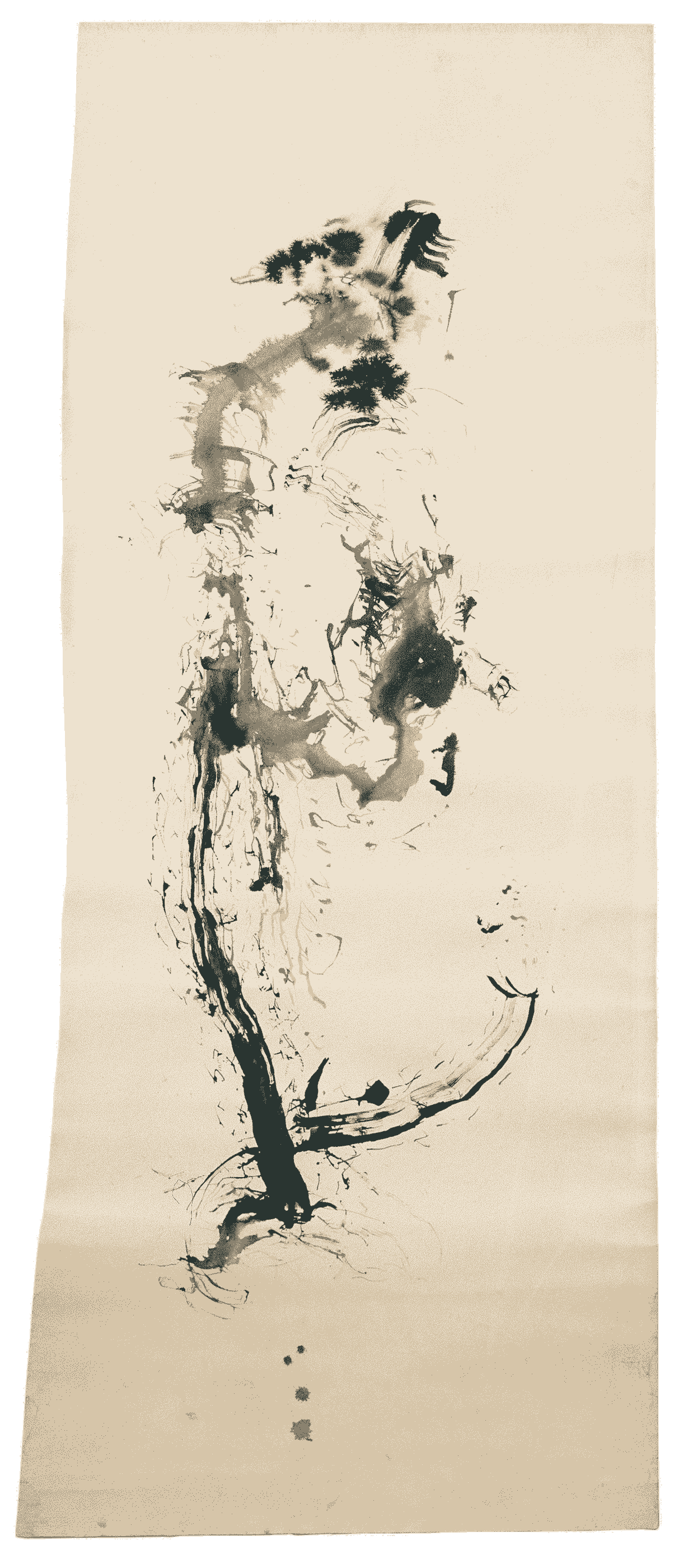
1961
Art
Creates his very first video work Hand and Face. This brief silent film captures one of the gestures Paik performed as part of the cast of Originale—its slowness and simplicity turning it into a poetic moment of meditation. The work is filmed by cameraman Wolfgang Ramsbott.
Conceptualises and begins work on Media Sandwich.
Creates Symphony for 20 Rooms which inspires the plans for his 1963 exhibition Exposition of Music—Electronic Television.
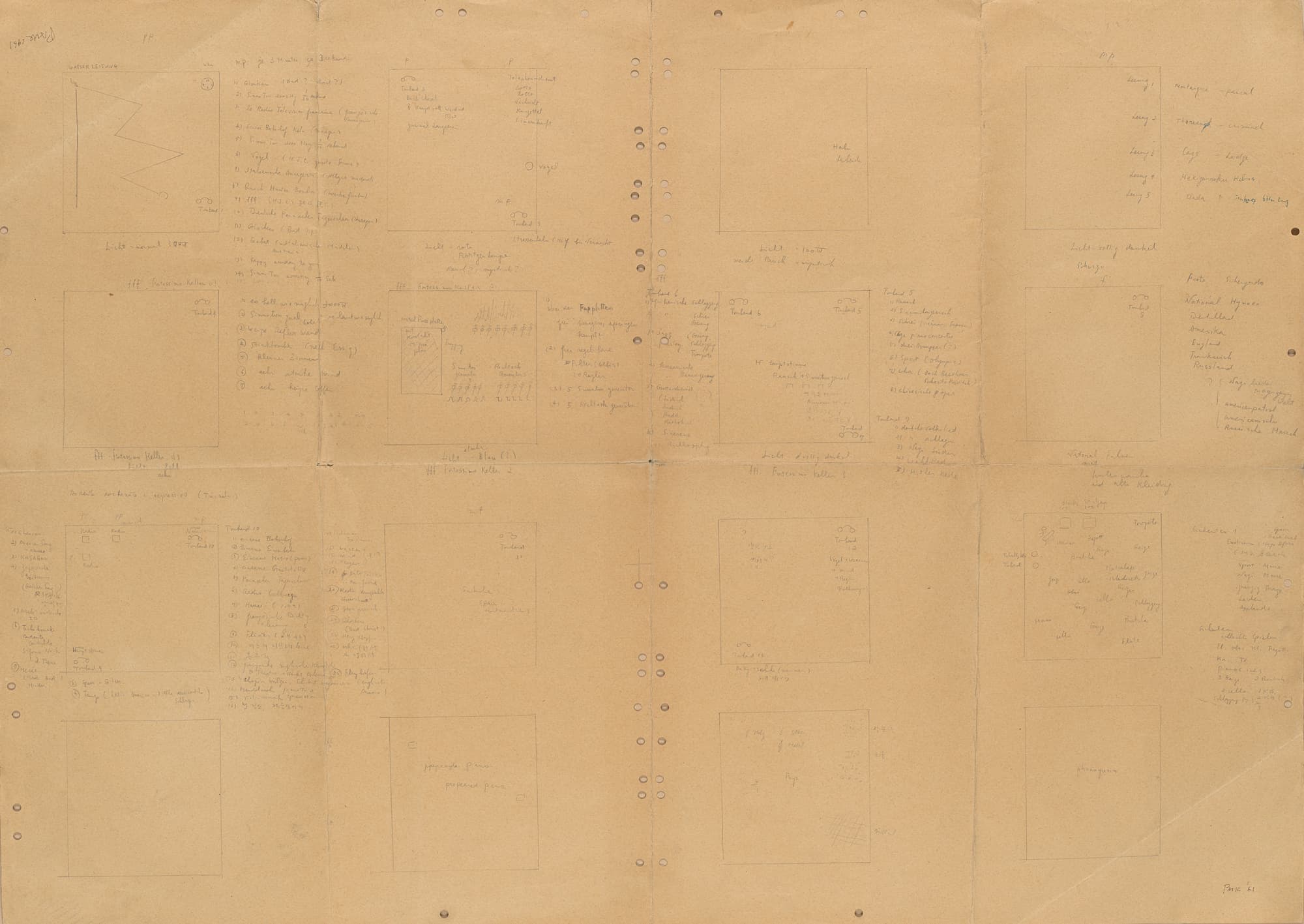
1961
Art
Studies in Musical Art publishes Paik’s article “Après Serie.”
dé-coll/age 3, the third volume of the Fluxus journal, publishes Paik’s “Exposition of Music,” “About Music,” and “Chronicle of a Beautiful Paintress” (dedicated to Alison Knowles).
1962
World
Engineer, futurist and novelist Sir Arthur C. Clarke (1917–2008) publishes Profiles of the Future: An Inquiry into the Limits of the Possible, a collection of his essays on the ultimate possibilities of the future of mankind which predict computers and the Internet. Clarke later went on to make several revised editions of this title.
The Gutenberg Galaxy: The Making of Typographic Man by Canadian philosopher Marshall McLuhan is published. It is a pioneering study in the fields of cultural studies and media ecology, in which McLuhan shares how communication technology, such as the printing press and electronic media, can affect human cognitive organisation and thus social organisation. The term “global village” is first used in this book.
Harakiri, Masaki Kobayashi’s intricate exploration of the lives led by samurais of Japan’s medieval past, is released.
1962
Biography
Meets George Maciunas (1931–1978), founder of the Fluxus movement, when Maciunas is in Europe organising and performing Fluxus actions. He is later invited to become a core Fluxus member; Maciunas made a name card for each member.
Begins collaborating with editor and artist Wolf Vostell (1932–1998) on the magazine dé-coll/age, a self-published project that captured text and images created by different Fluxus members. It begins with Europe-based circulation and expands to the US after 1964.
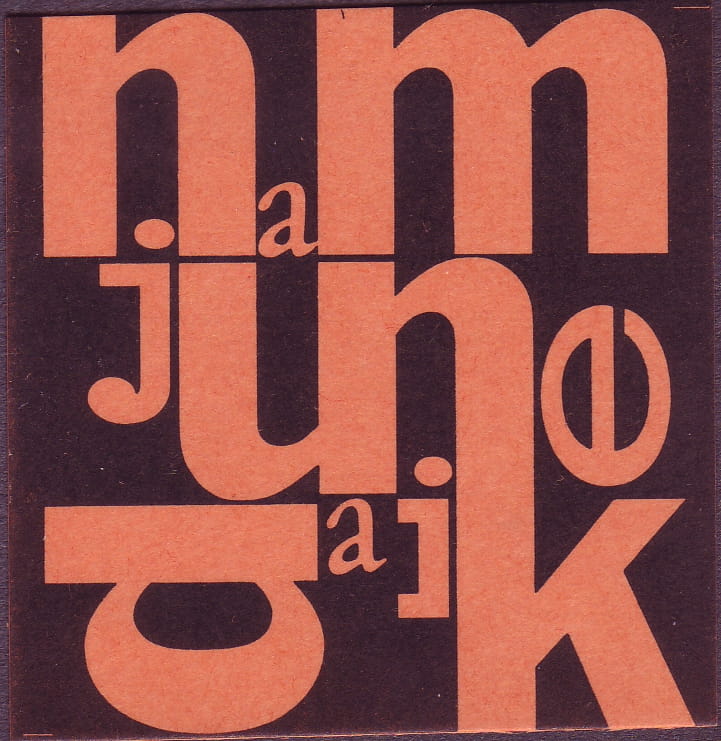
1962
Art
Begins participating in Fluxus concerts and manifestations in Europe, including:
- Kleines Sommerfest Apres John Cage (A Small Summer Festival: After John Cage) at Galerie Parnass in Wuppertal on 9 June.
- Neo-Dada in der Musik (Neo-Dada in Music) at Kammerspiele in Düsseldorf on 19 June, where Paik debuts One for Violin Solo, Sonata quasi una fantasia, Smile Gently (Étude Platonique No. 3) and Bagatelles Américaines.
- New Music programme at Kunsthadel Monet in Amsterdam where Paik performs Zen for Walking, and debuts Moving Theater No. 1 (a street performance beginning at Galerie Monet with various participants) and Serenade for Alison with Alison Knowles.
- Presentation of The music for high tower and without audience, a secret performance by Alison Knowles at the Eiffel Towers in Paris.
- At Festum Fluxorem/Musik Og Anti-Musik Det Instrumentale Teater in Copenhagen, Cage and Knowles perform two pieces composed by Paik: Theatre Piece and Serenade for Liaison respectively.
In September, Paik participates in Fluxus Internationale Festspiele neuester Musik (Fluxus International Festival of New Music) at Wiesbaden. He performs various pieces at this festival that unfolds over 4 weekends and consists of 14 unique events. A version of this festival is later presented as a Fluxus exhibition at Galerie Minami in Tokyo that same year.
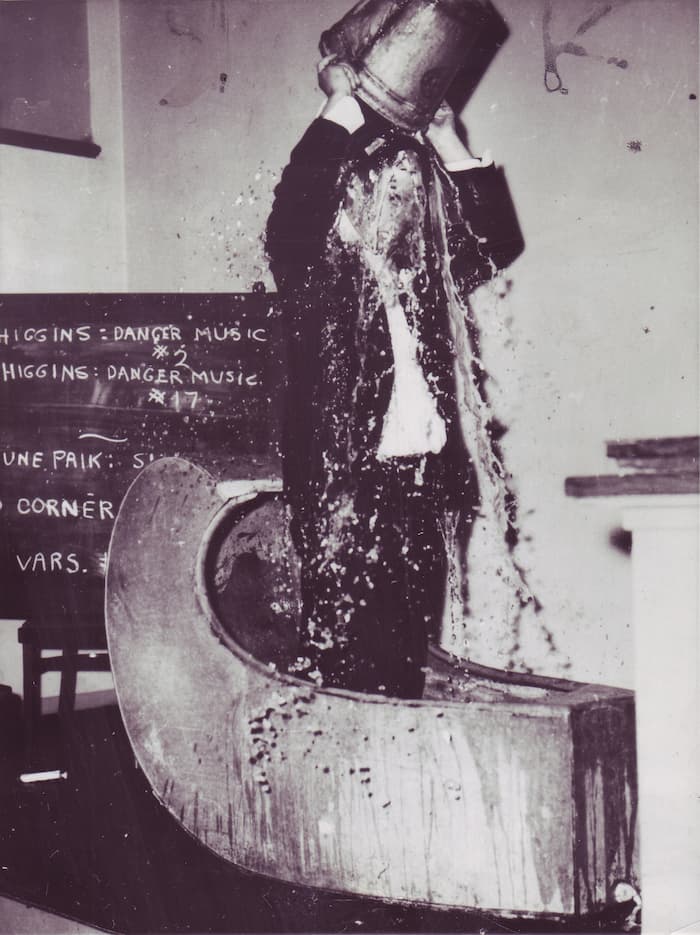
1962
Art
Conceptualises and begins work on Fluxus Island in Décollage Ocean for the fourth issue of the magazine dé-coll/age. The drawing acts as an imaginary map that represents the Fluxus art movement at this point in time, together with iconic locations in East and West Germany as well as the marked border of North and South Korea.
1962
Art
Participates in the group exhibitions Music Notation at Galerie Minami in Tokyo, and Notations at Galleria La Salita in Rome.
1963
World
US President John F. Kennedy is assassinated on 22 November.
1963
World
The first anime series adapted from the manga Astro Boy debuts on Fuji TV in Japan on 1 January. The anime series ends in December 1966 after six years of broadcast on national television. Three months of its launch in Japan, the series became the first Japanese cartoon to be broadcast in the US on the National Broadcasting Company (NBC) channel.
Dr. No, the first James Bond film, is released in October. It is adapted from the novel by Ian Fleming.
The first episode of Doctor Who, a British science fiction television series, airs on the BBC on 23 November.
Beatlemania sweeps through the UK. The term was coined by the British press in relation to The Beatles’ rise to fame, following their formation in Liverpool in the late 1950s.
1963
World
Ivan Sutherland develops Sketchpad, the first graphical computer-aided design programme that uses a light pen to create and manipulate objects in engineering drawings in real time with coordinated graphics.
1963
Biography
Purchases 13 second-hand televisions for experimentation in Germany. These are included in his solo exhibition at Galerie Parnass that year.
Returns to Tokyo during the second half of the year and begins experiments with electromagnetism and colour television.
Meets Hideo Uchida, electronics expert and owner of Uchida Radio: a shop dedicated to vintage radio equipment. Through Uchida’s introduction, Paik meets electronics engineer Shuya Abe in September. Thereafter, Paik and Abe collaborate on ways to constructs a remote-control robot from scratch that led to the creation of Robot K-456. The pair continue their collaboration and later invent ways to transform the video image.
1963
Art
Participates in Festum Fluxorem/Musik Og Anti-Musik Det Instrumentale Teater at Kunstakademie in Dusseldorf, a two-day event on 2 and 3 February. There, he performs Chair Composition and premieres Prelude in d-minor and Fluxus Champion Contest.
Debuts Piano for All Senses which is performed by T. Schmit, M. Montwé, P. Broetzman and W. de Ridder at Amstel 47 in Amsterdam.
1963
Art
Premieres interactive Action Music works and television sculptures at his solo exhibition Exposition of Music-Electronic Television such as Zen for TV, Random Access, Foot Switch Experiment, Random Access (Record Shishkebab), among many others.
Creates Can Car using two rusty oil cans, wheels of his nephew’s toy and a small functioning electric motor.
Create Postmusic in relation to the mail-art project The Monthly Review of the University for Avant-Garde Hinduism.
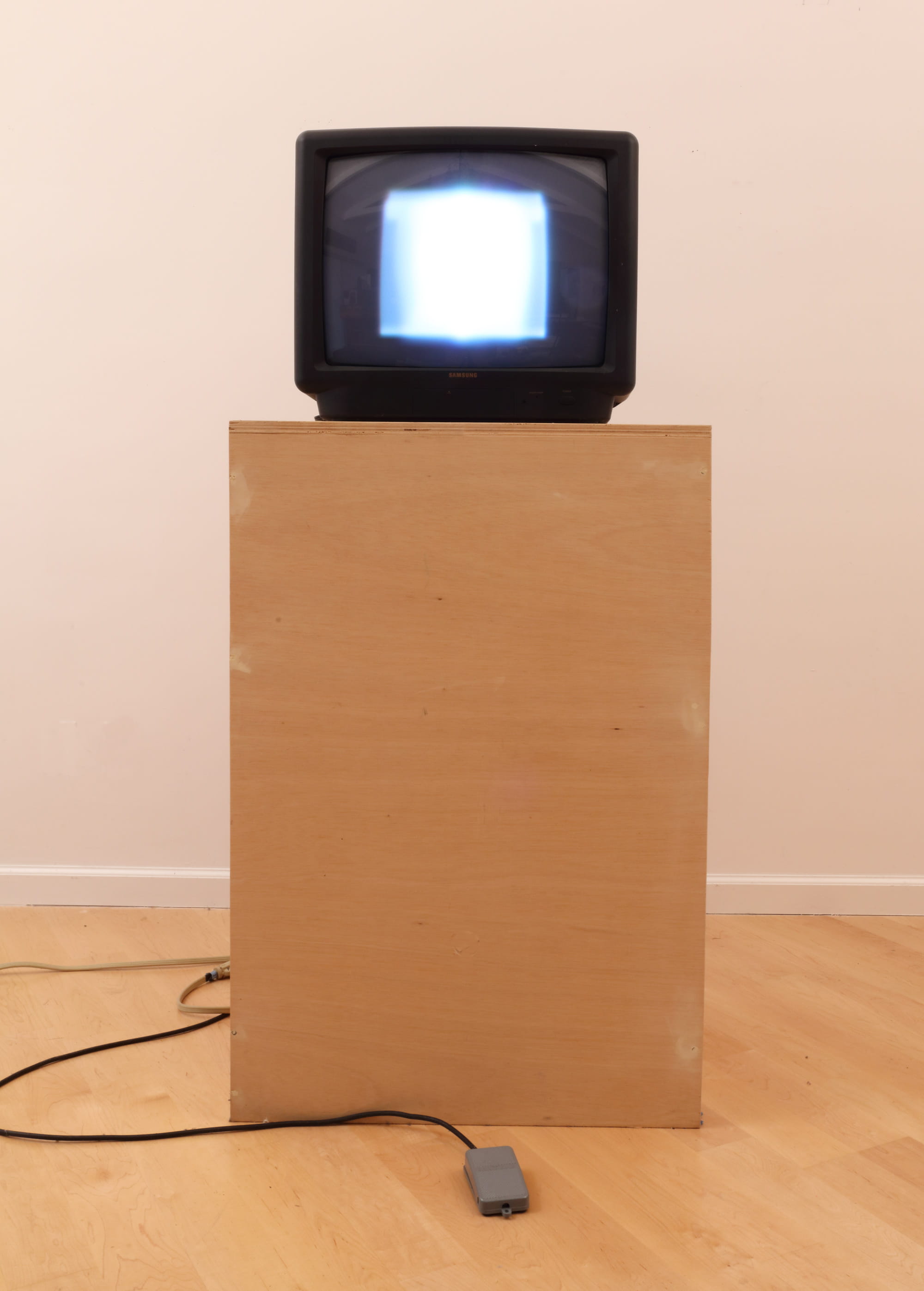
1963
Art
Presents his first solo exhibition Exposition of Music-Electronic Television held at Galerie Parnass in Wuppertal, 11–20 March. The exhibition occupies many rooms and includes 13 altered television sets, 3 prepared pianos and noisemakers; it marks the incorporation of televisions into Paik’s art making. At the exhibition, Joseph Beuys improvises an action in which he attacks one of the prepared pianos with an axe.
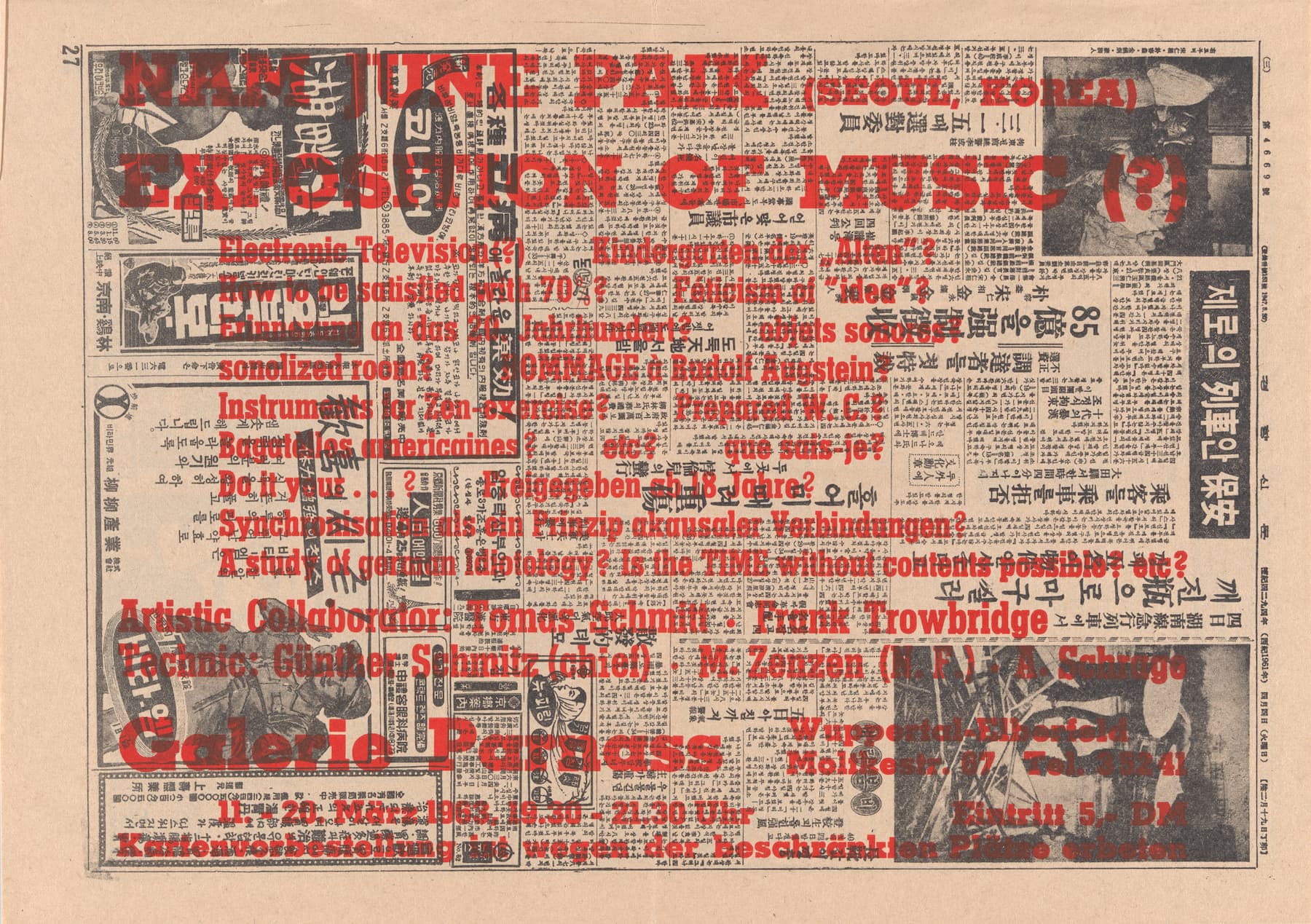
1963
Art
An Anthology of Chance Operations, an artist book edited and printed by LaMonte Young, includes Paik’s essay “To the ‘Symphony for 20 Rooms.’”
Michael Koenig’s interview with Paik, “Experimente,” is published in magnum.
1964
World
Mariner IV, a spacecraft funded by NASA, successfully completes its flyby of Mars in July and captures the first images of another planet in deep space.
China tests its first atomic bomb (codename: 596) in Xinjiang province, becoming the world’s fifth nuclear power after the US, USSR, UK and France.
1964
World
Marshall McLuhan publishes Understanding Media: The Extension of Man. It is a seminal study in media theory in which McLuhan proposes that the media itself, not the content it carries, should be the focus of study as it is the medium that will affects the society.
The Beatles begin their international expansion with a debut tour of the US, and earn their first Grammy award for Best Vocal Performance and Best New Artist. They tour the world between 1964 and 1966, with concerts in Asian venues such as Hong Kong, Japan and The Philippines.
1964
Biography
Decides to visit New York for six months after a year in Tokyo, to learn about its culture first-hand and meet with Fluxus artists he had encountered in Europe—George Maciunas and Dick Higgins. This temporary visit soon becomes a permanent relocation.
Before arriving in New York, a photograph of him taken at the International Fluxus Festival of New Music in Wiesbaden is distributed in America. His composition One for Violin Solo was also performed by George Maciunas in the Fluxus Concerts in April.
Meet Charlotte Moorman, organiser of the Annual New York Avant-Garde Festival, at the festival’s second edition. This encounter soon leads to a steadfast international collaboration where the Julliard-trained cellist plays Paik’s compositions and stages either solo or joint performance written by Paik.
1964
Art
Holds a solo recital at the Sogetsu Art Center in Tokyo as part of the Sogetsu Contemporary Series on 29 May. There, he performs Hommage à Cage: Music for Tape Recorder and Piano, Étude fur Pianoforte, Simple and La Monte’s 566 [Any Integer] for Henry Flynt.
Premieres Pop Sonata with Charlotte Moorman at Philadelphia College of Art in October.
Participates in the Monday Night Letter series with the debut of Assorted Night Riders, a performance with Alison Knowles, at Café á Go-Go in New York in November.
Carries out a secret performance with Fred Lieberman at Waikiki Beach in Honolulu, Hawaii.
Participates in the Fluxus Concert with the pieces One for Violin Solo and Picket pour la Picket, held at Carnegie Recital Hall in New York.
Participates in the Second Annual New York Avant-Garde Festival and premieres Robot Opera. This is Paik’s very first performance with Charlotte Moorman, and an American debut for Robot K-456. He also performs duet II with Charlotte Moorman and Toshi Ichiyanagi.
Performs various works at Rose Art Museum in Brandeis University, Massachusetts.
1964
Art
Creates Yellow Peril C’est moi, a handwritten note that brings together two quotes “Yellow Peril,” used by Emperor Wilhelm II to refer to threats posed to the West by the East, and “L’État c’ est moi” (I am the state), proclaiming King Louise XIV’s total rule over France.
Conceptualises and begins work on Symphony No. 5.
Creates the silent film Zen for Film.
Creates a series of works for the mail-art project Monthly Review of the University for Avant-Garde Hinduism, using a collection of leaflets and small items. Paik sends these to his contacts across the globe.
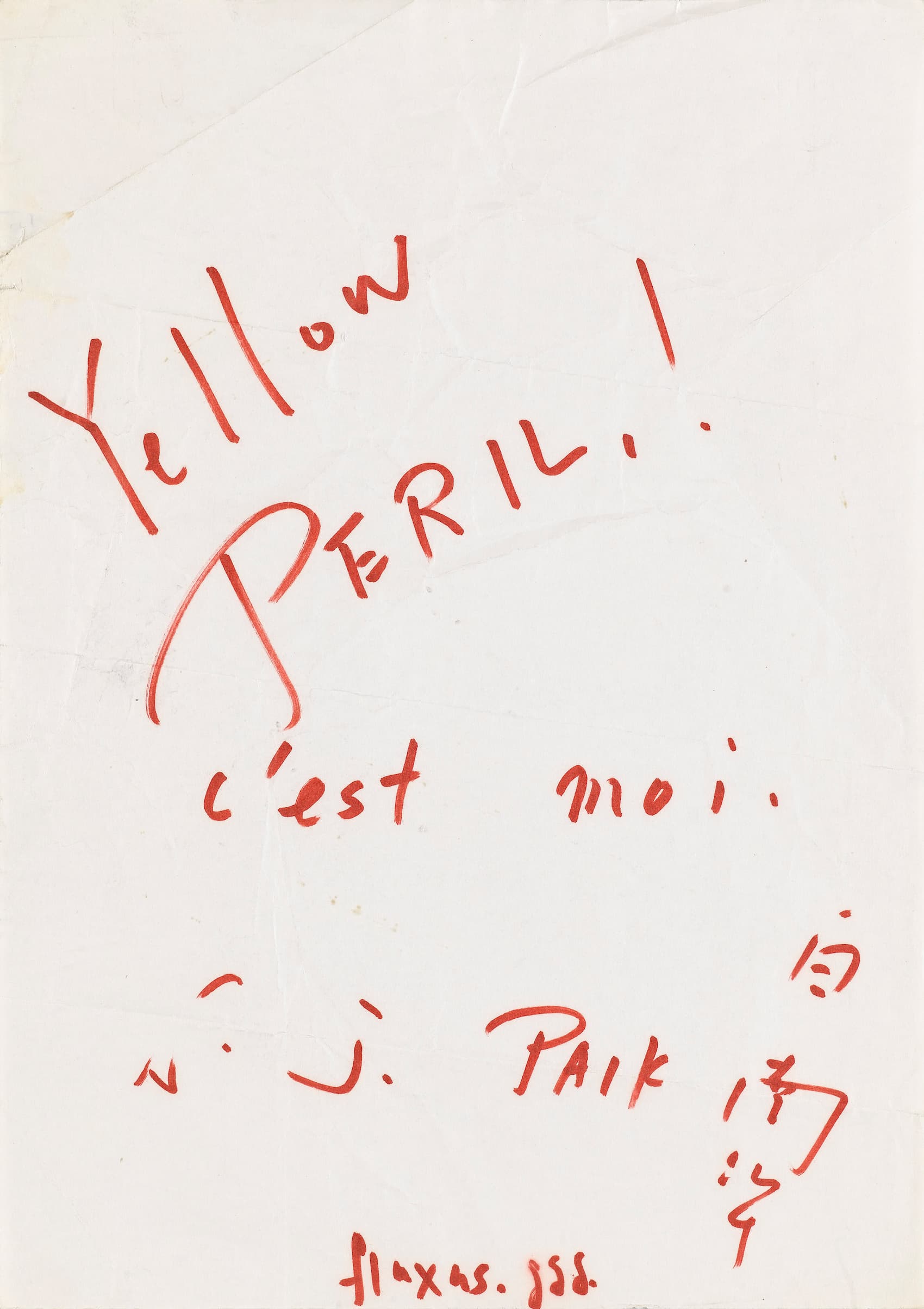
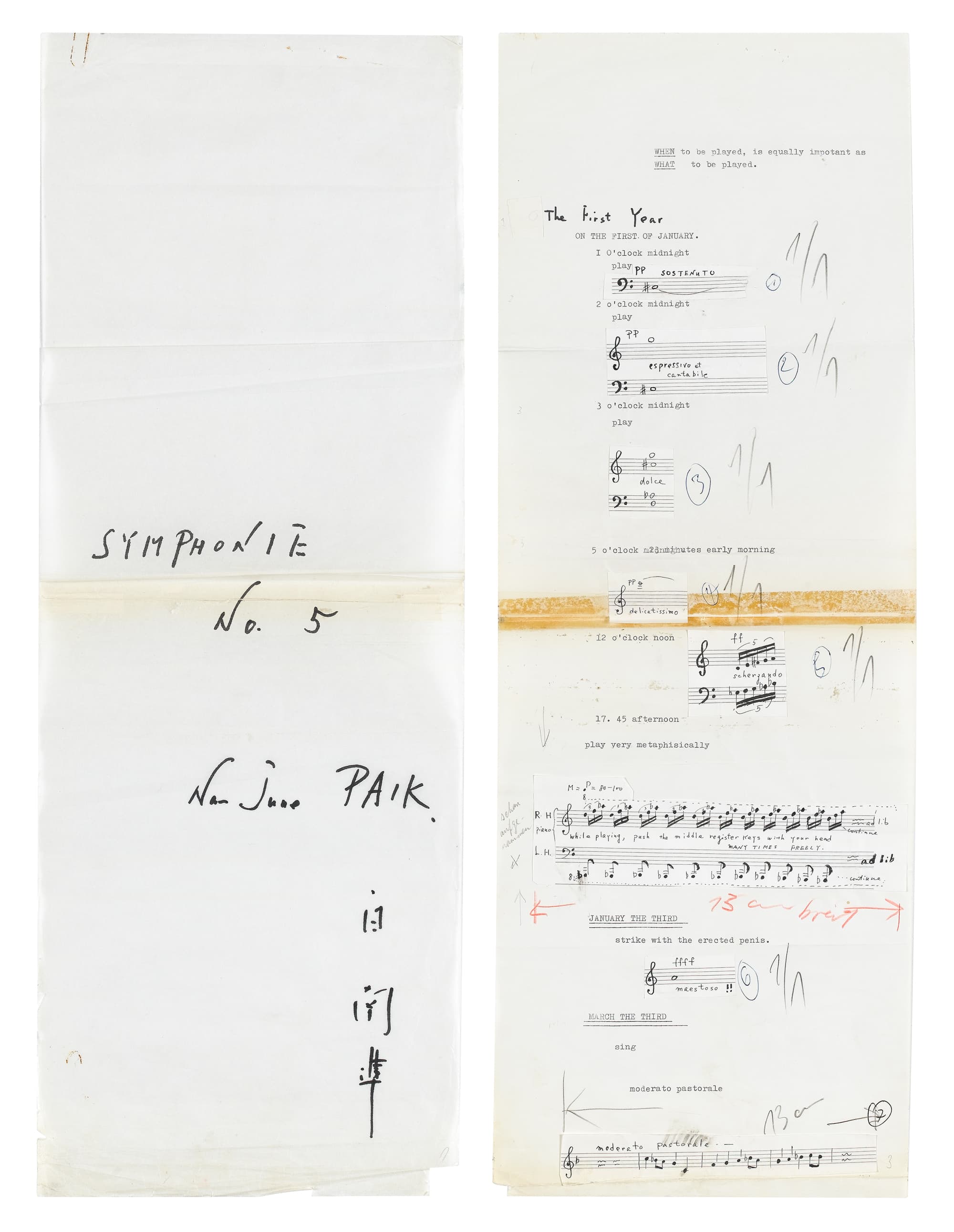
1965
World
Operation Starlight, the first offensive military action by the United States in the Vietnam War, occurs in August.
1965
World
Akira Kurosawa’s Akahige (Red Beard) is released and becomes the first-ever Asian film to be nominated for the Golden Globe’s Best Foreign Language Film that same year.
Filipino-American war drama Only the Brave Know Hell (retitled The Ravagers in the US), directed by Eddie Romero, is released
1965
World
Charles K. Kao and George A. Hockham, electrical engineers and physicists of the British company Standard Telephones and Cables (STC), first promote the idea of using fibre optics in telecommunications.
1965
Biography
Purchases his first transportable video recorder in October.
Becomes the legal guardian of his nephew Ken Hakuta when Hakuta arrives in New York from Japan at the age of 14.
1965
Art
Premieres Sonata for Adults Only with Charlotte Moorman at the New School for Social Research, New York. This work requires Moorman to perform a striptease while playing a solo Bach cello piece. Paik also premieres Zen Box & Zen Can, performs his American premiere of Color TV, 10 Black & White TV’s and 11 Performers and has three robots (K-456, T-7 and Miss Sarah) perform Robot Opera.
Premieres Variations on a Theme by Saint-Saëns with Charlotte Moorman and also performs their interpretation of John Cage’s 26’1.1499” at Philadelphia College of Art.
Performs various works with Charlotte Moorman at Music Nova, a new music event held in Reykjavik.
Performs Étude Platonique, Simple and Variations on a Theme by Saint-Saëns with Charlotte Moorman at Festival de la Libre Expression (Festival for Free Expression), a festival for avant-garde art at the American Artists Center in Paris.
Performs Sonata for Adults Only with Charlotte Moorman at Galerie Swirner in Cologne.
Performs various works with Charlotte Moorman at University of Frankfurt.
Performs Étude Platonique, Simple and Variations on a Theme by Saint-Saëns with Charlotte Moorman at Technische Hochschule, Aachen.
Participates in 24 Stunden, a 24-hour happening-event at Galerie Parnass in Wuppertal, where he performs Robot Opera with Charlotte Moorman and Robot K-456.
Performs Étude Platonique, Simple, Variations on a Theme by Saint-Saëns, Violin Solo and Cello Sonata No.1 (for Adults Only) with Charlotte Moorman at Kaiser Wilhelm Memorial Church as part of the Siebetre Soiree: Fluxus Concert organised by Galerie René in West Berlin.
Participates in the Third Annual New York Avant-Garde Festival and performs Variations on a Theme by Saint-Saëns with Charlotte Moorman. Paik also performs John Cage’s Theatre Piece.
Performs Electronic Video Recorder at Cafe au Go Go, World Theatre in New York.
Performs Zen for Film No. 1 (Realised by Fluxus), Zen for Film No. 2 (Dedicated to Fluxus) combined with Étude Platonique at New Cinema Festival I, organised by Filmmakers’ Cinemathque in New York. Video Tape Essay No. 1 is also on display.
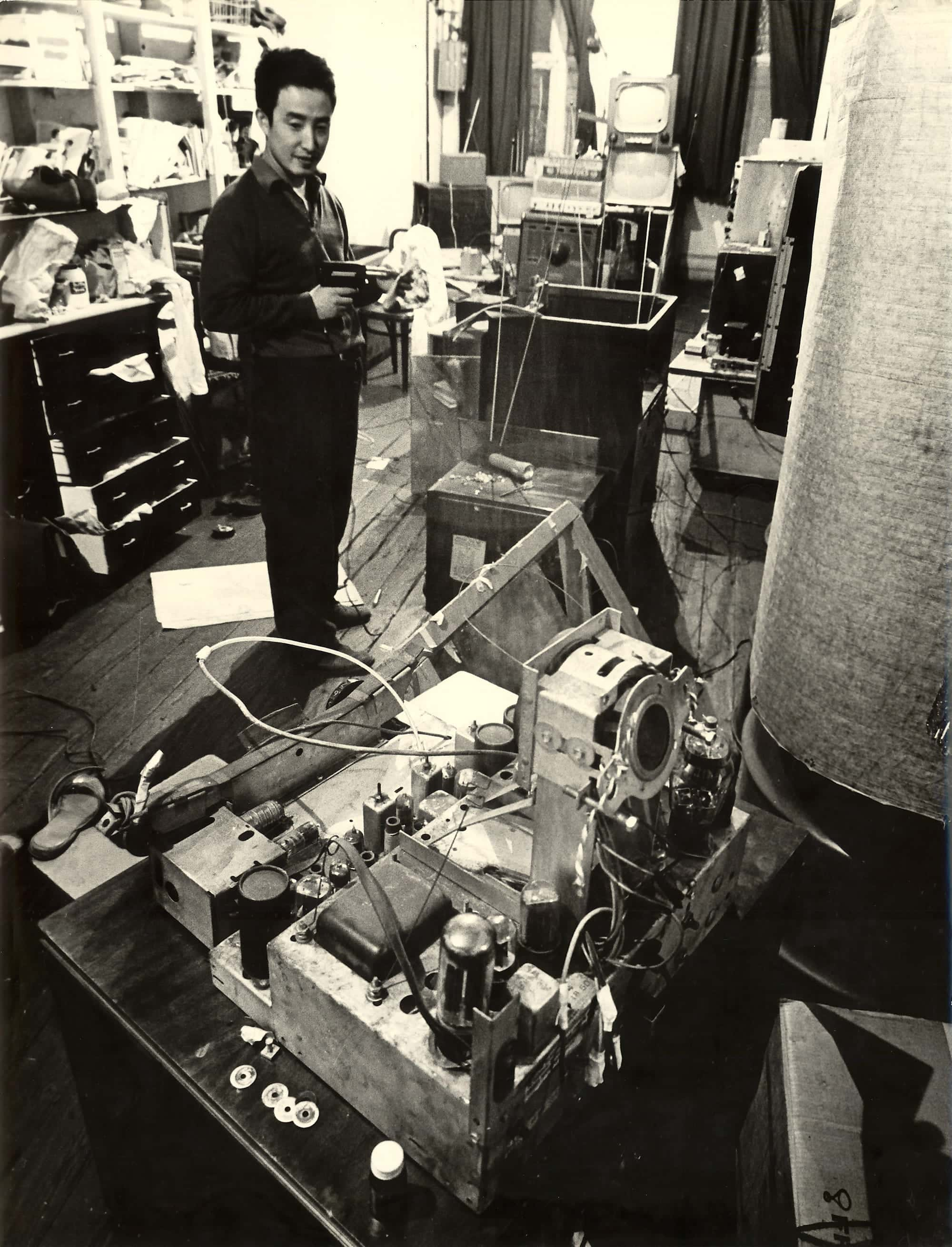
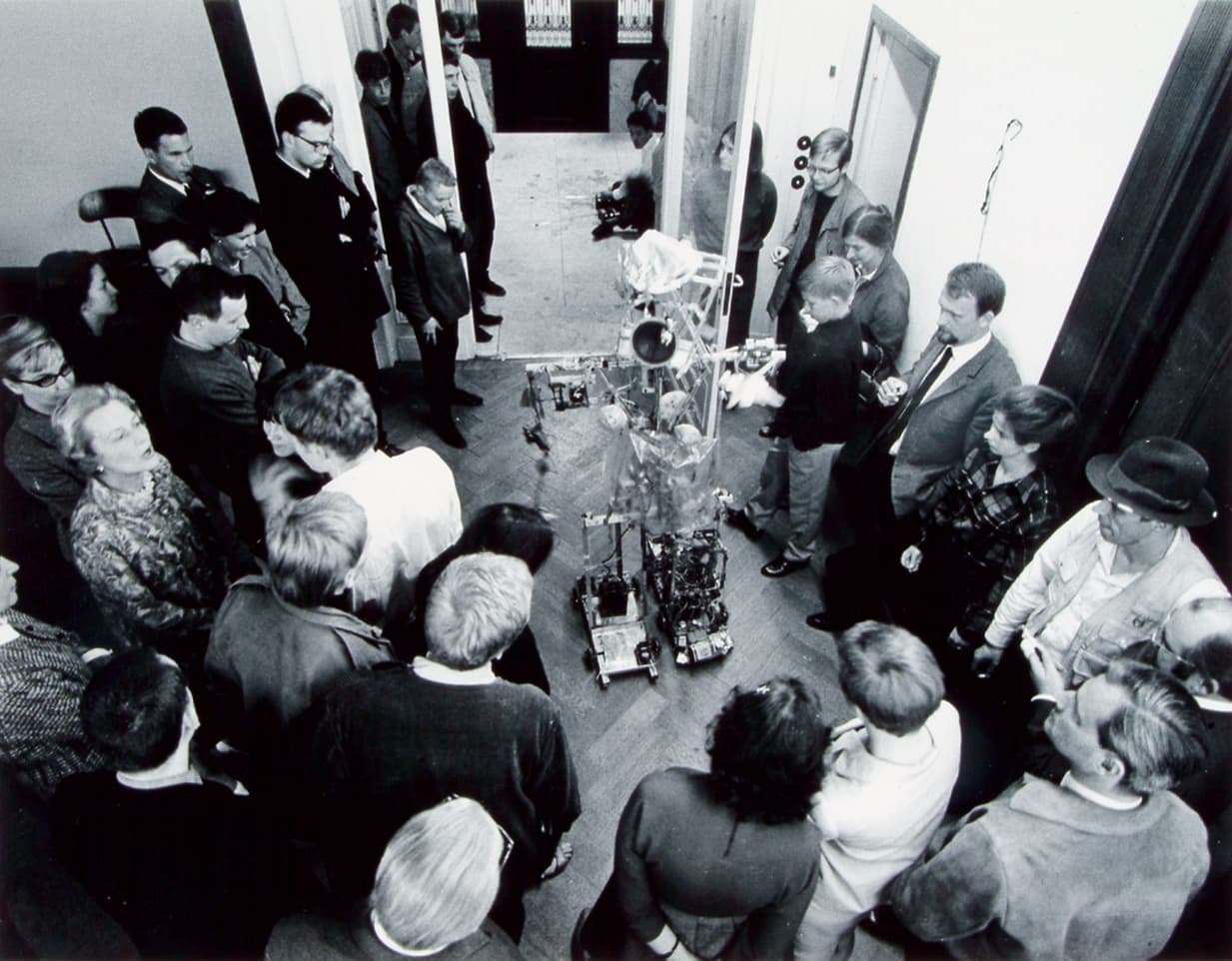
1965
Art
Shows his first videotape work at Cafe au Go Go in New York, comprising footage of Pope Paul VI’s visit to New York.
Premieres his video works Videotape Essay No. 1, Zen for Film, and Variations on a Theme by Robert Breer (which captures Moorman and Breer’s film Fist Fight) at New Cinema Festival I.
Creates Magnet TV using magnets to easily distort the images on the television screen, encouraging viewers to actively interact with his work without needing technical skills.
Conceptualises and begins work on TV Crown and Moon is the Oldest TV.
Begins collaborating with Jud Yalkut on the silent film Electronic Fables (1965–1971) and Early Color TV Manipulations (1965–1968).
Creates the silent video work Button Happening. This is Paik’s earliest videotape, recorded on the day he acquired his first Portapak camera
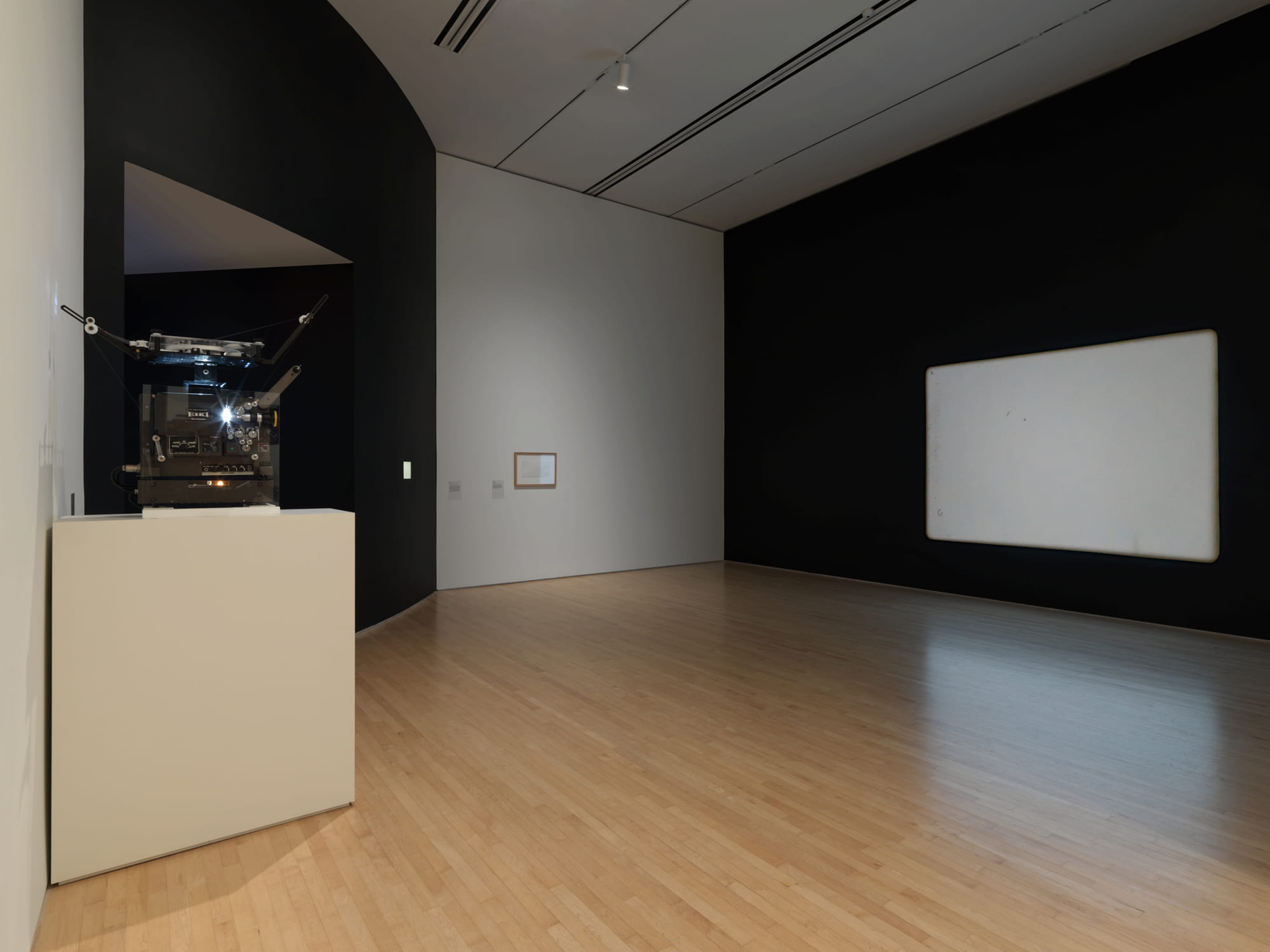
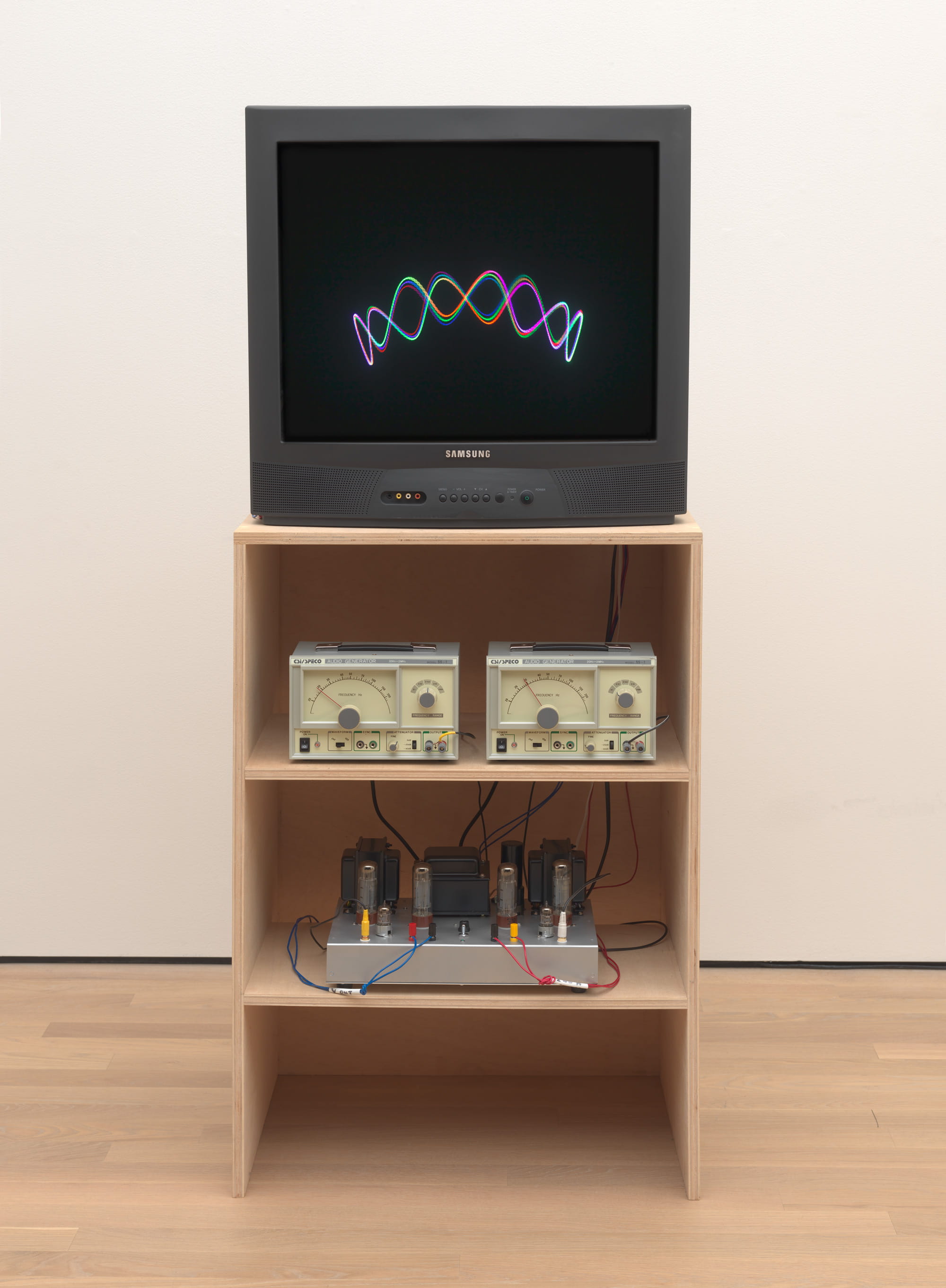
1965
Art
Presents a solo exhibition titled Electronic Art held at Galeria Bonino in New York, 23 November–11 December. Paik launches his first videotaped recorder installation at this exhibition.
Participates in group exhibition Art Turned On held at the Institute of Contemporary Art in Boston, 10 December–10 January 1966.
Presents a solo exhibition titled NJ Paik: Electronic TV, Color TV Experiments, 3 Robots, 2 Zen Boxes & 1 Zen Can at New School for Social Research in New York. It features a group performance by Paik, Robot K-456 and Charlotte Moorman in a second edition of Robot Opera.
1965
Art
The exhibition catalogue 24 Stunden (24 Hours) publishes Paik’s essay “Pensée 1965.”
1966
World
Star Trek: The Original Series, an American science fiction television series created by Gene Roddenberry, premieres on NBC in the US on 8 September.
1966
Biography
Connects with computer scientist Max Mathews, the then director of Bell Labs, to pursue an opportunity to use their computing technology for his experiments in electronic art. This led to the creation of Digital Experiment at Bell Labs (1966–1967), a computer-generated monochromatic silent animation, and several other paper-based artworks.
1966
Art
Performs John Cage’s 26’1.1499 for a String Player and Variations on a Theme by Saint-Saëns with Charlotte Moorman as part of their Gondola Happening at Ponte Rialto in Venice. This is the second time the duo have presented John Cage’s 26’1.1499 for a String Player; they go on to perform this piece in upcoming projects.
Performs Variations on a Theme by Robert Breer with Charlotte Moorman at Filmmaker’s Cinematheque evening programme Towards More Sensible Boredom in New York.
Performs Variations on a Theme by Saint-Saëns with Charlotte Moorman at Galerie Zwirner in Cologne.
Performs the premiere of As Boring as Possible with Charlotte Moorman and Johann Sebastian Bussotti with Malcolm Goldstein at Forum Theatre and Galerie René Block in West Berlin.
Performs Simple and Johann Sebastian Bussotti solo, As Boring as Possible, Cello Sonata No.1 for Adults Only and Cello Sonata Opus 69 with Charlotte Moorman at Technische Hochschule in Aachen. Paik also premieres Opéra Sextronique with Charlotte Moorman at this venue.
Performs Variations on a Theme by Saint-Saëns and various other works with Charlotte Moorman at Goethe University in Frankfurt.
Performs Étude Platonique No. 3 solo, and Variations on a Theme by Saint-Saëns and Cello Sonata No. 1 for Adults Only with Charlotte Moorman at Galerie Parree in Copenhagen.
Performs Johann Sebastian Bussotti with Malcolm Goldstein at the Continuous Performances of New Music event organised by Kirkland House Music Society in Harvard University, Massachusetts.
Performs Action Music, possibly including Zen Smiles, at the 4th Annual New York Avant Garde Festival at the Central Park Conservatory Pond in New York.
Performs Zen for Head (Paik’s version of La Monte Young’s Composition 1960 #10 [to Bob Morris]) at Koncert Fluxu (Fluxus Concer) in Prague, Klub Umeleu and other locations.
Performs various works with Charlotte Moorman at the following venues: Libreria Feltrinelli in Rome, Staatliche Kunstakademie in Dusseldorf, Pistol Teatern in Stockholm and the Eastern U.S. Physicists Conference held in the Rhode Island School of Design, Providence.
1966
Art
Debuts his first multi-monitor installation TV Cross at “Visions of Today”, part of the Art and Technology symposium by the Museum of Technology in Stockholm.
Creates Dieter Rot on Canal Street and Variations on Johnny Carson vs Charlotte Moorman. They both comprise black-and-white footage, and neither of them are in circulation.
Conceptualises and begins work on Digital Experiment at Bell Labs. This was the only digital work Paik made as the digital process was too slow for him and did not provide what he wanted; henceforth, Paik switches to the analogue process, which later led to the creation of the Paik-Abe Video Synthesizer.
Collaborates with Jud Yalkut on the short film Beatles Electroniques from 1966–1969 with sound by Kenneth Lenner, as well as the short films Cinema Metaphysique No. 1 from 1966–1972, P+A-I (K) in 1966 and the short silent film Etude in Black et Noire in 1966.
Creates Life Ring 66, a hand-held magnetic coil that can be used to interfere with images on CRT television sets, manipulating the displays on screen.
1966
Art
Participates in the group exhibition Kinetic and Programmed Art held at the Rhode Island School of Design’s Art Museum in Providence, 25 November–4 December.
1966
Art
Fylkingen Bulletin International: Art and Technology II, a Swedish periodical, publishes Paik’s “Experiments with Electronic Pictures.”
1967
World
Canadian philosopher Marshall McLuhan’s bestseller The Medium Is the Massage: An Inventory of Effects is published. He reinforces the idea that all media are extensions of our human senses, bodies and minds—an idea that first appeared in The Gutenberg Galaxy in 1962.
1967
Biography
Becomes artist-in-residence at the State University of New York, Stony Brook College, through an invitation from Alan Kaprow. This comes about after the directors of the Rockefeller Foundation’s Art Program, Norman Lloyd and Howard Klein, become interested in Paik’s work.
Receives a generous grant from the Rockefeller Foundation for his video research and begins working with more electronics, including magnetically distorted television imagery.
1967
Art
Performs Opéra Sextronique with Charlotte Moorman at Filmmaker’s Cinematheque in New York on 9 February. The performance is interrupted by New York City Police Department officers who arrest Moorman for “indecent exposure.” The case was tried in court where the judge found her guilty. The conviction impacted Moorman’s relationship with her family as well as her status as an approved classical cellist in New York. According to her defence lawyer Jerald Ordover, Moorman’s nudity was not an act of obscenity but a rebellious act to promote freedom of expression. Following the conviction, Moorman is known as the “topless cellist” in the media and public.
Performs Opéra Sextronique with Charlotte Moorman at Philadelphia College of Art.
Performs Variations on a Theme by Saint-Saëns with Charlotte Moorman, assisted by Takehisa Kosugi and Emmett Williams in This is Marshall McLuhan: The Medium is the Message on NBCTV, Channel 4 in New York.
Performs Variations No. 2 on a Theme by Saint-Saëns with Charlotte Moorman on The Merv Griffin Show on WENEWTV, Channel 5 in New York.
Performs at Takehisa Kosugi Music Expanded with Takehisa Kosugi and Charlotte Moorman at Town Hall in New York.
Performs various works with Charlotte Moorman at Black Gate Theatre in New York.
Premieres solo Check or Money Order and Amelia Earhart in Memoriam with Charlotte Moorman at the Fifth Annual New York Avant-Garde Festival held on a ferry taking the Staten Island Ferry route at Upper New York Bay. Paik also performs Electronic Television and Video Tape Study with Charlotte Moorman.
Debuts solo Cutting My Arm at Judson Gallery in New York. He also performs various works with Charlotte Moorman at the premiere.
Performs One for Violin Solo and Simple, as well as Variation No. 2 on a Theme by Saint-Saëns with Charlotte Moorman in Mixed Media Opera at the University of Massachusetts in Amherst.
1967
Art
Creates Variations on George Ball on Meet the Press. It comprises black-and-white footage, and is not in circulation.
Begins collaboration with Jud Yalkut between 1967 and 1969 on the short films Video Tape Study No. 3 and Cinema Metaphysique Nos. 2, 3 and 4 which include sound by David Behrman and Kenneth Lerner, the film Electronic Moon, Parts 2 and 3 which includes sound by Glenn Miller, and the silent films Missa of Zen and Cinema Metaphysique No. 5.
1967
Art
Presents solo exhibition Expanding Perceptions in the Arts held at the Art Center of the Pail Klapper Library, Queens College of The City University of New York, 20–22 March.
Participates in the group exhibition Light/Motion/Space held at Walker Art Center in Minneapolis, 8 April–21 May, which later travels to Milwaukee Art Center (June 24–July 30).
Participates in the group exhibitions Festival of Light and Light in Orbit held at Howard Wise Gallery in New York, as well as The Artist as Filmmaker held at The Jewish Museum in New York.
Presents a solo exhibition Nam June Paik held at Stony Brook Art Gallery, Stony Brook College, State University of New York.
1968
World
Martin Luther King Jr. is assassinated on 2 April. Two days later, massive riots break out across the United States that last until 14 April.
The My Lai Massacre occurs in May in South Vietnam. The US Army violates, tortures and kills countless local civilians, the majority of whom are women, children and the elderly. This incident becomes public knowledge a year later through a series of photographs by war photographer Ronald L. Haeberle.
1968
World
Artist Andy Warhol and art critic-curator Mario Amaya are shot by writer Valerie Solanas in New York on 3 June.
1968
Art
Performs various works with Charlotte Moorman at event Intermedia 68 held at the State University of New York, College of New Paltz and other locations in New York State.
Performs Arias No. III and IV and Simple solo, and Opéra Sextronique, Variations on a Theme by Robert Breer and Varitions No. 2 on a Theme by Saint-Saëns with Charlotte Moorman as part of Mixed Media Opera at New York’s Town Hall.
Performs various works with Charlotte Moorman at the Spring Arts Festival in University of Cincinnati.
Premieres One for Radio and performs Cutting My Arm, Hair as part of DIAS—Destruction in Art Symposium at Judson Gallery in New York. He also performs various works with Charlotte Moorman.
Performs Opéra Sextronique (European premiere) with Charlotte Moorman at Lidelraum in Dusseldorf.
Performs in the 6th Annual New York Avant Garde Festival at a parade on Central Park West in New York.
Performs Variations on a Theme by Saint-Saëns and various works with Charlotte Moorman at Avant-Garde Music at the ICA: First London Concert with Charlotte Moorman and Nam June Paik and Back by Popular Demand: 2nd London Concert at Nash House Auditorium in London.
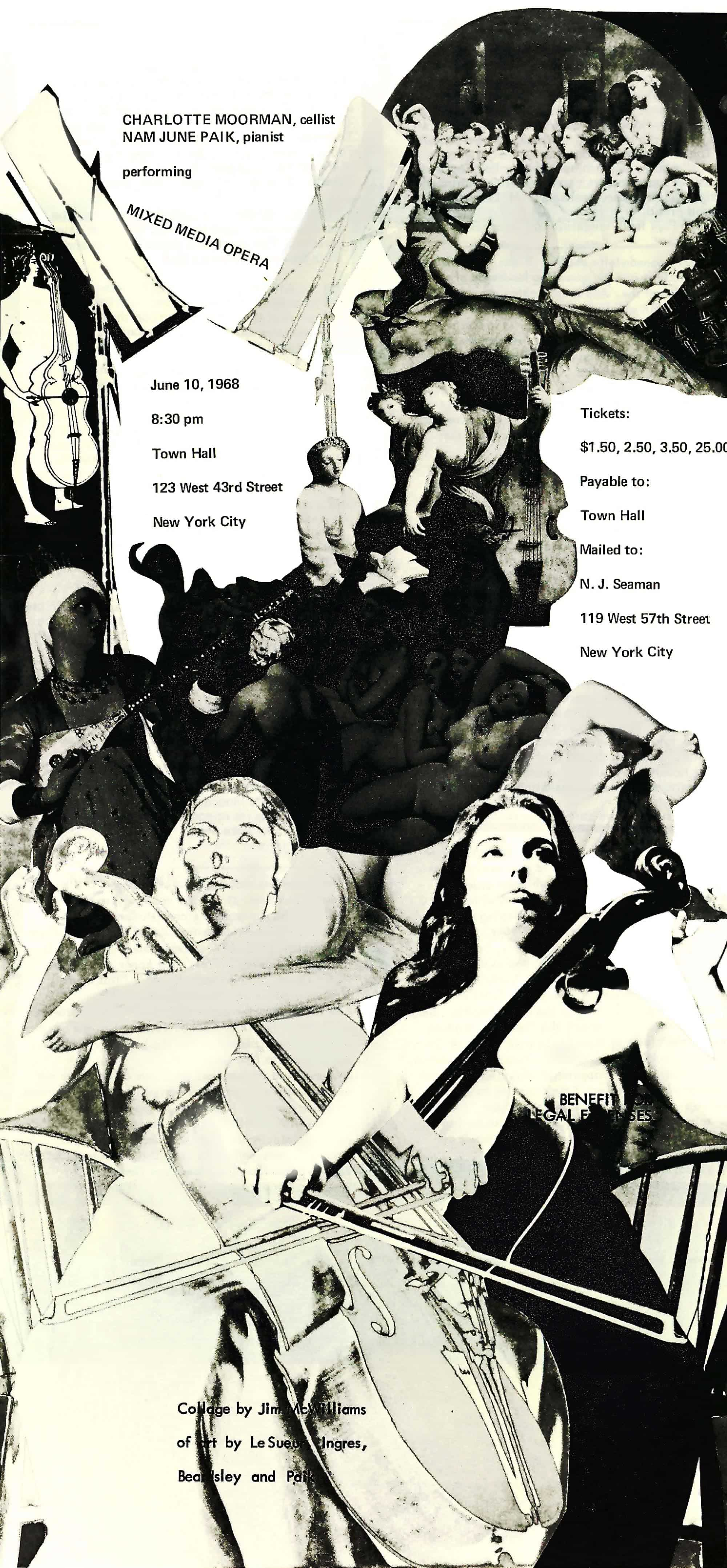
1968
Art
Creates TV Chair, a video sculpture that critiques how video technologies will become so ingrained in our daily lives that they will blend into our living environments, taking the form of video furniture and video walls.
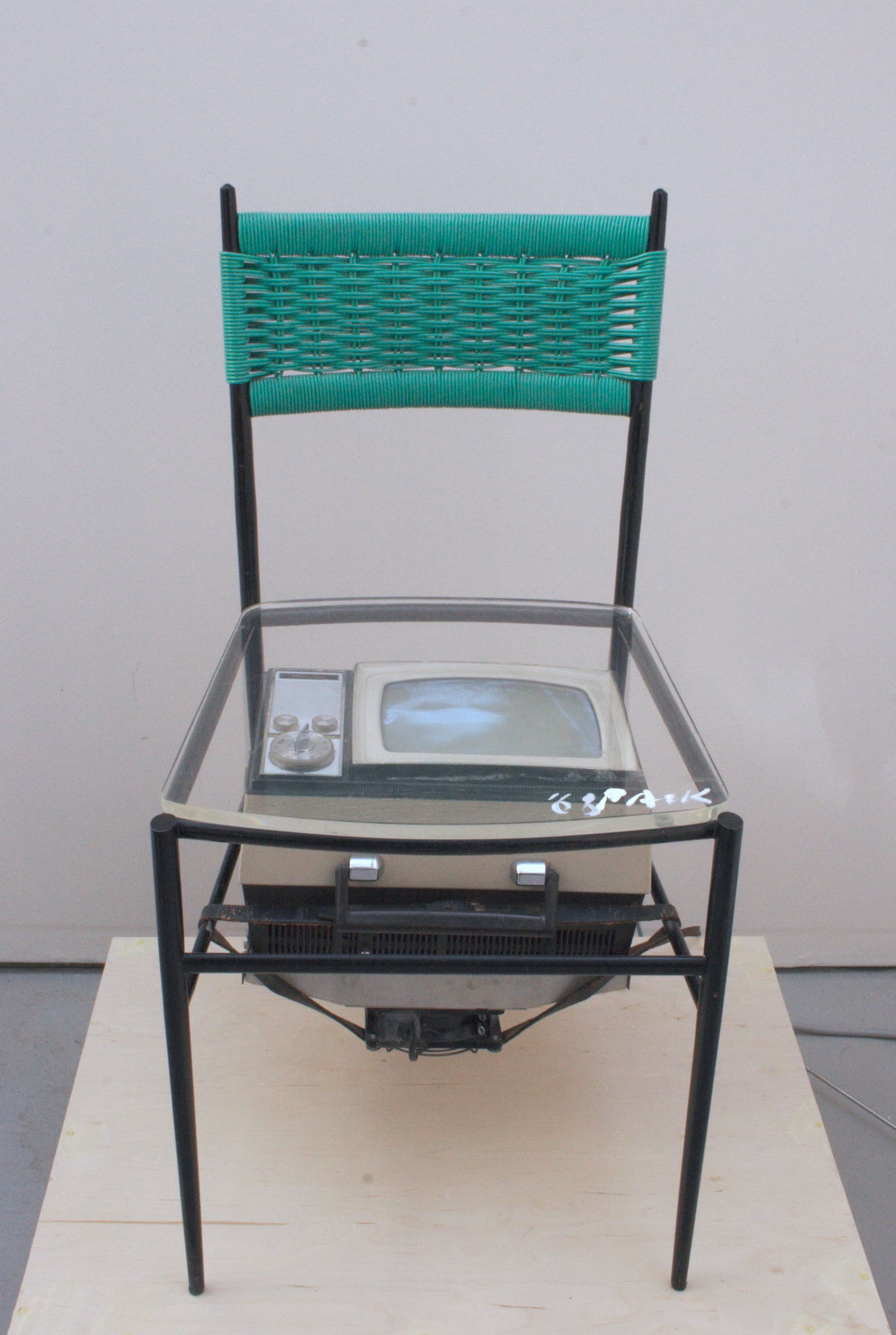
1968
Art
Participates in the group exhibition Art in Edition: New Approaches held at the Pratt Center for Contemporary Printmaking and Loeb Student Center in New York University, 8–31 January.
Presents a solo exhibition Nam June Paik, held at Stony Brook Art Gallery, Stony Brook College, State University of New York, 1–15 March.
Presents a solo exhibition Electronic Art II held at Galeria Bonino in New York, 17 April–11 May.
Participates in the group exhibition Sammlung Hahn: Zeitgenössische Kunst (Wolfgang Hahn Collection) held at Wallraf-Richartz Museum in Cologne, 3 May–7 July.
Participates in the group exhibition Cybernetic Serendipity: The Computer and the Arts organised by the Institute of Contemporary Art in London, 20 August–20 October, which later travels to The Corcoran Gallery of Art in Washington D.C., 16 July–31 August 1969, and the Palace of Art and Science in San Francisco, fall of 1969.
Participates in the group exhibition The Machine: As Seen at the End of the Mechanical Age held at The Museum of Modern Art in New York, 25 November–9 February 1969, which later travels to University of St. Thomas in Houston 25 March–18 May 1969, and the San Francisco Museum of Modern Art, 23 June–24 August 1969.
1968
Art
Jud Yalkut’s interview of Paik, “Art and Technology of Nam June Paik,” is published in Arts Magazine in April.
Le Daily-Bul La Louvière 12, a Belgian periodical, publishes Paik’s “Answer to Question Qui êtes vous?” (Answer to Question Who Are You?).
1969
World
In July, the US launches Apollo 11 carrying astronauts Neil A. Armstrong and Edwin E. Aldrin Jr., who become the first humans to walk on the moon. It is broadcast worldwide on television, receiving the highest viewership ratings ever recorded.
1969
World
ARPANET (Advanced Research Projects Agency Network), the first wide-area packet-switched network with distributed control, implements the TCP-IP protocol suite and successfully sends a message across four interconnected computers in the US. This becomes a foundational step in the birth of the Internet in the 1990s.
1969
Art
Premieres Participation TV and TV Bra for Living Sculpture with Charlotte Moorman, as part of the group exhibition TV as a Creative Medium held at Howard Wise Gallery in New York.
Premieres Sonatine for Fish and Three Korean Girls and Wind at the Seventh Annual New York Avant-Garde Festival held on Wards Island in New York.
Performs Variations No. 2 on a Theme by Saint-Saëns with Charlotte Moorman and debuts Piano Sonata solo as part of the adjunct programmes for the exhibition Art by Telephone, held at the Museum of Contemporary Art in Chicago.
Debuts Action for René Block at Galerie René Block in West Berlin.
Creates Untitled, a collage of a photograph of Moorman wearing TV Bra for Living Sculpture taken by Peter Moore and a Japanese ink painting that captures a woman playing the koto (Japanese zither).
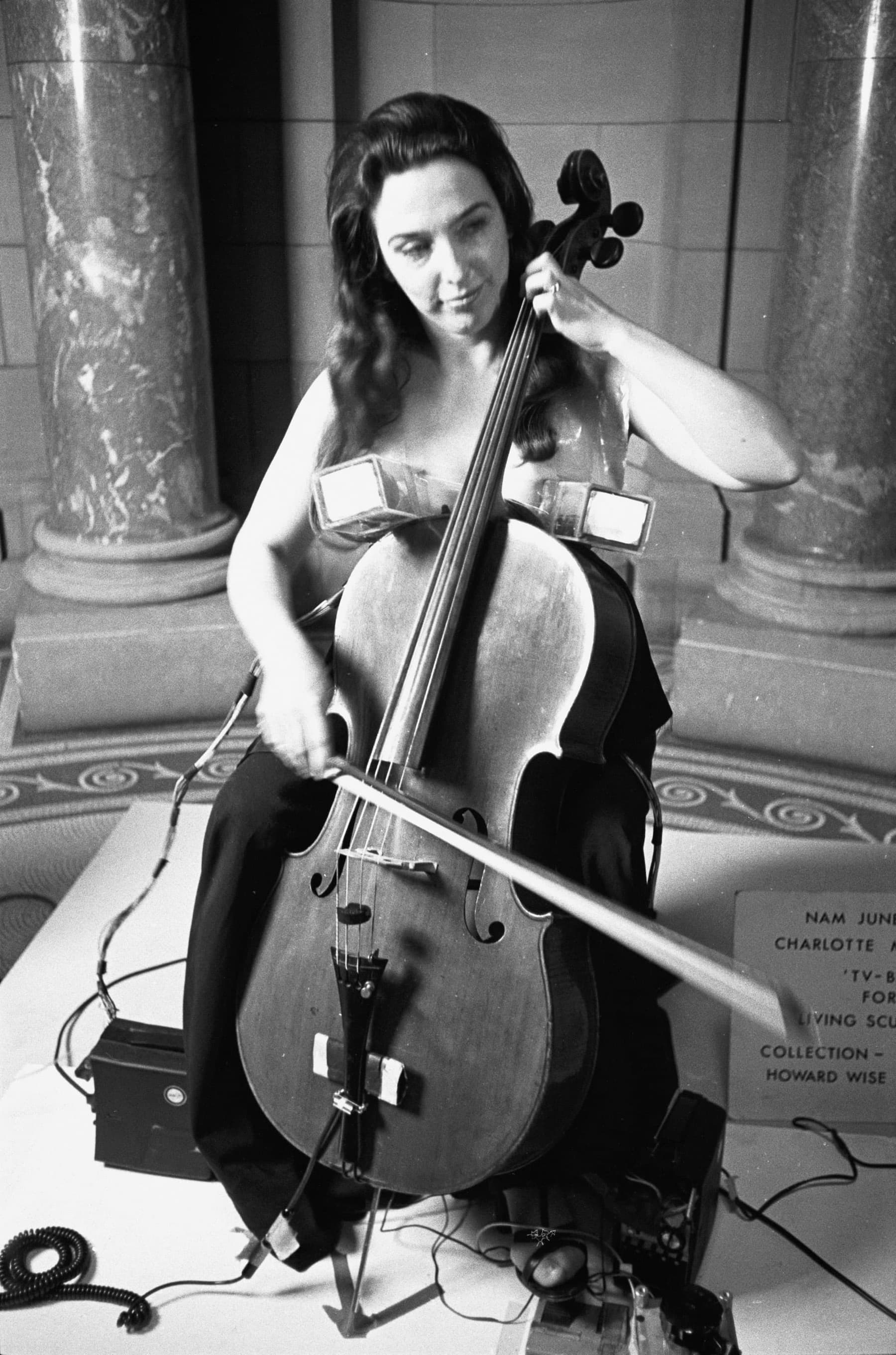

1969
Art
Creates Participation TV II and TV Bra for Living Sculpture. The latter is Paik’s first attempt to humanise electronics and technology.
Creates Electronic Opera #1, a short, coloured video with sound, and debuts it live on the television programme The Medium is the Medium, produced at the Public Broadcasting Laboratory in association with WGBH-TV Boston and WNET-TV/Channel 13 New York. The broadcaster invites the six visual artists Allan Kaprow, Nam June Paik, Otto Piene, James Seawright, Thomas Tadlock and Aldo Tambellini to create original works for the programme. The Medium is the Medium was one of the earliest examples of collaboration between public television and the emerging field of video art in the US.
Creates 9/23/69 Experiment with David Atwood, an 80-minute coloured video collage of pure electronic abstractions, live TV broadcasts, pre-recorded material and images recorded at the Public Broadcasting Laboratory and produced by the New Television Workshop at WGBH, Boston.
Conceptualises and begins experimentations to create Three Camera Participation/Participation TV. Prior to creating Three Camera Participation, Paik had made a few works titled Participation TV where the image was distorted or modulated in real time by audio signals, such as sounds picked up by a microphone.
Collaborates with Jud Yalkut on the short film Electronic Moon No. 2 which includes a Claude Debussy soundtrack.
1969
Art
Participates in the group exhibition Electronic Art held at the University of California’s Art Galleries in Los Angeles, 19 January–21 March.
Participates in the group exhibition TV as a Creative Medium held at Howard Wise Gallery in New York, 17 May–14 June.
Participates in the group exhibition New Ideas, New Materials held at The Detroit Institute of Arts, 10 September–19 October.
1969
Art
Notations, a book edited and compiled by John Cage and Alison Knowles and first published by Something Else Press, includes Paik’s essay “Destroying All Nations.”
Kalendar ’69: Electronic Art, a Fluxus publication published in Dusseldorf, includes Paik’s article “Über Pussy TV.”
1970s
1970
World
The first Earth Day is observed on 22 April in the US, where senator Gaylord Nelson rallies students to take a stand and combat climate change.
On 23 July, US President Richard Nixon approves a plan to greatly expand domestic intelligence-gathering by the Federal Bureau of Intelligence, Central Intelligence Agency and other agencies.
In September, Operation Tailwind, a covert incursion into south-eastern Laos by the US Army Special Forces and the Military Assistance Command Vietnam Studies and Observations Group, occurs.
189 countries sign the Nuclear Non-Proliferation Treaty, including the five with nuclear weapons: the US, USSR, UK, France and China. India, Israel, Pakistan, and North Korea did not partake in this treaty.
1970
World
The musical genres of rock, R&B and psychedelia rise in prominence, and new albums are released by musical legends such as The Beatles, The Bee Gees, The Rolling Stones, The Doors, Stevie Wonder, Aretha Franklin and David Bowie.
1970
World
The first dot matrix printer LA30 is introduced to the public consumer market by the Digital Equipment Corporation of Maynard.
The Ford Pinto, Hillman Avenger and Nissan R383 are launched in the US, France and Japan respectively.
Optical fibre is successfully developed by Corning Glass Works in the US.
1970
Biography
Works closely with Shuya Abe between 1969 and 1970 to create a video-synthesizer which can be used to process and manipulate videotaped images. This later becomes a patent invention that is adopted by a few broadcasting companies, and is commonly known as the Paik-Abe Synthesizer.
1970
Art
Performs TV Bra for Living Sculpture with Charlotte Moorman as part of the group exhibition Vision and Television at the Rose Art Museum, Brandeis University in Massachusetts.
Performs TV Bra for Living Sculpture with Charlotte Moorman as well as New Piece for Charlotte and TV as part of Festum Fluxorum (Fluxus Festival) at the Forum Theater in Berlin.
1970
Art
Creates Video Commune (Beatles beginning to end), a four-hour improvised montage of distorted television imagery accompanied by songs by The Beatles. This video work is presented live on WGBH–TV Boston on 1 August to unveil the Paik-Abe Synthesizer. A shortened version was later made for exhibition display.
Creates video work Electronic Opera #2 as part of the television programme Video Variations hosted by Russell Connor, which airs on WGBH–TV Boston. The work features the Boston Symphony Orchestra.
1970
Art
Participates in the group exhibition Vision and Television held at the Rose Art Museum, Brandeis University in Massachusetts, 21 January–22 February.
Participates in the group exhibition Happening and Fluxus held at Kölnischer Kunstverein in Cologne, 6 November–6 January 1971.
1970
Art
The Jewish Museum publishes Paik’s “Confessions of a ‘Cafe Revolutionary,’ May 1969” in their exhibition catalogue Software. Brandeis University’s Rose Art Museum also publishes Paik’s “The Most Profound Medium” in the exhibition catalogue Vision and Television.
Paik’s articles “Generation Collage” and “Seven Billion Dollars” appear in the journals KLEPHT and Arts in Society respectively.
1971
World
A series of battles and operations between American and Viet Cong troops unfold as part of the Vietnam War.
Willy Brandt, a German statesman, receives the Nobel Peace Prize for improving relations between East Germany, Poland and the USSR.
1971
World
The John F. Kennedy Center for the Performing Arts opens in Washington DC on 8 September.
1971
World
The first coin-operated video game computer, Galaxy Game, is released and installed at Stanford University in September.
1971
Biography
Works in the Television Laboratory (TV LAB) of the station WNET in New York, an experimental division of Channel 13/WNET public television which operates from 1971 to 1984.
TV LAB was initially funded by the Rockefeller Foundation and the New York State Council on the Arts at the urging of Paik, who wanted a place for artists to create new imagery on television with provided resources. TV LAB offered artists the latest equipment to create what became the new global phenomena of video art, and encouraged writers, directors, choreographers and animators to experiment and innovate. Howard Weinberg has produced a 95-minute film Nam June Paik & TV Lab: License to Create in 2014 and it debuted at the Asia Society New York the same year.
1971
Art
Premieres Concerto for TV Cello and Videotapes, Paik/Abe Video Synthesizer and TV Glasses with Charlotte Moorman as part of the solo exhibition Electronic Art III held at Galeria Bonino in New York. The WNET–TV Television Workshop captures the performance of Paik/Abe Video Synthesizer with Charlotte Moorman, which is used as media coverage and later for exhibition display.
Performs Everything You Always Wanted To Know about TV and [Were] Afraid To Do with Shuya Abe as part of the 8th Annual New York Avant Garde Festival at the 69th Regiment Armory in New York.
1971
Art
Creates several works including Chroma Key Bra, Chroma Key Glasses, TV Cello and TV Eyeglasses that are used in live performances with Charlotte Moorman.
Collaborates with Jackie Cassen on the video work Paik/Abe Synthesizer with Charlotte Moorman which features Moorman with the sculptural works TV Cello and TV Eyeglasses; the video component relies on the Paik-Abe Synthesizer to create video footage. The show is produced by the Artists’ Television Workshop at WNET/Thirteen in New York.
1971
Art
Presents a solo exhibition Electronic Art III: Paik-Abe Video Synthesizer with Charlotte Moorman held at Galeria Bonino in New York, 23 November–11 December.
Presents collections of short films made in collaboration with Jud Yalkut at various locations in New York: Hit and Run Screening of Video Films at the Rizzoli Screening Room, Video Film Concert at the Millennium Film Workshop and Cineprobe at The Museum of Modern Art.
Participates in the group exhibition Sonsbeek: Beyond Its Bounds in Arnheim, an annual Dutch outdoor exhibition that focuses on monumental sculptures in dialogue with the landscape. This edition of Sonsbeek renewed the concepts of sculpture and traditional exhibition formats by introducing film and video works.
Participates in the group exhibition St. Jude Video Invitational held at De Saisset Art Gallery and Museum, University of Santa Clara, California.
Participates in the group exhibition Videoshow, organised by The New American Filmmakers Series at Whitney Museum of American Art, New York. This is the museum’s first videotape exhibition.
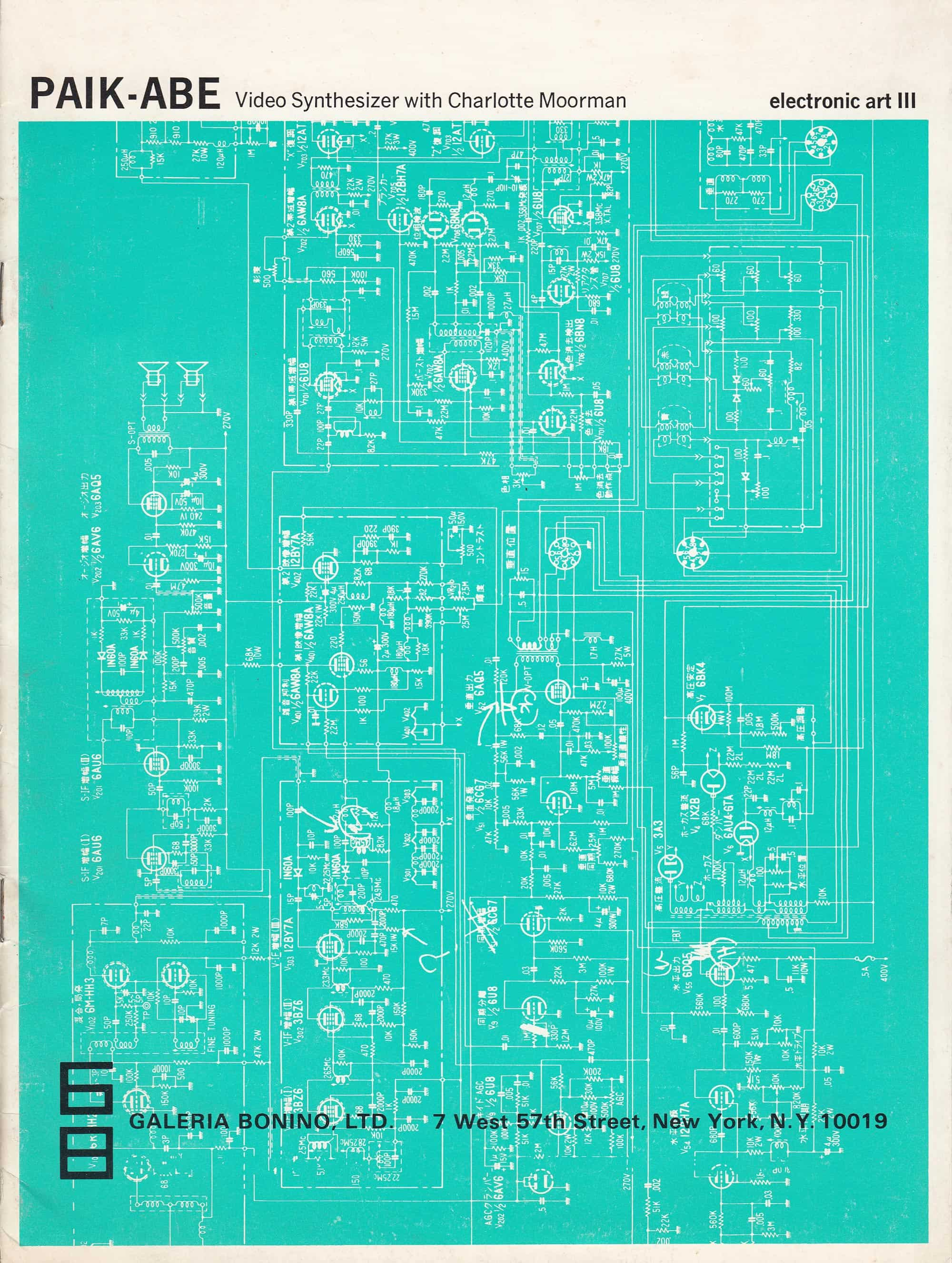
1971
Art
Galeria Bonino publishes Paik’s text in the exhibition catalogue for Electronic Art III: Paik-Abe Video Synthesizer with Charlotte Moorman.
DuMont Schauberg publishes Paik’s essay “Video Commune” in P.C.A.
1972
World
Another series of battles and operations unfold between American and Viet Cong troops in relation to the Vietnam War.
From 21–28 February, US President Richard Nixon conducts an official eight–day visit to the People’s Republic of China to meet its leaders, including Mao Zedong and Zhou Enlai.
1972
World
Stanley Kubrick’s satirical film adaptation of Anthony Burgess’ 1962 dystopian novel A Clockwork Orange is released.
1972
Biography
The 12-minute documentary Name June Paik with Charlotte Moorman and David Ross at the Version Museum from Ithaca Public Television is released.
1972
Art
Performs Concerto for TV Cello and Videotapes and TV Bra for Living Sculpture with Charlotte Moorman as part of the group exhibition Experimental Television Center, Binghamton held at Everson Museum of Art in New York.
Premieres TV Bed with Charlotte Moorman and debuts TV Penis at Live Video, an event organised by and held at The Kitchen, Mercer Arts Center in New York.
Performs Concerto for TV Cello and Videotapes, and TV Bed with Charlotte Moorman at the Ninth Annual New York Avant–Garde Festival on the riverboat Alexander Hamilton and at the South Street Seaport Museum.
1972
Art
Creates The Selling of New York with Ed Emshwiller, a 7–minute video made as part of the television programme Video Variations. This video work later becomes part of a new video work in 1975 titled Suite 212.
Creates Waiting for Commercials with Jud Yalkut, a video work produced at WNET-TV/Channel 13 New York.
1972
Art
Screens Waiting for Commercials at The Kitchen, Mercer Arts Center in New York, 5 January.
Participates in Cineprobe: An Evening with Jud Yalkut and Nam June Paik at The Museum of Modern Art in New York, 18 April.
Participates in the group exhibitions Twelfth Annual October St. Jude Video Invitational: Videotapes and Experimental Television Center, Binghamton, both held at the Everson Museum of Art in Syracuse, New York.
1972
Art
The periodicals Flash Art and The Village Voice publish Paik’s articles “Nam June Paik & Charlotte Moorman” and “Ken Dewey 1934–1972” in May and August respectively.
DuMont Schauberg and Radio Bremen publish Paik’s letters “Communication and Art of Communicating as Art” and “Two Letters to Hans Otte” in the book Kunst-Praxis Heute (Art Practice Today) and the festival programme collateral for Pro Musica Nova respectively.
Paik’s “Memories of Munich” are published in Neue Musik: Music / Film-Slides-Light Festival Special Issue for Arts Program of the 1972 Olympic Games in Munich, and his “My Symphonies” (which include his first five symphonies) appear in Source/Music of the Avant-Garde 2.
1973
World
Former U.S. Secretary of State Henry A. Kissinger and North Vietnamese Politburo Member Le Duc Tho receive the Nobel Peace Prize, although Le declines acceptance.
1973
World
The Sydney Opera House, designed by Danish architect Jørn Utzon, is completed. It receives the Pritzker Prize in 2003 and becomes a UNESCO World Heritage Site in 2007.
Rainer Werner Fassbinder releases Ali: Fear Eats the Soul in West Germany, which pays tribute to American director Douglas Sirk.
1973
World
Xerox Parc creates Xerox Alto, the first computer that incorporates text-based hyperlinks and uses a Graphical User Interface (GUI) as the main interface. Most modern general-purpose GUIs are derived from this system. Apple, Digital Research, IBM and Microsoft also use this to develop their products.
The first commercial handheld mobile phone is produced by Motorola in the US.
1973
Art
Performs with Charlotte Moorman and the Yoshi Wada Band at The Kitchen, Mercer Arts Center in New York.
Performs with Charlotte Moorman at Concert for Piano and Cello, an event held at Smith Music Hall, University of Illinois in Champaign–Urbana.
Debuts Fluxus Sonata I at 80 Wooster Street in New York.
Premieres Train Cello with Charlotte Moorman at the Tenth Annual New York Avant-Garde Festival held at Grand Central Station in New York. Together, they also perform several pieces including Concerto for TV Cello and Videotapes and TV Bra for Living Sculpture.
Performs Étude Platonique Nr. 5, One for Violin Solo and Simple solo, and Sonata No. 1 for Adults Only, Opera Sextronique and Variations on a Theme by Saint-Saëns with Charlotte Moorman as part of Suhen um zu Hören (Seeking to Hear) at Städtische Kunsthalle in Düsseldorf.
1973
Art
Creates A Tribute to John Cage: an hour-long video broadcast on WNET-TV/Channel 13 that collages footage of Cage’s performances and anecdotes, interviews with friends and colleagues, and examples of Paik’s participatory music and television works that parallel Cage’s strategies and concerns. A 30–minute revision is later produced in 1976.
Creates Global Groove, a 30–minute video work made in collaboration with John Godfrey at WNET-TV/Channel 13 TV Lab.
1973
Art
Participates in the group exhibition Cremer Collection: European Avant-Garde 1950–1970 held at Kunsthalle Tübingen, 31 March–6 May.
Participates in the group exhibition Circuit: A Video Invitational held at Everson Museum of Art in New York, 27 April–27 May.
Presents the solo exhibitions Electronic Video and Videotapes from the Perpetual Pioneer of Video Art held at The Kitchen, Mercer Arts Center in New York.
Participates in the group exhibition New York Collection for Stockholm held at Moderna Museet in Stockholm.
1973
Art
Moderna Museet publishes Paik’s essay “TV Chair” in the exhibition catalogue for New York Collection for Stockholm.
Douglas Davis’ interview of Paik, “Nam June Paik: The Cathode-Ray Canvas,” is published in Art and The Future, A History/ Prophecy of the Collaboration Between Science, Technology and Art.
1974
World
India tests its first atomic bomb (codename: Smiling Buddha) in Rajasthan on 18 May and becomes the world’s sixth nuclear power.
Richard M. Nixon resigns from the US presidency in August, while facing potential impeachment for his involvement in the Watergate scandal.
The Battle of Phuoc Long between South and North Vietnamese troops begins in December.
1974
Biography
The documentary A Conversation featuring Joseph Beuys, Douglas Davis and Nam June Paik, and videotaped by Bill Viola, is released.
1974
Art
Launches live-transmission work Global Groove on television network WNET-Channel 13 in New York in January.
Performs Sans Video: Music for Merce Cunningham with the Merce Cunningham Dance Company at Westbeth in New York.
Performs Concerto for TV Cello and Videotapes with Charlotte Moorman as part of the exhibition Project ’74–Aspects of International Art in the Early 1970s at Kunsthalle Köln and Kölnischer Kunstverein in Cologne. The exhibition is staged to mark the 150th anniversary of the Wallraff–Richartz–Museum.
Debuts Fluxus Sonata II at the Anthology Film Archives in New York.
Performs TV Bra for Living Sculpture with Charlotte Moorman at Kirkland House Junior Common Room, Harvard University in Cambridge, Massachusetts. Paik, Moorman and the audience also view Tribute to John Cage broadcast by WGBH Channel 2.
Performs Voice-Video Interface with Russell Connor, colourises Street Sentence by Doug Davis and collaborates with Jud Yalkut to create Progress Report on Suite 212 for the 2nd International Computer Art Festival at The Kitchen, Mercer Arts Center in New York.
Performs Paper Sculptures and Video Study #2 at the 11th Annual Avant Garde Festival of New York at Shea Stadium in New York.
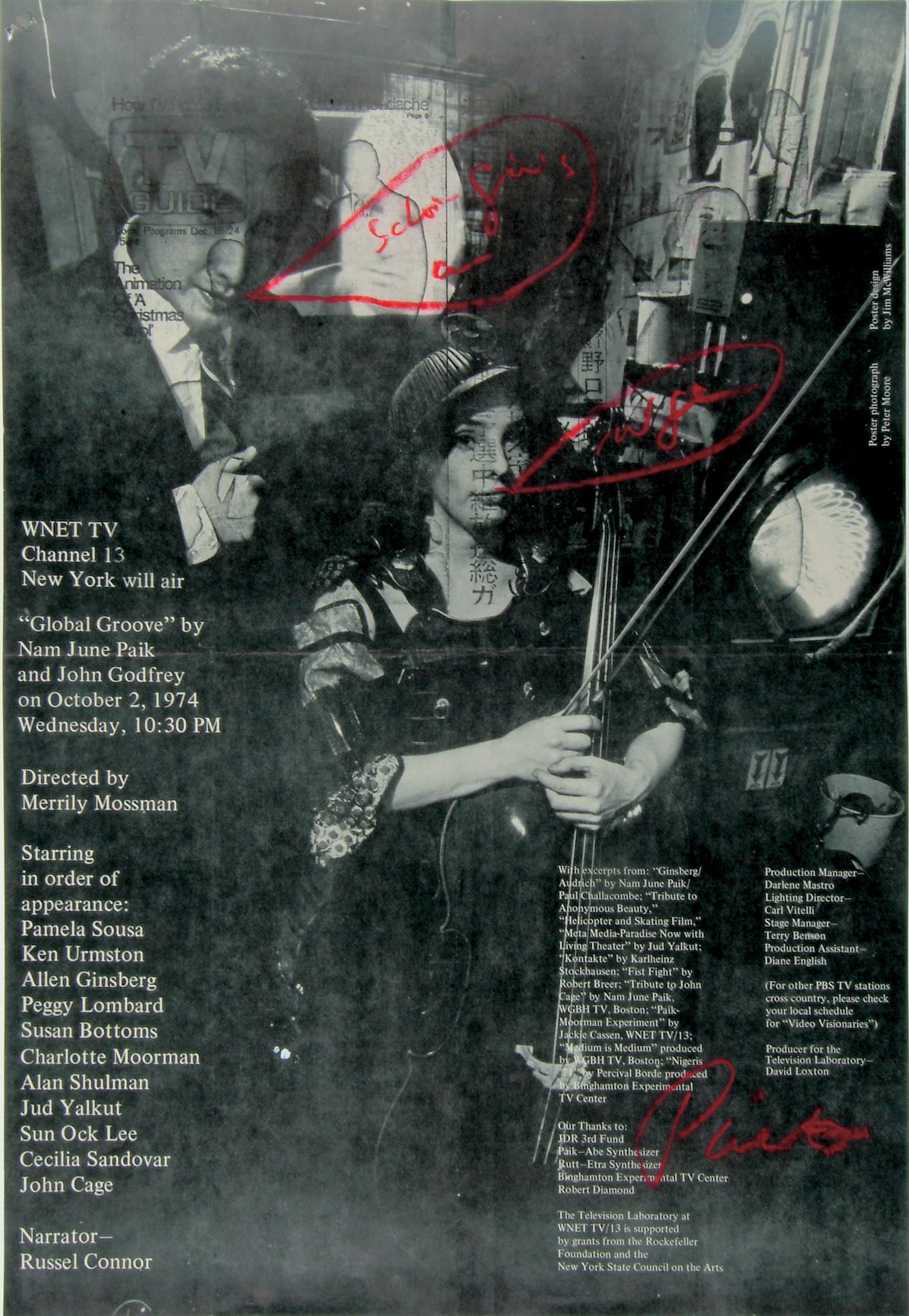
1974
Art
Creates TV Buddha, one of his most recognisable works. When presenting the work at the Projekt ’74 exhibition in Cologne, Paik also makes a version where he sits in place of the sculpture, becoming a “living Buddha.”
Creates Fluxus Fleet by assembling a row of old-fashioned irons into a fleet of mock battleships in military procession, echoing the influence of Marcel Duchamp and his readymades.
Creates TV Garden, an immersive installation of television sets placed within a sea of live plants that appears to create harmony between nature and technology. The television sets display Paik’s video work Global Groove created the year before.
Creates Untitled, combining the television set with traditional oil painting materials. Begins creating a second work that continues to explore found materials and imagery such as The Great Wave off Kanagawa by Hokusai (1760–1849).
Creates Paper TV Show, a scrapbook with doodles and two photographs of him and fellow artist Shigeko Kubota.
The video work Tribute to John Cage is broadcast on WGBH.
1974
Art
Presents a solo exhibition Electronic Art IV held at Galeria Bonino in New York, 15 January–2 February.
Presents a solo exhibition Nam June Paik: Videa ‘n’ Videology 1959–1973 held at Everson Museum of Art in New York 15 January–15 February. It is organised by the director James Harithas and curator David Ross, and is an important review of his career.
Participates in the group exhibition 2nd International Computer Art Festival held at The Kitchen, Mercer Arts Center in New York, 1–15 June.
Participates in the group exhibition EXPRMNTL 5: International Film Festival held at Knokke-Heist in Belgium, 25 December–2 January 1975.
Participates in the group exhibitions Project ’74–Aspects of International Art in the Early 1970s and Art Now ’74: A Celebration of the American Arts, held at Kunsthalle Köln and Kölnischer Kunstverein in Cologne and the John F. Kennedy Center for the Performing Arts in Washington D.C. respectively.
Participates in the Eleventh Annual New York Avant-Garde Festival held at Shea Stadium in New York.
Presents a programme of videotapes and video works at the Anthology Film Archive in New York.
Participates in Open Circuits, the first international video conference organised by the Museum of Modern Art in New York. He participates in a special panel with Stephen Beck.
1974
Art
In December, Arthur and Corinne Cantrill’s interview with Paik, “Global Groove-TV Opera-Nam June Paik,” is published in Cantrills Filmnotes, and Paul Schimmel’s interview of Paik, “Abstract Time,” is published in Arts Magazine.
Ear Magazine publishes his article “Music is a Mass Transit,” and the Everson Museum of Art includes his writings in their exhibition catalogue for Nam June Paik: Videa ‘n’ Videology 1959–1973.
1975
World
US President Gerald Ford announces Operation Babylift in April, advocating for humanitarian groups to work with orphanages in South Vietnam and undertake an emergency evacuation of children to the US, Australia, France, and Canada.
The Vietnam War ends on 30 April when Saigon falls to the North Vietnamese troops. This follows the exit of American troops and embassy from South Vietnam.
On 20 August, NASA launches Viking I, the first spacecraft to successfully land on Mars.
1975
World
Bill Gates and Paul Allen found Microsoft Corporation in Albuquerque, New Mexico in April.
1975
Biography
Camera 3 produces the documentary video The Strange Music of Nam June Paik.
Robert Harris releases the documentation (a film-to-videotape transfer) of Violin Dragging.
1975
Art
Performs Floor to Ceiling Discotheque solo, and Concerto for TV Cello and Videotapes and TV Bra for Living Sculpture with Charlotte Moorman, as part of Benefit for the Once Gallery at the Martha Jackson Gallery in New York.
Performs Lesson as part of the Fluxus Harpsichord Concert held at the Anthology Film Archives in New York.
Participates in Art Transition, a conference that examines new directions in intersections between art, science and technology, organised by the Center for Advanced Visual Studies, Massachusetts Institute of Technology, in collaboration with the University Film Study Center. Together with Charlotte Moorman, they perform Concerto for TV Cello and Videotapes.
Performs Variations No. 2 on a Theme by Saint-Saëns, Opéra Sextronique and TV Bra for Living Sculpture with Charlotte Moorman as part of the exhibition Objects and Concerts for Visual Music from the 1960s at Kunsthalle Düsseldorf in Germany.
Performs Violin To Be Dragged in the Street and a piano work at the 12th Annual Avant Garde Festival of New York at Gateway National Recreation Area/ Floyd Bennett Field in Brooklyn.
Performs Camera Three with Fred Barzyk, Charlotte Moorman and Russell Connor on CBSTV in New York.
1975
Art
Develops several prepared scrolls and TV-sculptures, including I-Ching TV, TV For Change, Majestic, Sonata for Goldfish and Candle TV.
Creates Suite 212, a 150-minute video made in collaboration with Jud Yalkut, David Atwood, Fred Barzyk, Shirley Clarke, Douglas David, Ed Emshwiller, John Godfrey, Francis Lee, Bob Parent, Judson Rosebush, Elliot Rose, Elaine Summers and Russell Connor. It also incorporates the short video work The Selling of New York (1972) and is produced in the studios of WNET-TV/Channel 13 TV Lab.
Creates Nam June Paik: Edited for Television, a 29-minute video made together with Calvin Tomkins and Russell Connor as part of WNET-TV/Channel 13 VTR Series.
Begins to conceptualise and start work on Merce by Merce.
1975
Art
Participates in the group exhibition Video Art held at the Institute of Contemporary Art of the University of Pennsylvania in Philadelphia, 17 January–28 February. The exhibition travels to The Contemporary Arts Center in Cincinnati, 22 March–30 May, and to Wadsworth Atheneum in Connecticut, 17 September–2 November.
Presents a solo exhibition Nam June Paik held at René Block Gallery in New York, 1 February–4 March.
Participates in the group exhibition Illuminous Realities held at the Fine Arts Gallery in Wright State University in Ohio.
Participates in the group exhibition Objekte und Kozerte zur Visuellen Musik de 60er Jahre (Objects and Concerts for Visual Music from the 1960s) held at Kunsthalle Düsseldorf.
Presents a solo exhibition Fish on the Sky—Fish hardly flies anymore on the Sky—let Fishes fly again held at Martha Jackson Gallery in New York.
Participates in the group exhibition Arte de Video (Video Art) held at Caracas Museum of Contemporary Art in Venezuela.
Participates in the group exhibition Selections from the Collection of Dorothy and Herbert Vogel at The Clock Tower, New York.
Participates in the group exhibition The Museum of Drawers at Kunsthaus, Zurich.
Participates in the group exhibition titled Art Transition at the Center for Advanced Visual Studies in Massachusetts Institute of Technology in Cambridge.
Participates in the 13th São Paulo Art Biennial (17 October–14 December) with the presentation of TV Garden. Paik is one of 20 artists selected to represent South Korea in this biennial. He also participates in the group exhibition Video Art U.S.A. that is part of the biennial.
1975
Art
Interview by Irmeline Lebeer’s interview of Paik, “Entretien avec Nam June Paik” (Interview with Nam June Paik), is published in the periodical Chroniques de l’art vivant (Chronicles of Living Art), and Douglas Davis’ interview of Paik is published in the book Von Experiment zur Idee (From Experiment to Idea).
1976
World
Chinese leaders Zhou Enlai and Mao Zedong pass away in January and September respectively.
1976
World
Taxi Driver, directed by Martin Scorsese and starring Robert De Niro, is released. The narrative of the film is often related to the aftermath of the Vietnam War in the US.
1976
World
Steve Jobs, Steve Wozniak and Ronald Wayne found Apple Inc. in California and launch the Apple I Computer Kit.
1976
Art
Performs an untitled solo piece as part of the concert Revolving Stage, organised by Jean Dupuy at the Judson Memorial Church in New York.
Performs Tour for Foreign Visitors: Arranged by George Brecht with others as part of Free Flux-Tours in New York. Also performs eat wonton soup at 17 Mott Street with instructions for visitors to perform on their own.
Performs TV Bra for Living Sculpture with Charlotte Moorman at Galeria Bonino in New York and the King George School in Guadalcanal, Solomon Islands.
Performs various works with Charlotte Moorman as part of the Adelaide Festival of the Arts and in Sydney at the Art Gallery of New South Wales and the Sydney Opera House.
Performs on the piano as part of the SoHo Quadrat at Akademie der Kunste in West Berlin.
Performs various works with Charlotte Moorman as part of his solo exhibition Nam June Paik: Works 1946–1976, Music—Fluxus—Video at Kölnischer Kunstverein in Cologne.
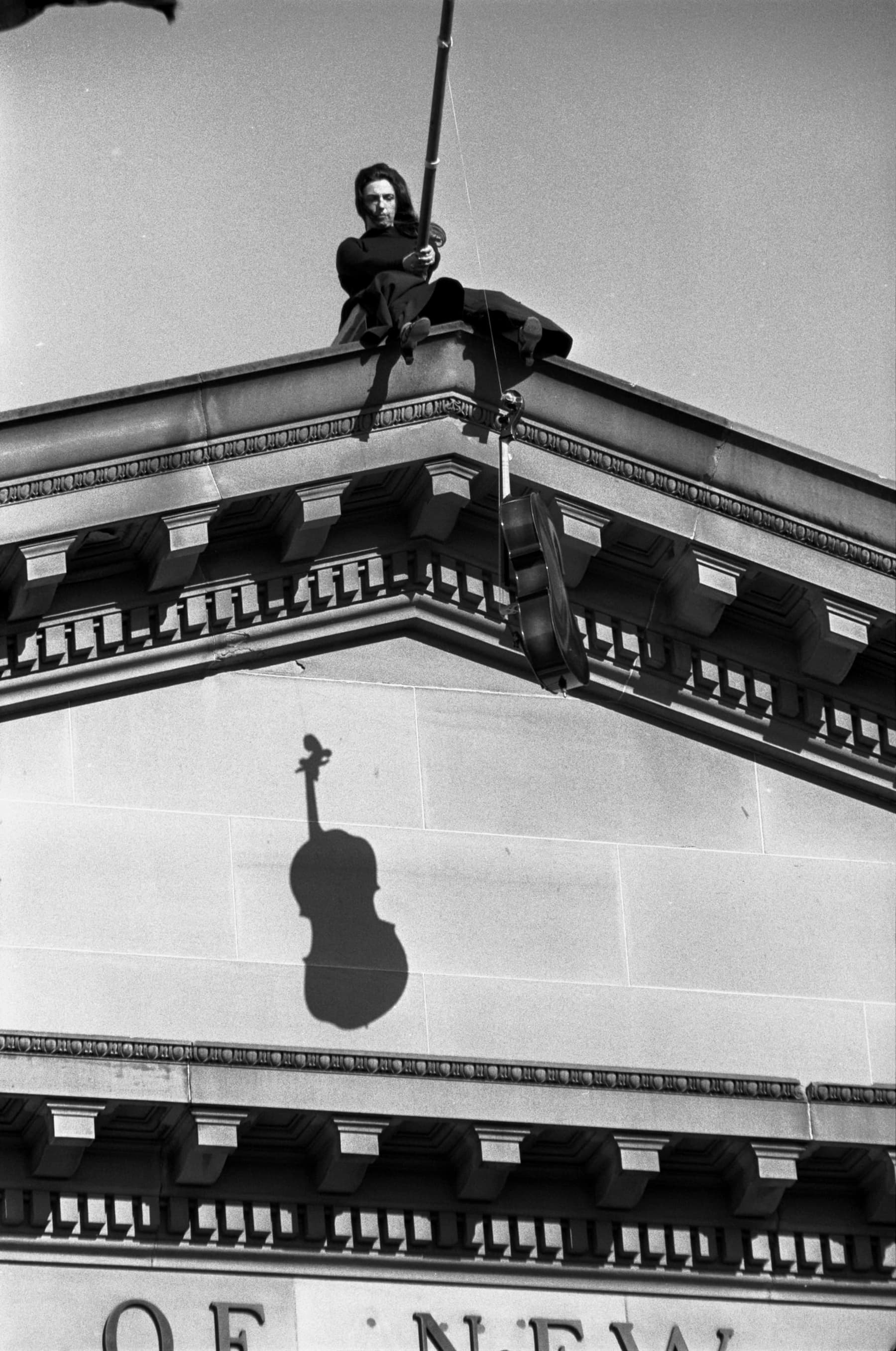
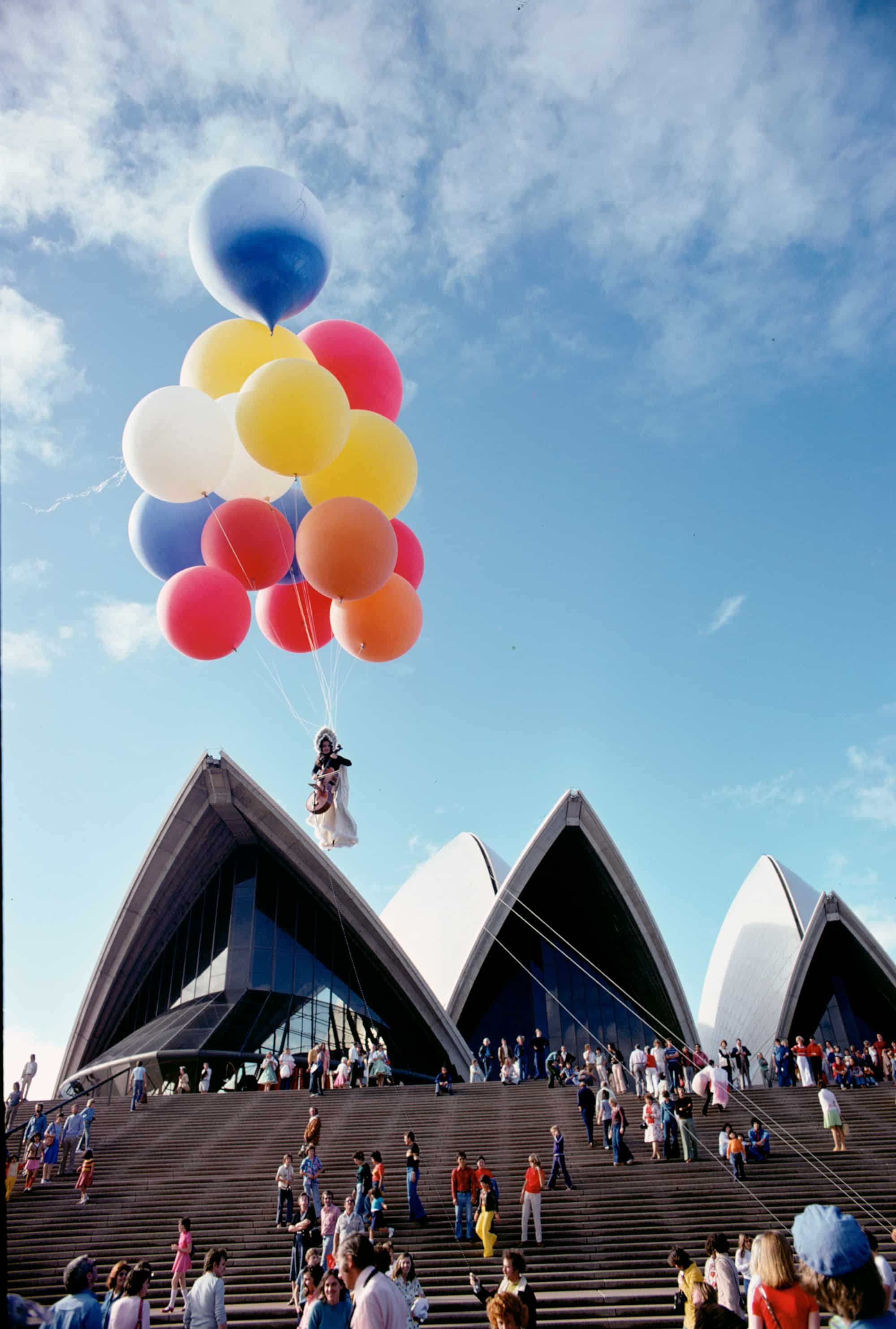
1976
Art
Presents a solo exhibition Moon Is the Oldest TV held at René Block Gallery in New York, 21 February–18 March.
Presents a solo exhibition Nam June Paik: Works 1946–1976, Music—Fluxus—Video held at Kölnischer Kunstverein in Cologne, 19 November–9 January 1977. This exhibition is Paik’s first retrospective in Europe and later travelled to the Stedelijk Museum in Amsterdam. Curated by Wulf Herzogenrath, the project is now noted as the first of a series of exhibitions by Herzogenrath at Kölnischer Kunstverein, characterised by an intensive engagement with new formats for exhibitions and presentations.
Presents a solo exhibition Fish Flies on Sky held at Galeria Bonino in New York.
Participates in the group exhibition Monumente durch Medien ersetzen (Replace Monuments with Media) held at Kunst-und Museumsverein Wuppertal.
Participates in the group exhibition SoHo Quadrat held at Akademie der Kunste in West Berlin.
Participates in the group exhibition Dødsspringet på Charlottenborg, curated by Sven Hansen at Kunsthal Charlottenborg in Copemhagen.
Participates in the group exhibition The River: Images of the Mississippi held at the Walker Art Center in Minneapolis.
Participates in group exhibition New York–Downtown Manhattan: SoHo held at Akademie de Künste in Berlin.
Presents Video Film Concert, several films made in collaboration with Jud Yalkut, at The Kitchen, Mercer Arts Center in New York.
Presents a touring exhibition at the Art Gallery of South Australia in Adelaide, and Art Gallery of New South Wales and Coventry Gallery in Sydney.
1976
Art
Marianne Dozema’s interview of Paik, “Video,” is published in the periodical Lightworks in June.
Svend Hansen publishes his piece “Electronic Sistine Chapel” in the exhibition catalogue for Catalog Dødspringet, and Kolnischer Kunstverein publishes various writings in the exhibition catalogue for Nam June Paik: Works 1946–1976, Music—Fluxus—Video.
1977
World
In August, China announces the end of the Cultural Revolution at its 11th National Congress of the Chinese Communist Party. The national college entrance examination resume.
1977
World
Star Wars, an American science fiction film written and directed by George Lucas, premieres. It was later renamed Star Wars: Episode IV—A New Hope when subsequent films were released.
1977
Biography
Begins a visiting professorship at the Hochschule für bildende Künste Hamburg (HFBK University of Fine Arts Hamburg).
Marries fellow video artist Shigeko Kubota in New York.
1977
Art
Presents a live concert From Jail to Jungle: Charlotte Moorman & Nam June Paik on 10 February at Carnegie Hall in New York. Paik and Moorman perform various piece including Opéra Sextronique, and premiere the video work Guadalcanal Requiem.
Performs a live series of performances with Charlotte Moorman, Joseph Beuys and Douglas Davis as part of Documenta 6 in Kassel, which runs from 26 June–2 October. These performances are concurrently broadcast to different television channels using satellite-broadcast technology.
Performs Joseph Beuys’ Infiltration-homogen für Cello with Charlotte Moorman at The Town Hall in New York. Also performs this work at the 13th Annual New York Avant Garde Festival in the fall at the World Trade Center in New York.
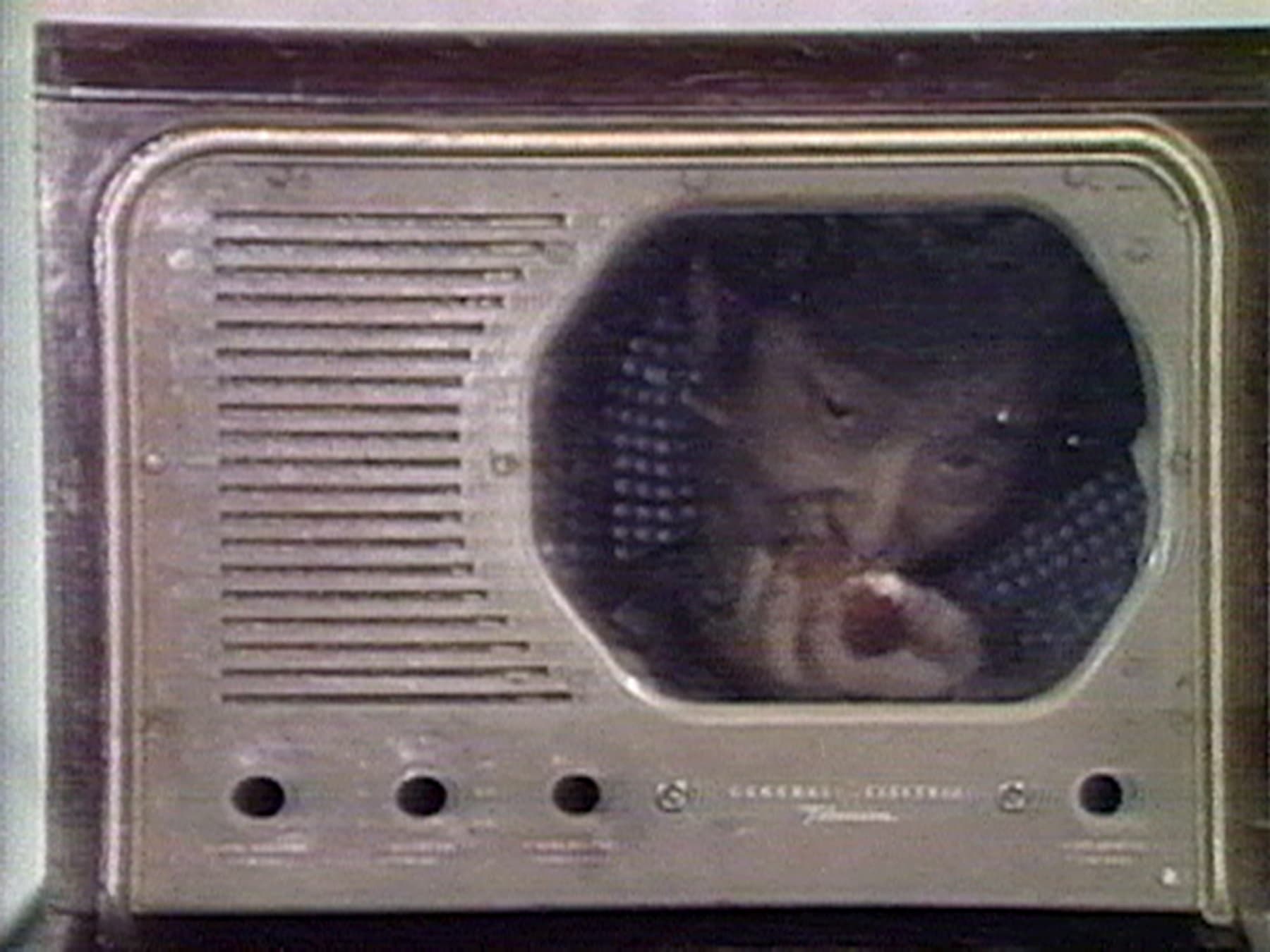
1977
Art
Guadalcanal Requiem premieres at Carnegie Hall on 10 February, as part of the concert From Jail to Jungle: Charlotte Moorman & Nam June Paik. The 50-minute video work is made together with Charlotte Moorman during their Australian-Pacific visit, and is later revised to 29 minutes and aired on WNET-TV on 14 February.
Creates audio work My Jubilee ist unverhemmt (My Jubilee Is Uninhibited) as an LP under the label Edition Lebeer Hossman.
Creates video work Nine Minutes (Documenta 6 Satellite Telecast), in collaboration with Douglas Davis and Joseph Beuys.
1977
Art
Participates in the 1977 Biennial Exhibition held at the Whitney Museum of American Art in New York, 15 February–3 April.
Participates in Documenta 6 in Kassel, which runs from 26 June–2 October.
Presents a solo exhibition Projects: Nam June Paik held at The Museum of Modern Art in New York, which closes on 9 October.
Presents a solo exhibition Fluxus Traffic held at René Block Gallery in West Berlin.
Presents a solo exhibition Nam June Paik held at Galeria Marika Malacorda in Geneva.
Participates in CAYC Conference, organised by Jorge Glusberg in Mexico City.
1977
Art
Douglas David’s interview with Paik, “Nam June Paik: Une exploration son/vision,” is published in arTitudes in January.
The periodical Tracks 3 publishes Paik’s article “Morning Three, Evening Four” in the fall.
An interview of Paik, “Nam June Paik,” is published in Kunst und Medien.
1978
World
The arcade video game by Taito, Space Invaders, is released in Japan. The game showcases two-dimensional graphics and is one of the first shooting games to be created, opening the door for modern video gaming.
In the town of Kaikoura, New Zealand, UFO sightings are repeatedly reported and streaks of bright lights are seen in the sky during December.
1978
World
Louise Brown, the world’s first baby conceived through in-vitro fertilisation, is born in Manchester on 25 July.
Microsoft sets up its first international office in the Shinjuku district of Tokyo.
1978
Art
Premieres Klavierduett (Piano Duet) in Memoriam to George Maciunas with Joseph Beuys at Staatliche Kunstakademie in Düsseldorf on 7 July.
Performs Merce by Merce by Paik and Merce and Marcel on WNET-TV/Channel 13 in New York on 16, 20 and 24 September.
Performs Concerto for TV Cello and Videotapes and TV Bra for Living Sculpture with Charlotte Moorman at Musée d’Art Moderne de la Ville de Paris (City of Paris Museum of Modern Art).
1978
Art
Creates Merce by Merce by Paik Part I: Blue Studio—Five Segments with Charles Atlas and Merce Cunningham, followed by Part II: Merce and Marcel with Shigeko Kubota. Each part is 30 minutes long and is produced at WNET-TV/Channel 13 TV Lab in New York.
Creates Media Shuttle: Moscow/New York, a 30-minute video in collaboration with Dimitri Devyatkin that is produced at WNET-TV/Channel 13 TV Lab.
Creates You Can’t Lick Stamps in China, a 30-minute video in collaboration with Gregory Battcock. This is co-produced by WNET-TV/Channel 13 TV Lab and International Television Workshop.
Creates audio work Klavier Duett: In Memoriam George Maciunas in collaboration with Joseph Beuys as 2 LPs under the label Edition Block.
Creates the video work Tribute to GM (aka Video Venus).
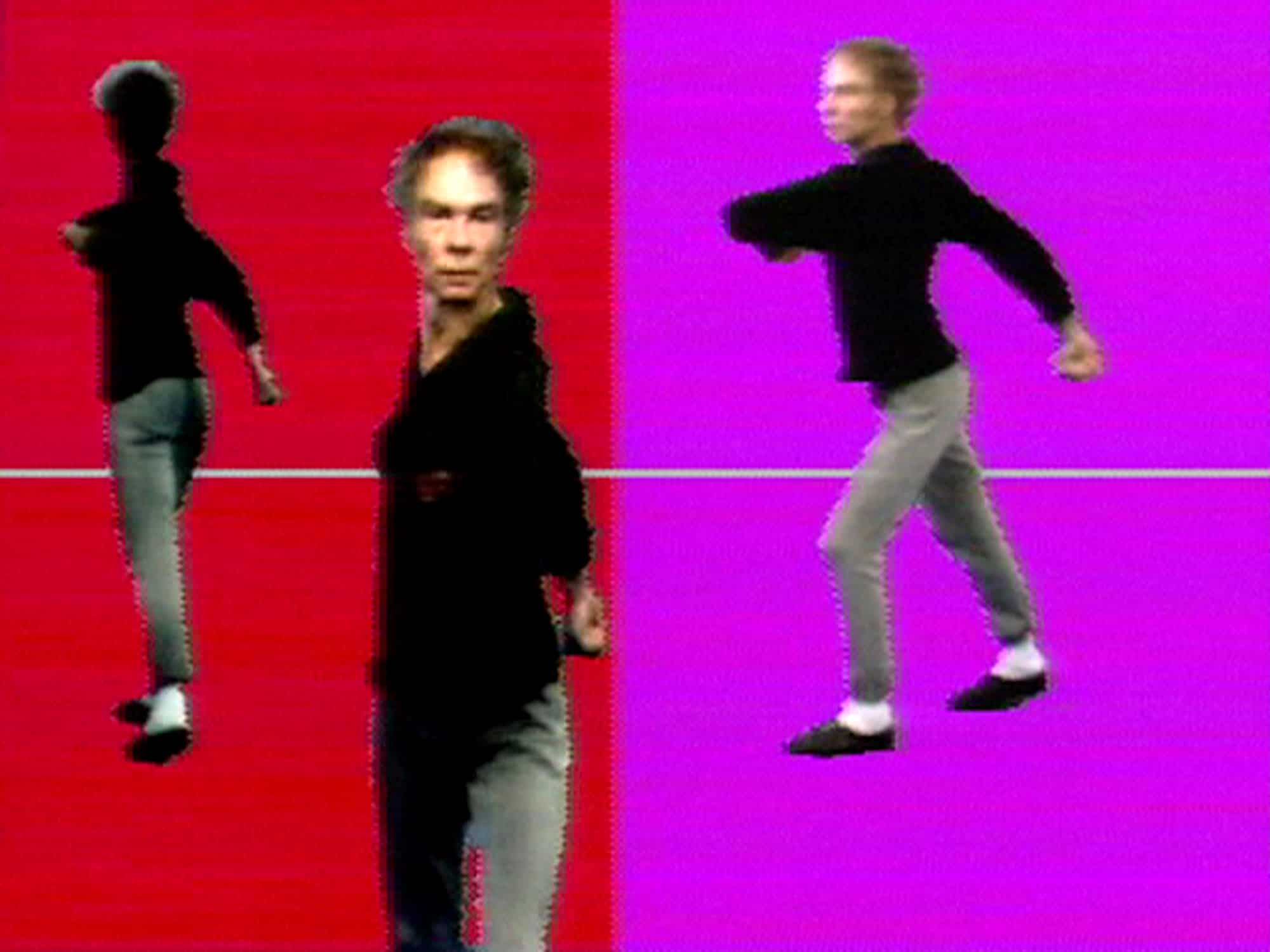
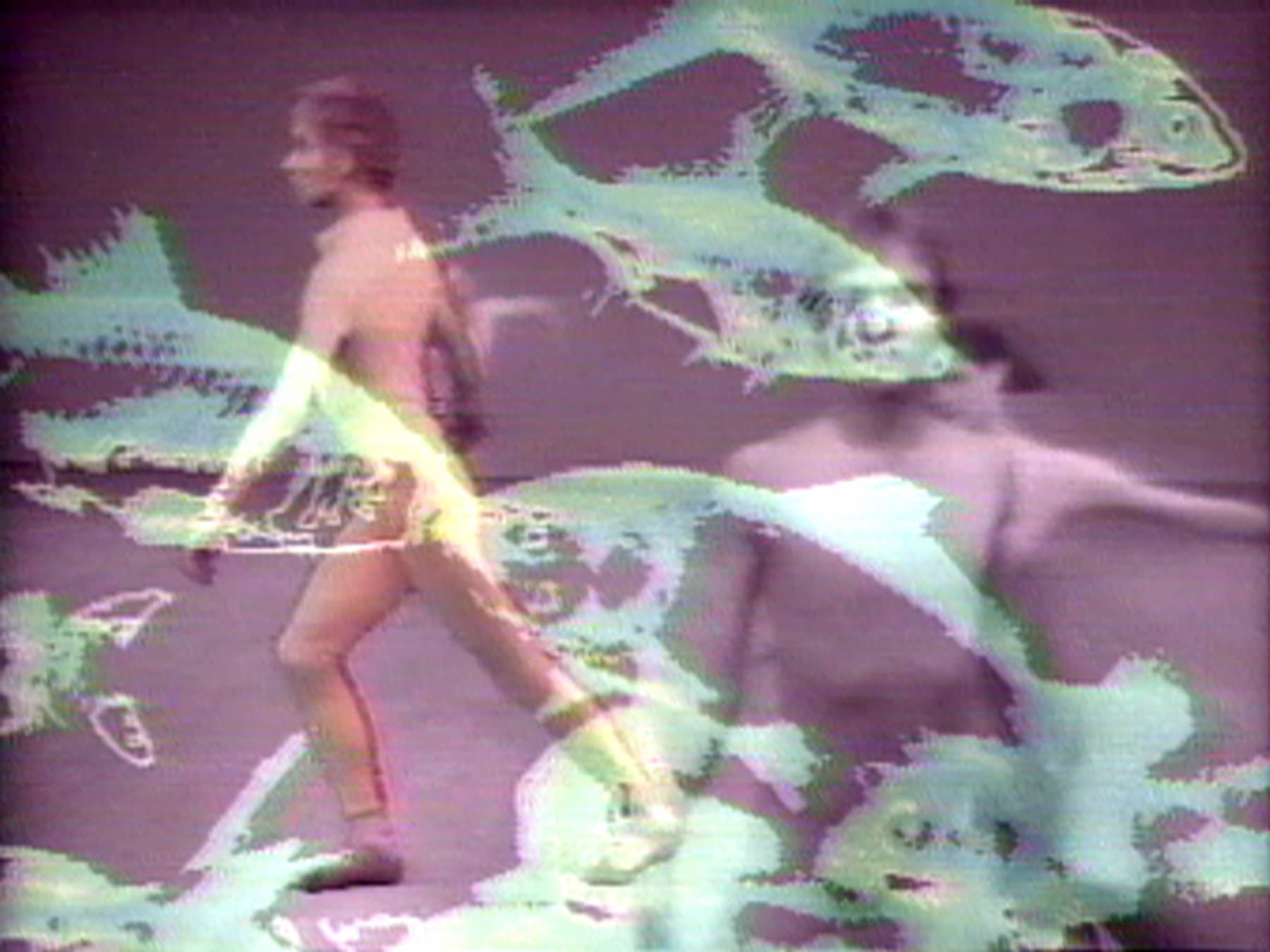
Produced by the TV Lab at WNET/Thirteen. Host: Russell Connor, camera: Bob Harris, music: David Held, Earl Howard, John Cage. With excerpts of work by Woody and Steina Vasulka, Bill Gwin, Jean Marie Drot, Nancy Graves, Erik Martin and Russell Connor.
1978
Art
Presents a solo exhibition A Tribute to John Cage held at Gallery Watari in Tokyo, 15–30 May.
Presents a solo exhibition Nam June Paik held at Musée d’Art Moderne de la Ville de Paris, 22 November–8 January 1979.
Presents a solo exhibition TV Garden held at Centre Pompidou in Paris.
1979
World
Margaret Thatcher begins her term as the first female prime minister of Great Britain on 3 May.
The Siege of the Grand Mosque in Mecca begins on 20 November and reveals the severity of terrorism. The two-week-long attack takes approximately 4,000 lives.
1979
World
The action film Mad Max and the science fiction film Star Trek: The Motion Picture are released.
1979
Biography
Begins a teaching position at the Kunstakademie Düsseldorf (Dusseldorf Art Academy) in West Germany, and remains there until 1995/1996.
1979
Art
Premieres Duett Paik-Takis with Takis at Kölnischer Kunstverein in Cologne.
On 13 December, his performance Guadalcanal Requiem with Charlotte Moorman broadcasts on WNET/Thirteen in New York. It is later rebroadcast on 2 March 1980.
1979
Art
Collaborates with Greek artist Takis on the audio work Duett: Paik|Takis which is released as an LP under the label Edititon Kölnischer Kunstverein.
1979
Art
Participates in the group exhibition Sammlung Hahn (The Hahn Collection) held at Museum of Modern Art (MUMOK) in Vienna.
1979
Art
Flash Art publishes an essay by Paik in January.
Jean-Paul Cassagnac, Jean-Pal Fargier and Sylvia van der Stegen’s interview with Paik, “Entretien avec Nam June Paik” (Interview with Nam June Paik), is published in Cahiers de Cinema (Cinema Notebooks).
1980s
1980
World
John Lennon, former member of The Beatles, is murdered in New York on 8 December.
Nintendo releases the very first handheld electronic game known as Game & Watch.
1980
World
Microsoft teams up with IBM to create the BASIC interpreter for the latter’s first-ever personal computer, the IBM PC, due for release the next year.
Computer scientists Tom Truscott and Jim Ellis create USENET, a UNIX-based system that uses a dial-up connection to transfer data through telephone modems. This is an early predecessor of dial-up network access in universities of the 1980s, and dial-up Internet access of the 1990s.
1980
Art
Premieres Video Sonata with Ernie Gusella, performs One for Violin Solo and performs Variations No. 2 on a Theme by Saint-Saëns with Charlotte Moorman at the Intermedia Arts Festival, at The Solomon R. Guggenheim Museum in New York.
Premieres Sinfonie No. 6 as conducted by Charlotte Moorman, performs Piano Sonata solo and performs Variations No. 2 on a Theme by Saint-Saëns and Concerto for TV Cello and Videotapes with Charlotte Moorman at Music of the Time: Encounter with Korea, a live concert with a broadcast element. Music of the Time was first launched in 1951, organised by Westdeutsche Rundfunk (WDR) radio station in Germany. The 1980 concert features Nam June Paik and focuses on his Korean roots.
1980
Art
Creates Lake Placid’80, a 4-minute video work commissioned by the National Fine Arts Committee of the XIII Winter Olympics Games in Lake Placid, New York. Paik gratefully acknowledges the contributions of various individuals and computer graphic designers in this production.
Creates the video work Nam June Paik on The Beatles.
1980
Art
Participates in the group exhibition Für Augen und Ohren (For Eyes and Ears) held at Akademie der Kunste (Academy of Arts) in West Berlin, 20 January–2 March. The exhibition travels to Paris under the title Ecouter par les yeux: Objets et environments sonores (Listening Through the Eyes: Objects and Sound Environments) and is held at the Musee d’art modern de la ville de Paris, 18 June–24 August.
Participates in the group exhibition Treffpunkt Parnass 1949–1965 (Parnass Meeting Point 1949–1965) held at Von der Heydt Museum in Wuppertal, 31 May–13 July.
Participates in the group exhibition Mein Kölner Dom (My Cologne Cathedral) held at Kölnischer Kunstverein in Cologne, 16 October–23 November.
A retrospective on his video works, Nam June Paik, is held at the Whitney Museum of American Art in New York as part of its The New American Filmmakers Series.
Presents a solo exhibition V-idea held at Gallery Watari in Tokyo.
Presents a solo exhibition Laser Video (with Horst Baumann) at Kunsthalle Düsseldorf.
1980
Art
Artforum publishes his article “Random Access Information” in September.
Hiroshi Kawani’s two-part interview with Paik, “To the Video World: Abstract Attraction by Paik I” and “To the Video World: Abstract Attraction by Paik II,” is published in Tokyo-based Bijutsu techo (Art Notes) in its October and November issues.
Dany Bloch’s interview with Paik, “Deux ou trois choses qu’on sait de lui” (Two or Three Things We Know About Him), and Pierre Brieux’s interview with Paik, “Les programmes de television américains pourraient dsintégrer la sociéeté soviétique en quelques minutes” (American Television Programs Could Integrate Soviet Society Within Minutes), are published in L’Art Vidèo (Video Art) and Libération respectively.
1981
World
The action-adventure movie Raiders of the Lost Ark, directed by Steven Spielberg and produced by George Lucas, is released. It is the first instalment of the Indiana Jones film series.
Online newspapers are introduced on the PLATO system at the University of Illinois and the Embratel network in Brazil, paving the way for publishing news on the internet in the 1990s.
1981
Biography
The Akademie der Kunste honours Paik with the Willi Grohmann Prize. Paik receives a DAAD Fellowship to work in Berlin.
1981
Art
Premieres Life’s Ambition Realized with Denise Gordon and performs several pieces with Andy Mannick as part of the Tenth Anniversary Concert for The Kitchen, at The Kitchen Center for Video, Music and Dance in New York.
Performs A Tribute to Gregory Battcock at the Anthology Film Archives in New York.
1981
Art
Develops a new performance-video work Imagine There Are More Stars on the Sky than Chinese on the Earth, in collaboration with Andy Mannick.
1981
Art
Participates in the group exhibition Centervideo held at the American Center for Students and Artists in Paris, 1–6 February.
Participates in the 1981 Whitney Biennial held at the Whitney Museum of American Art in New York, 4 February–12 April.
Screens TV Tactics at the Anthology Film Archives in New York, 21 July.
Presents a solo exhibition By with of on Beuys, Cage, Cunningham held at Galerie Watari in Tokyo, 11–26 August.
Participates in the group exhibition Fluxus Etc.: The Gilbert and Lila Silverman Collection held at Cranbrook Academy in Michigan, 20 September–1 November.
Participates in the group exhibition Fluxus-Aspekte eines Phanomens (Fluxus: Aspects of a Phenomenon) held at Von der Heydt-Museum in Weppertal, 15 December–31 January 1982.
Presents a solo exhibition Laser Video (with Horst Baumann) at Kunsthalle Düsseldorf. The exhibition later travels to Neuer Berliner Kunstverein (New Berlin Artist Society).
Presents a solo exhibition Random Access/Paper TV held at Gallery Watari in Tokyo.
Participates in the group exhibition Partitur (Score) held at Gelbe Musik in West Berlin.
Participates in the group exhibition Westkunst (Western Art) held at Cologne City Museum. It later travels to Kölner Messe in Cologne.
Participates in the group exhibition Ein Klein Dussel Village Video (A Little Duzzel Village Video) held at Kunsthalle and Kunstakademie Dusseldorf.
Presents a programme of videotapes and video works at the Sony Hall in Tokyo.
1981
Art
Shuntaro Tanigawa’s interview with Paik, “Seizing the Poetic Moment: Dialogue with Nam June Paik,” is published in Tokyo-based periodical Image Forum in January.
1982
World
The Lebanon War begins on 6 June when Israel invades Lebanon.
1982
World
Michael Jackson releases his sixth studio album Thriller on 30 November. It remains the best-selling album of all time.
The science fiction film E.T. the Extra-Terrestrial, directed by Steven Spielberg, is released.
1982
Biography
Kit Fitzgerald and John Sanborn create the documentary video A Tribute to Nam June Paik (Video Portrait of a Man Who Won’t Sit Still).
1982
Art
Creates one of his earliest large-scale video installations V-yramid in relation to his retrospective at the Whitney Museum of American Art. V-yramid consists of 40 televisions of varying sizes stacked into a pyramidal shape, designed to fill the galleries from floor to ceiling. In each of the televisions, a video produced by Paik on custom-made video synthesizer technology pulsates alongside music ranging from popular rock songs to traditional Korean ballads. Central to Paik’s concept for V-yramid is the notion of duality: the contrast between contemporary rock music and traditional Korean music, the fluidity of the video imagery and the architectural rigidity of the pyramid, the high culture of a religious monument and the low culture of television, and the ancient pyramid form and the era’s cutting-edge technology. Yet Paik did not necessarily see these opposing elements as being in conflict with one another.
Collaborates with Shigeko Kubota on the video work Allan ‘n’ Allen’s Complaint.
1982
Art
Holds his first retrospective exhibition Nam June Paik at the Whitney Museum of American Art in New York, 20 April–27 June. It is curated by John G. Hanhardt and accompanied by a series of public programmes: a panel discussion, two ticketed live performances by Nam June Paik and Charlotte Moorman, and broadcasts of seven video works by Paik on WNET-TV. The exhibition later travels to the Museum of Contemporary Art in Chicago.
Participates in the group exhibition Wiesbaden FLUXUS 1962-82 at Nassauischer Kunstverein in Wiesbaden, 17 September–14 November.
Participates in the group exhibition Laser Video: Nam June Paik, Horst Baumann held at Kunsthalle Düsseldorf, 28 November–21 December.
Holds his first retrospective exhibition Nam June Paik: Tricolor Video at Centre Pompidou in Paris, 15 December–11 April 1983.
Participates in the group exhibition Videokunst in Deutschland 1963–1982 (Video Art in Germany 1963–1982) held at Kunstverein in Cologne, which subsequently travels to Hamburger Kunsthalle, Badischer Kunstverein in Karlsruhe, Westfälischer Kunstverein in Münster, as well as to Munich, Nuremberg and Berlin.
Participates in the group exhibition 60’80 attitudes|concepts|images held at Stedelijk Museum in Amsterdam.
1982
Art
Willoughby Sharp’s interview with Paik, “‘Artificial Metabolism.’ An Exclusive Interview with Nam June Paik,” is published in the magazine Video 80.
1983
World
Civilian airliner Korean Airlines Flight 007 is shot down by Soviet jet interceptors on 1 September 1 over the Sea of Japan, when it passes through prohibited Soviet airspace enroute from Alaska to Seoul. This incident heightens tensions between the US and USSR.
1983
World
Michael Jackson debuts his famous moonwalk on stage on 25 March, and on live television on 16 May.
The video game crash in North America brings an abrupt end to a generation of console video gaming in the English-speaking world. Several reasons contributed to the fall, including market saturation of game consoles and titles, as well as declining interest in console games in favour of personal computers. The industry is later revitalised in the 1990s due to the widespread success of the Japanese Nintendo Entertainment System.
The crime drama Scarface, directed by Brian De Palma, is released.
1983
World
On 1 January, Transfer Control Protocol/Internetwork Protocol (TCP/IP), a new communications protocol for computers, is established. It standardises the way computers from different parts of the world communicate with each other and allows for smooth sharing of information. This day marks the official birthday of the internet.
1983
Art
Participates in the group exhibition John Cage|Nam June Paik: Eine kleine Geschichte von Fluxus at daadgalerie in Berlin, 22 January–20 February.
Participates in the 1983 Biennial Exhibition held at the Whitney Museum of American Art in New York, 15 March–29 May.
Participates in the group exhibition American Video: Twenty New Works held at Hyogo Prefectural Museum, 3–8 May.
Presents a solo exhibition Video Flag held at Carl Solway Gallery in Cincinnati, 6 September–31 December.
Participates in the group exhibition Electra: L’électrité et l’électronique dans l’art au Xxe siècle (Electra. Electricity and Electronics in the Art of the 20th Century) held at Museé d’art modern de la ville de Paris, 10 December–5 February 1984.
1983
Art
Jason Weiss’ interview with Paik, “Entretien Avec Nam June Paik” (Interview with Nam June Paik), is published in Jazz Magazine.
1984
World
The supernatural comedy Ghostbusters, written by co-stars Dan Aykroyd and Harold Ramis, is released.
Richard Saul Wurman and Harry Marks found TED and organise its first conference.
1984
World
Apple debuts their revolutionary digital art programme MacPaint on 22 January, in conjunction with their release of the Apple Macintosh on 24 January.
1984
Biography
Makes his first trip to South Korea in 34 years in June. This trip is often seen in relation to the 1988 Seoul Olympics, as Paik was a key figure in this event.
Joins Joseph Beuys’ visit to Tokyo.
1984
Art
Performs Concert Performance with Two Pianos with Joseph Beuys at Sogetsu Hall in Tokyo, 2 June.
Performs Coyote III with Joseph Beuys in Tokyo, when their solo exhibitions were concurrently running in summer. This is his last collaborative performance with Beuys. Paik films the full performance to preserve it for future television programmes and art exhibitions.
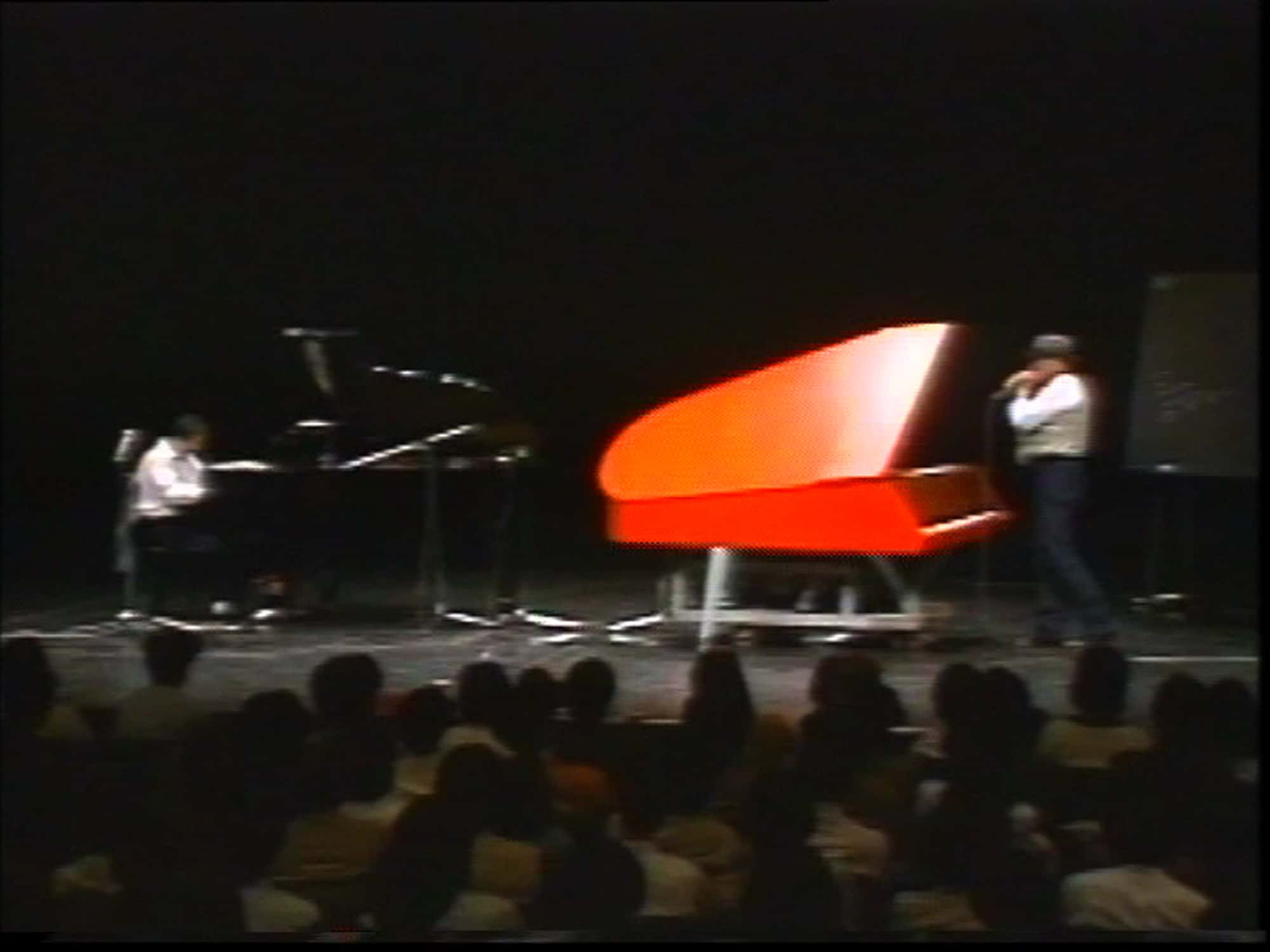
1984
Art
Creates Good Morning Mr. Orwell, his first international satellite “installation” and the first international satellite live broadcast in the world.
Creates Vusac-NY.
Conceptualises and starts making Egg Grows.
Collaborates with Ryuichi Sakamoto on All Star Video.
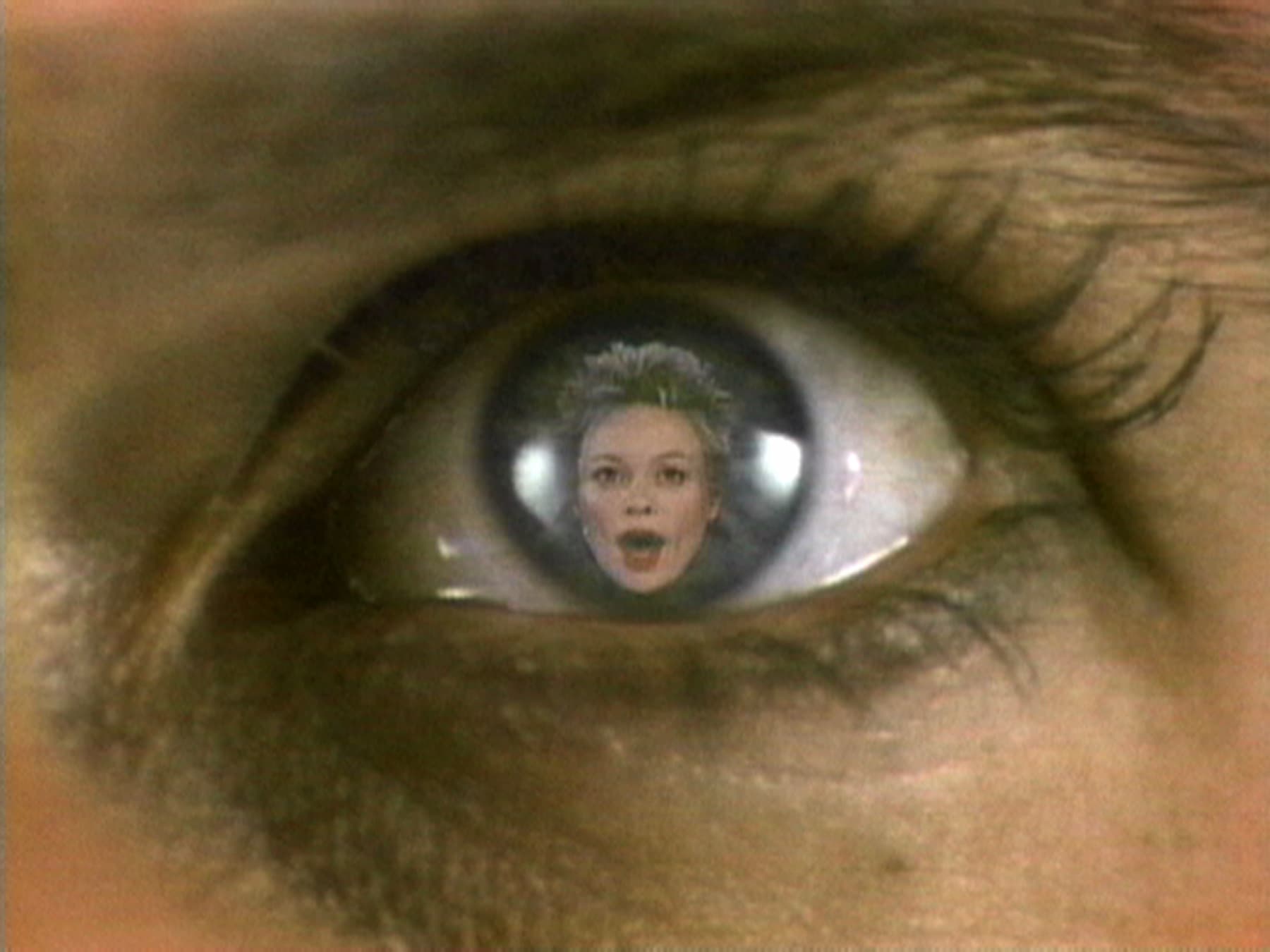
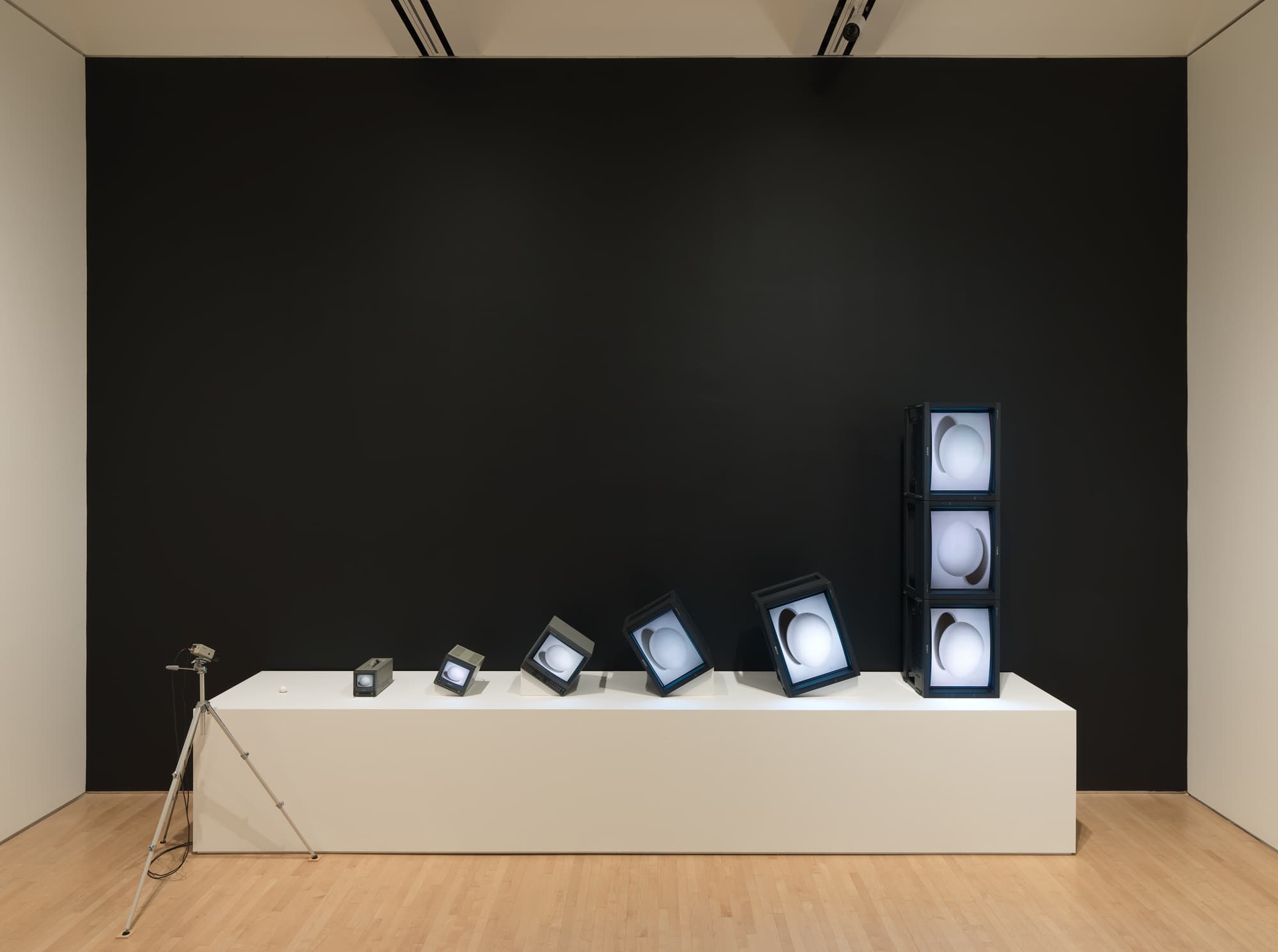
1984
Art
Participates in the group exhibition Nam June Paik, John Cage, Merce Cunningham held at Won Gallery in Seoul, 1–10 February.
Participates in the group exhibition Joseph Beuys and Nam June Paik held at Galerie Watari in Tokyo, 15 May–17 July. The exhibition is sponsored by the Seibu Museum.
Participates in the 1984 Venice Biennale, 20 May–16 September.
Presents a solo exhibition Nam June Paik—Mostly Video held at Tokyo Metropolitan Art Museum, 14 June–29 July.
Presents a solo exhibition Nam June Paik: BSO and Beyond held at the Institute of Contemporary Art in Boston, 6 September–4 November.
Participates in the group exhibition Video: A Retrospective held at Long Beach Museum of Art in California, 9 September–4 November.
Participates in the group exhibition Het Lumineuze Beeld (The Luminous Image) held at Stedelijk Museum in Amsterdam, 14 September–28 October.
Participates in the group exhibition Von Hier Aus: Zwei Monate neue deutsche Kunst in Düsseldorf (Up from Here: Two Months of New German Art in Düsseldorf) held in Düsseldorf, 29 September–2 December.
Participates in the group exhibition Content: A Contemporary Focus held at the Hirshhorn Museum and Sculpture Garden in Washington, D.C., 4 October–6 January 1985.
Presents a solo exhibition Good Morning Mr. Orwell held at the daadgalerie in Berlin, 29 November–9 December.
Presents a solo exhibition Tribute to Marshall McLuhan held at Galerie Esperanza in Montreal.
Participates in the group exhibition Art and Time in Brussels.
1984
Art
Bijutsu techo publishes Paik’s article “Conversations with Joseph Beuys” in April.
Ichiro Haryu’s interview with Paik, “Good Evening, My. Beuys and Paik! Beuys+Paik+Ichiro Haryu” is published in Bijustu techo in August, and Marien Lewis’ interview, “My Lunch with Nam June Paik,” is published in Canadian Art in winter.
Galerie Watari includes Paik’s text in their exhibition catalogue for Joseph Beuys and Nam June Paik.
Tokyo Metropolitan Art Museum publishes an essay by Paik, “La Vie, Satellites, One Meeting-One Life,” in their exhibition catalogue Nam June Paik: Mostly Video.
Paik compiles and publishes an anthology of his satellite art events, Art for 25 Million People: Bonjour, Monsieur Orwell: Kunst und Satelliten in der Zukunf, in conjunction with the exhibition Good Morning Mr. Orwell.
1985
World
Nintendo launches R.O.B. (Robotic Operating Buddy), the first commercial robot companion-toy, as an accessory to its gaming series.
1985
World
Microsoft releases the inaugural edition of Windows 1.0.
1985
Art
Creates July 20.
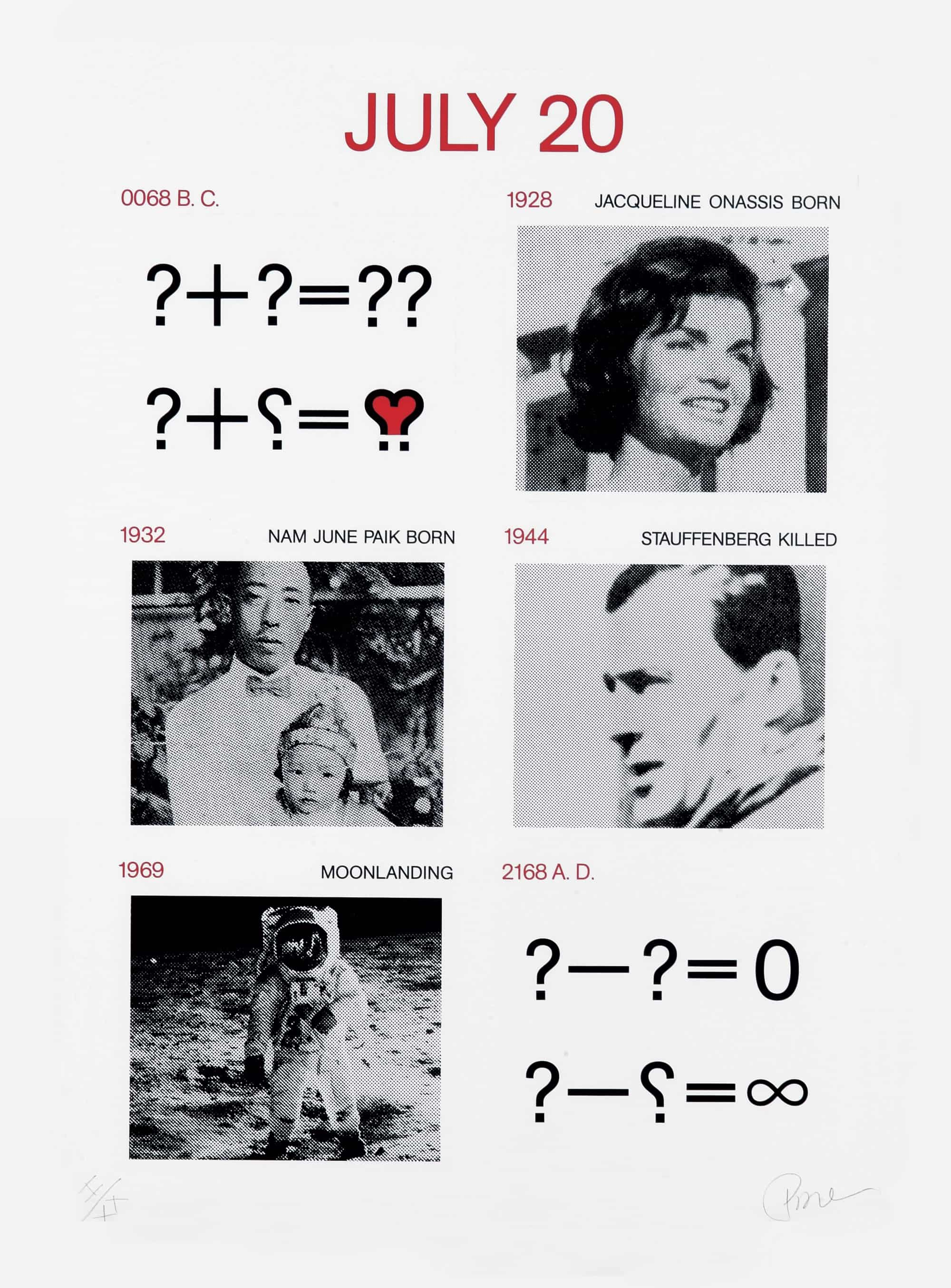
1985
Art
Participates in the group exhibition Video Sculpture held at ARCA Centre d’art contemporain in Marseilles, 3–22 June.
Participates in the Bienal Internacional de São Paulo (São Paulo Biennial) in Brazil.
1985
Art
William Crist’s interview of Paik, “An Interview with Nam June Paik,” is published in FORUM Visual Arts/Mid-America in the fall.
1986
World
On 26 April, a nuclear accident takes place at the Chernobyl Nuclear Power Plant in the Ukranian Soviet Socialist Republic (now Ukraine). The Chernobyl disaster is considered history’s most devastating nuclear plant disaster.
1986
World
South Korea first participates in the Venice Biennale in a small exhibition hall.
1986
World
Steve Jobs acquires a graphics group from George Lucas on 3 February and rebrands it as Pixar Studios.
1986
Art
Creates Bye Bye Kipling, another international satellite broadcast project, which airs on KBS1 Channel on 9 October.
Creates Butterfly.
Creates the Family of Robot series.
Collaborates with Paul Garrin to create Two Channel Music Tape: Spring|Fall, which is presented as a production of WNET/New York, the Korean Broadcasting System and Asahi National Broadcasting Co. Ltd.
1986
Art
Presents a solo exhibition Family of Robot held at Carl Solway Gallery in Cincinnati, 5 March–30 April.
Participates in the group exhibition Resolution: A Critique of Video Art|TV Generation held at Los Angeles Cotemporary Exhibitions, 18 April–10 May.
Participates in the group exhibition Prospect 86: Eine internationale Ausstellung aktueller Kunst (Prospect 86: An International Exhibition of Contemporary Art) held at Frankfurt Kunstverein, Steinernes Haus am Römerberg and Schrin Kunsthalle Frankfurt in Frankfurt, 9 September–2 November.
Presents a solo exhibition Family of Robot held at Holly Solomon Gallery in New York, 25 September–25 October. He also presents another solo exhibition Nam June Paik: Sculpture, Painting and Laser Photography at Holly Solomon Gallery this year.
Presents a solo exhibition Bye-Bye Kipling Drawings held at Galerie Watari in Tokyo, 9–25 October.
Presents a solo exhibition Nam June Paik held at Fukui Theater FBC in Fukui, 11 October–3 November.
Presents a solo exhibition Family of Robot at the International Art Exposition in Chicago.
Participates in the group exhibition American Icons: Selections from the Chase Manhattan Collection held at Bruce Museum in Connecticut. The exhibition travels to Heckscher Museum as well as The Robertson Center of the Arts and Sciences in New York.
Participates in the group exhibition The Freedman Gallery: The First Decade held at The Freedman Gallery in Pennsylvania.
Participates in the group exhibition Toy as Art held at First Street Forum in St. Louis.
1986
Art
Galerie Watari includes Paik’s text in their exhibition catalogue for Bye-Bye Kipling Drawings.
1987
World
American artist Andy Warhol, a key figure in Pop Art, dies on 22 February.
Star Trek: The New Generation, an science fiction television series based on the 1966 original, debuts in the US.
Zhang Yimou’s Red Sorghum is released and wins the Golden Bear at the 1988 Berlin International Film Festival.
1987
World
Apple debuts its Hypercard, a computer programme developed by Bill Atkinson for Apple Computer, Inc., for Macintosh. It is one of the earliest successful hypermedia systems created prior to the World Wide Web.
1987
Biography
Becomes a member of the Akademie der Bildenden Künste (Academy of Visual Art) in Berlin.
1987
Art
Creates TV-Buddha für Enten (TV Buddha for Ducks) for the 2nd Skulptur Projekte Münster (2nd Sculpture Projects Münster) in Germany.
1987
Art
Participates in the 1987 Biennial Exhibition held at the Whitney Museum of American Art in New York, 31 March–5 July.
Participates in the group exhibition L’Époque, La Mode, La Morale, La Passion: Aspects de l’art d’aujour-d’hui, 1977–1987 (Time, Fashion, Morality, Passion: Aspects of Today’s Art, 1977–1987) held at Centre Georges Pompidou in Paris, 21 May–17 August.
Participates in Documenta 8 in Kassel, 12 June–20 September.
Participates in the 2nd Skulptur Projekte Münster, 14 June–4 October.
Participates in the group exhibition The Arts for Television held at The Museum of Contemporary Art in Los Angeles, 4 September–18 October.
1988
World
On 14 April, the USSR consents to withdrawing its forces and ending its occupation over Afghanistan in an agreement signed between the USSR, Afghanistan, the US and Pakistan.
Iran and Iraq declare a ceasefire on 20 August after eight years of war.
The United Nations Environmental Programme and the World Meteorological Organization establish the International Panel of Climate Change.
1988
World
Mystery Science Theater 3000 (MST3K), a cult comedy television series created by Joel Hodgson, launches in November and runs till August 1999. It covers various socio-political and fantasy topics.
1988
World
The first transatlantic telephone cable to use optical fibre goes into operation, connecting the US, UK and France.
1988
Art
Creates Wrap Around the World, a live television broadcast on 10 September on numerous television networks. Tokyo, KBS (Korea) and WNET/ Thirteen (New York) present the work in association with WDR/NDR (Germany), ORF (Austria), Asahi National Broadcasting (Japan), RAI (Italy), Globo (Brazil), Radio Telefis Eireann (Ireland), April Media (Israel), Chinese Central Television (China), Gosteleradio (USSR) and Nam June Paik Video Design.
Creates a permanent outdoor sculpture Metrobot for the Contemporary Arts Center in Cincinnati, dedicated on 4 November.
Creates The More the Better with the support of architect Kim Won to commemorate the 1988 Seoul Olympics, at the invitation of the Korean Olympic Games Committee. The work is housed in the Museum of Modern and Contemporary Art in Gwacheon.
Creates Sister.
1988
Art
Participates in the group exhibition On Track: An Exhibition of Art in Technology held at Nova Building in Calgary, 26 January–28 February.
Presents a solo exhibition Nam June Paik: Beuys and Bogie held at Dorothy Goldeen Gallery in Santa Monica, 18 February–26 March. He also participates in the group exhibition Private Reserve at this venue this year.
Participates in the group exhibition Video Art: Expanded Forms held at the Whitney Museum of American Art at Equitable Center in New York, 18 February–30 March.
Participates in the group exhibition Interaction: Light, Sound, Motion held at Aldrich Museum of Contemporary Art in Connecticut, 22 May–5 September.
Participates in the group exhibition Positionen heutiger Kunst: Serra, Twombly, Paik, Stella, Kounellis, Merz (Positions of Today’s Art: Serra, Twombly, Paik, Stella, Kounellis, Merz) held at Nationalgalerie Berlin, 23 June–18 September.
Participates in the Australian Biennale 1988: From the Southern Cross, A View of World Art 1940–1988 in Sydney, 4 August–18 September.
Participates in the group exhibition Beuys Vox, Nam June Paik, 1961–1986 held at the World Financial Center in New York, 14–30 September. The catalogue written for the exhibition includes text by Paik.
Presents a solo exhibition Nam June Paik: Video Works 1963–88 held at Hayward Gallery in London, 29 September–11 December. This exhibition—the first full-scale representation of his video art—focuses on the artist’s video sculptures, including his Family of Robots (1986).
Presents a solo exhibition Nam June Paik: “V-Idea” held at Nigel Greenwood Gallery in London, 1 October–5 November.
Participates in the group exhibition American Baroque held at Holly Solomon Gallery in New York, December. Also presents a solo exhibition Nam June Paik: Color Bar Paintings at this venue this year.
Participates in ARCO Madrid art fair.
Participates in the group exhibition 1988: The World of Art Today held at Milwaukee Art Museum.
1988
Art
The exhibition catalogue for Beuys Vox, Nam June Paik, 1961–1986 includes Paik’s text.
1989
World
The Berlin Wall falls on 9 November. It marks the end of the Iron Curtain and the start of the fall of communism in Eastern and Central Europe. The dissolution of the German internal border takes place shortly afterwards, and the Cold War is declared over at the Malta Summit three weeks later.
1989
World
Nintendo releases the first Game Boy, an 8-bit handheld video game console, in Japan on 21 April.
The Global Village: Transformations in World Life and Media in the 21st Century is published. Co-authored by Marshall McLuhan and Bruce R. Powers, it provides a conceptual framework for understanding the cultural implications of technological advancements associated with the rise of a worldwide electronic network.
1989
World
In March, Sir Tim Berners-Lee creates a proposal for the World Wide Web. The next year, he partners with Robert Cailiau and they present the idea of employing “HyperText [...] to link and access information of various kinds as a web of nodes in which the user can browse at will,” after which they release the project to the public in December.
1989
Art
Creates One Candle (Candle Projection), where a CCTV camera is pointed at a single flickering flame.
Collaborates with Paul Garrin and Betsy Connors on the video work Living with the Living Theatre.
Collaborates with Paul Garrin and Amy Greenfield on the video work MAJORCA-fantasia.
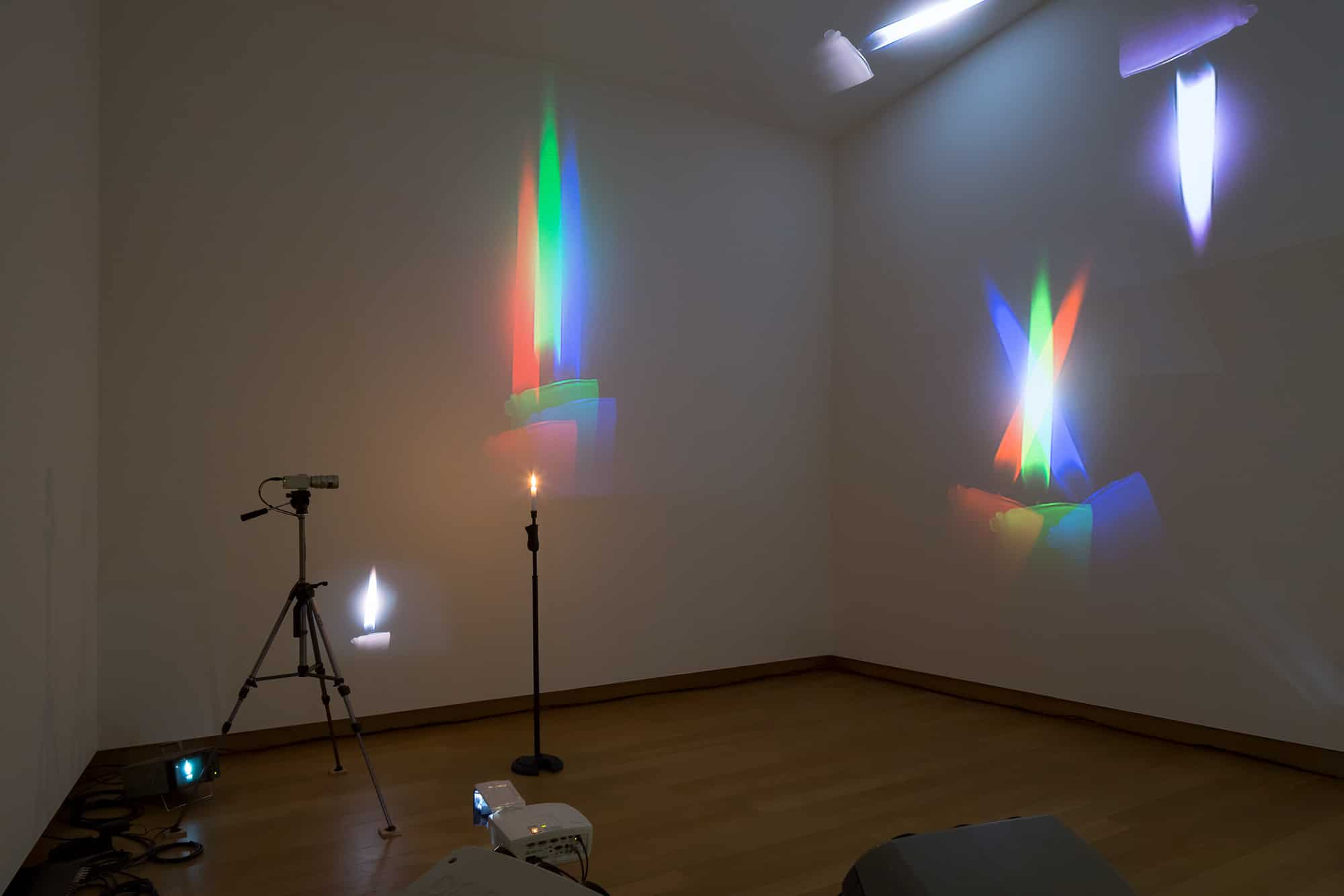
1989
Art
Presents a solo exhibition Eine Kerze/One Candle held at Portikus in Frankfurt, 21 January–12 March. The exhibition centres around a single candle and is one of the few installations using video projection: a single candle is filmed by two cameras and projected to the walls by several projectors in the television colours blue, red and green. The room is filled with live, overlapping candles appearing in different colour-mixtures.
Participate in the group exhibition Video-Skulptur retrospektiv und aktuell 1963–89 (Video Sculpture: Retrospective and New Works 1963–89) held at Kunstverein in Cologne, 18 March–23 April. It later travels to Kongresshalle in Berlin, and Kunsthaus in Zürich.
Presents a solo exhibition Nam June Paik held at Museo de Bellas Artes de Bilbao, 11 April–30 May.
Participates in the 1989 Biennial Exhibition at the Whitney Museum of American Art in New York, 18 April–16 July.
Presents a solo exhibition Nam June Paik: La Fée électronique (Nam June Paik: The Electronic Fairy) held at Musée d’Art Moderne de la Ville de Paris, 28 April–31 October. It later travels to Galerie du Génie and Galerie de Paris in Paris, Mayor Rowan Gallery in London, Galerie Juana Mordo in Madrid and Weisses Haus in Hamburg.
Participates in the group exhibition Commissioned Work “Theme Hiroshima” held at Hiroshima City Museum of Contemporary Art, 3 May–20 August.
Participates in the group exhibition Magiciens de la Terre (Magicians of the Earth) held at Musée national d’art modern in Paris, 18 May–14 August.
Participates in the group exhibition Happenings & Fluxus held at Galerie 1900–2000 in Paris, 7 June–29 July.
Presents a solo exhibition Nam June Paik: The Family of Robot held at Fukuoka Art Museum, 27 June–16 July.
Presents a solo exhibition Nam June Paik held at the San Francisco Museum of Modern Art, 13 July–3 September.
Presents a solo exhibition Nam June Paik: Recent Paintings and Sculpture held at Holly Solomon Gallery in New York, 1–25 November.
Presents a solo exhibition at Arte Ederren Bilbao Museo and Museo de Bellas Artes de Bilbao in Madrid, Galerie Juana Mordo in Madrid and Holly Solomon Gallery in New York.
Participates in the group exhibition Image World: Art and Media Culture held at the Whitney Museum of American Art in New York, 8 November–18 February 1990.
Participates in the group exhibition Images du Futur 1989 (Images of the Future 1989) held at Cité des Arts et des Nouvelles Technologies de Montreal.
Participates in the group exhibition The New York Urban Landscape held at Battery Park in New York.
Participates in the group exhibition Prospect in Frankfurt.
1989
Art
Christine van Assche’s interview with Paik, “Nam June Paik,” is published in Galeries Magazine in its June/July issue and Raymond Bellour’s interview with Paik, “Nam June Paik: le genie cathodique” (Nam June Paik: The Cathodic Genius), is published in the periodical Beaux arts (Fine Art) in its July/August issue.
Art Press publishes Paik’s article, “La Vie, Satellites, One Meeting-One Life,” in its November issue.
Edith Decker-Phillips publishes her book Paik Video in Cologne. It is later reprinted in English with translation by Station Hill Arts in 1998.
1990s
1990
World
Nelson Mandela is released from prison on 11 February after being imprisoned for nearly three decades. After his release, he delivers a speech promising to establish peace between all races in South Africa.
After over a century of separation, South and North Yemen are unified to form the Republic of Yemen on 22 May.
The Berlin Wall commences demolition in June. West and East Germany are officially reunified in October.
1990
World
The Human Genome Project commences its 13-year journey. It is a public-funded project aiming to sequence the DNA of a whole euchromatic human genome.
1990
World
GUI-based internet instant messaging begins to take off with PowWow, ICQ and AOL Instant Messenger. This paves the way for later systems such as MSN in 1995, the introduction of video-based instant calls by Skype in 2003, the portal BlackBerry Messenger in 2005 and WhatsApp in 2009.
1990
Art
Creates Miami and Wing, a permanent indoor sculpture dedicated on 29 November at Miami International Airport.
Creates public sculpture Pre-Bell Man for the Deutsches Post Museum in Frankfurt.
Creates Video Arbor, a permanent outdoor installation at One Franklin Town Apartments in Philadelphia.
1990
Art
Presents a solo exhibition Nam June Paik: TV held at Galerie Marika Malacorda in Geneva, 8 February–31 March.
Presents a solo exhibition Nam June Paik held at Chiostri di San Domenico in Reggio Emilia, 17 February–11 March.
Participates in the group exhibition GegenwartEwigkeit: Spuren des Transzendenten in der Kunsst unserer Zeit (Presence and Eternity: Traces of the Transcendent in the Art of our Time) held at Martin-Gropius-Bau in Berlin, 7 April–24 June.
Participates in the Eighth Biennale of Sydney: The Readmade Boomerang, Certain Relations in Twentieth Century Art in Sydney, 11 April–3 June.
Presents a solo exhibition Nam June Paik: Sterne held at Galerie Hans Meyer in Düsseldorf, 20 September–20 October.
Presents a solo exhibition Grafiken und Multiples (Graphics and Multiples) held at Galerie Lüpke in Frankfurt, 1 December–12 January 1991.
Presents a solo exhibition held at Galerie Van de Vedle in Antwerp.
Presents a solo exhibition held at Galerie Maurice Keitelman in Brussels.
Presents a solo exhibition held at Holly Solomon Gallery in New York.
Presents a solo exhibition Benjamin Franklin held at The Franklin Institute, The Electrical Matter in Philadelphia.
Participates in the group exhibition The Technological Matter held at Katonoah Gallery in New York.
Participates in The Electrical Matter Festival held at The Painted Bride Art Center in Philadelphia.
1990
Art
Nicholas Zurbrugg’s interview with Paik, “nam june paik,” is published in eyeline in its spring/summer issue, Rosma Scuteri’s interview with Paik, “Nam June Paik Sono Nato Romantico: In Questo Mi Sento Differente Dal Cisimo Lirico Di Fluxus,” is published in Flash Art in its December/January issue and Mario Botta’s interview with Paik, “Encounter at WATARI-UM: Nam June Paik + Mario Botta,” is published in the book Mario Botta.
1991
World
The Gulf War begins in January after Iraqi President Saddam Hussein invades Kuwait and refuses to withdraw military power. US President George H. Bush authorises Operation Desert Storm shortly after to expel occupying Iraqi forces from Kuwait.
The USSR dissolves in December and the Russian Federation (formerly the Russian Soviet Federative Socialist Republic) is established shortly after.
1991
World
The Super Nintendo Entertainment makes its debut in North America.
1991
World
Apple and IBM create an alliance by signing an agreement with Motorola, Inc. to develop a next-generation RISC (reduced-instruction-set computing) chip, known as the PowerPC. They also launch two new software companies, Taligent, Inc. and Kaleida Labs, Inc., for the development of operating system software.
1991
Biography
Receives the Guggenheim Prize, the Rockefeller Foundation Prize, the American Foundation Institute Prize and the Skowhegan Medal for Video. Also receives the Kaiserring award which began in 1975 andisas given by the City of Goslar (Germany) to a distinguished international artist of modern and contemporary art.
1991
Art
Creates Chongro Cross to pay homage to both his traditional Korean roots as well as his late collaborator Joseph Beuys.
Creates Oil Drums, Hommage à Charlotte Moorman in memory of the late Charlotte Moorman, following her untimely death after a long battle with cancer. The two metal barrels in the sculpture were used during Paik and Moorman’s rendition of Variations on a Theme by Saint-Saens.
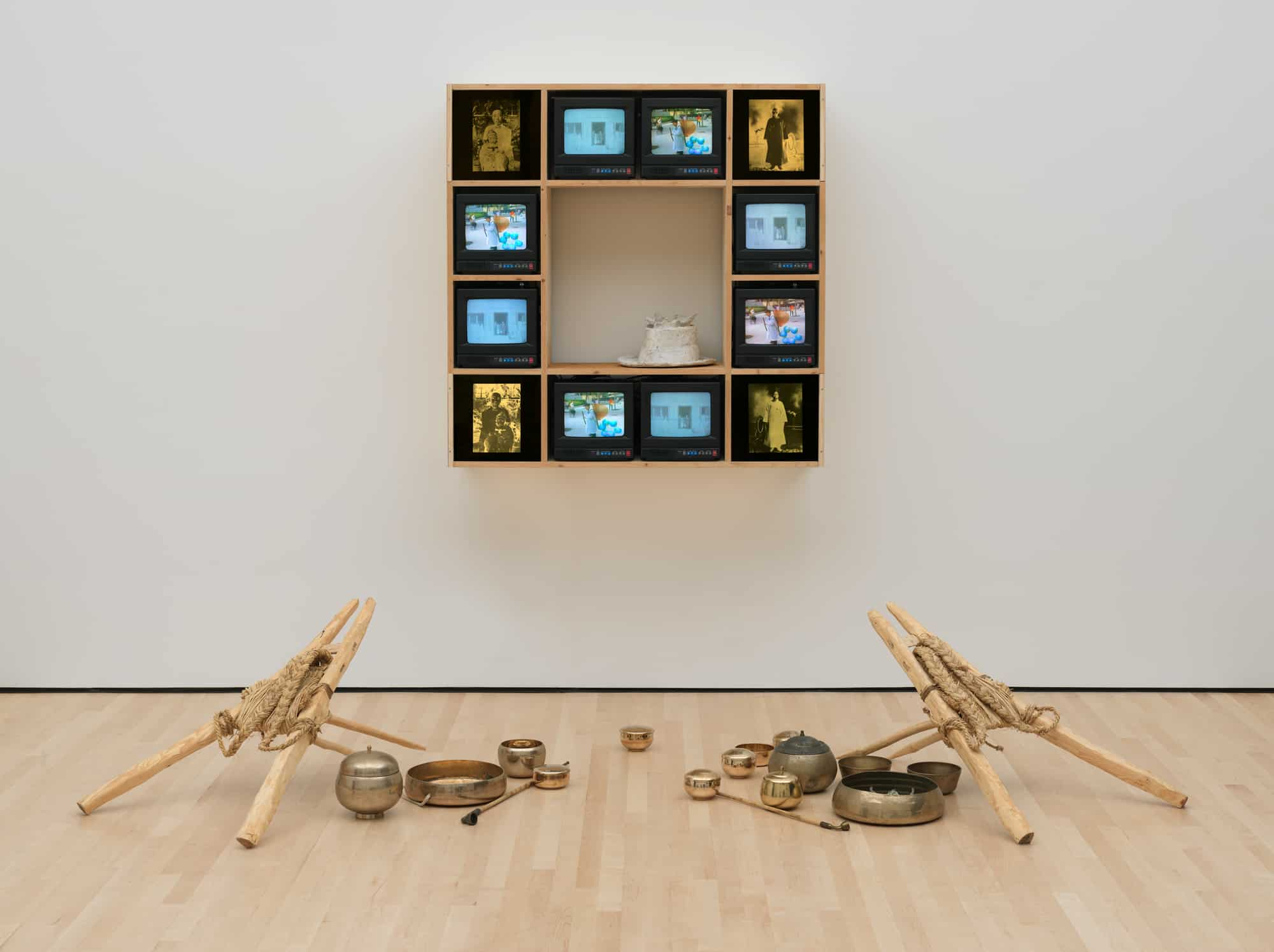
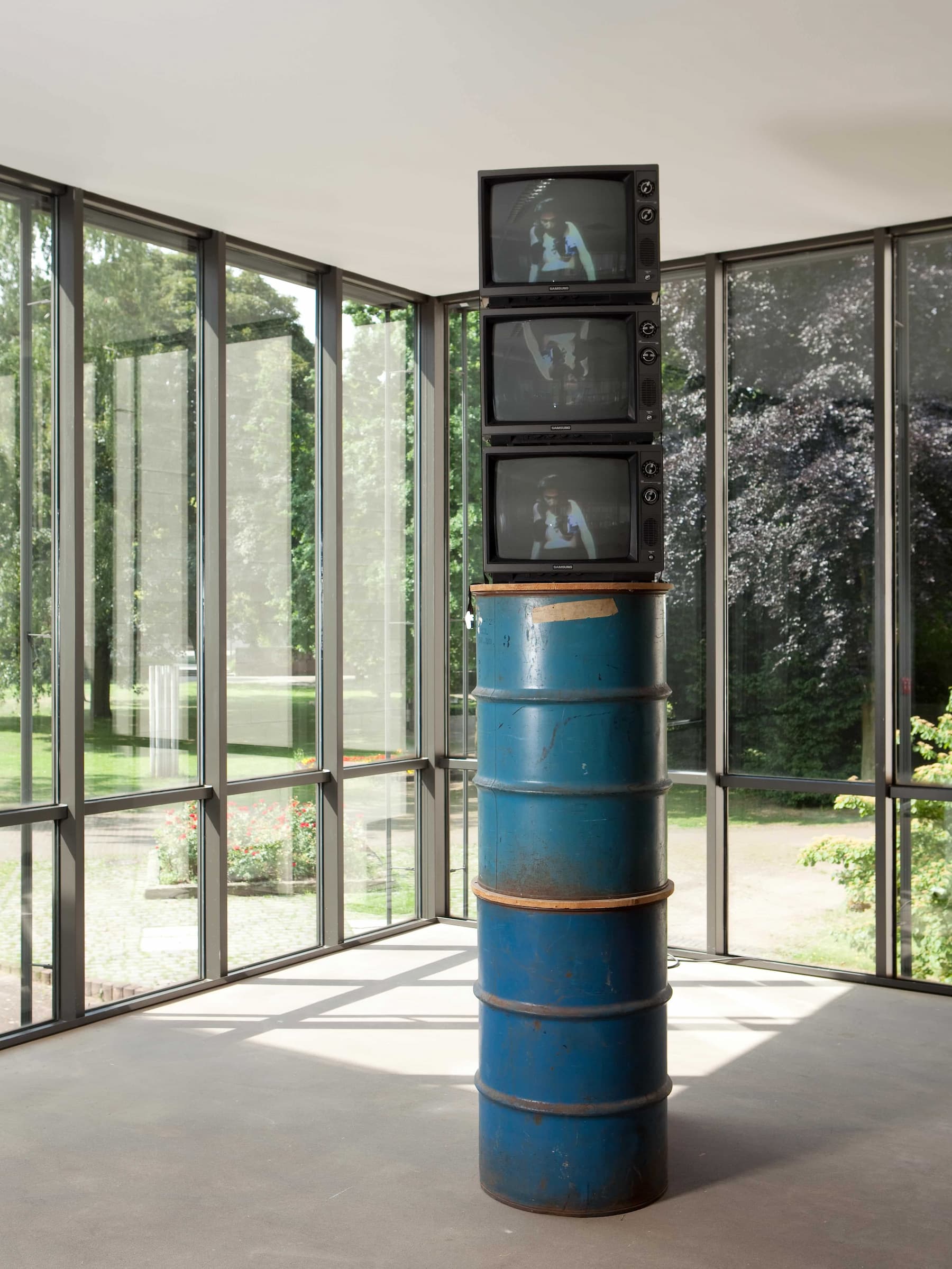
1991
Art
Presents a solo exhibition Nam June Paik held at Galerie Bendt und Krips in Cologne, 18 January–28 February.
Participates in the group exhibition I Love Art held at WATARI-UM, The Watari Museum of Contemporary Art in Tokyo, 2 March–19 May.
Presents a solo exhibition A Pas de Loup: de Séoul à Budapest held at Gallery Hyundai in Seoul, 30 July–20 August.
Presents a solo exhibition Video Time—Video Space held at Kunsthalle in Basel, 15 August–27 October. It later travels to Kunsthaus in Zürich, 16 August–6 October; Kunsthalle in Düsseldorf, 30 November–12 January 1992; Museum des 20 Jahrhunderts in Vienna, 27 February–12 April 1992 and the National Museum of Modern and Contemporary Art in Gwacheon, summer of 1992.
Presents a solo exhibition Nam June Paik: Video Sculpture held at The Mayor Gallery in London, 25 November–15 January 1992.
Presents a solo exhibition Recent Video Sculptures held at Carl Solway Gallery in Cincinnati.
Participates in ARCO Madrid art fair.
Participates in the International Art Exposition in Chicago.
Participates in the group exhibition Neon-TV|Video-Objekte held at Galerie Lupke in Frankfurt.
1991
Art
An interview of Nam June Paik, “Sohm Decided to Collect ONLY Information on Art and Not ART Itself,” is published in Liber maister. Hanns Sohm zum siebzigsten Geburtstag (Hans Sohm on his Seventieth Birthday).
Dieter Daniels’ interview with Paik, “Fluxus and mehr” (Fluxus and More) is published in the magazine Kunstforum International in its September/October issue, Thomas Kellein and Toni Stooss’ interview with Paik is published in the exhibition catalogue Video Time—Video.
1992
World
Afghanistan’s civil war begins in March.
Black Wednesday occurs in the UK on 16 September. The British withdraw the pound sterling from the European Exchange Rate Mechanism after failing to keep it above its agreed lower limit.
1992
World
Optical amplification is used in the fourth generation of fibre optic communication systems to minimise the demand for repeaters and enhance data capacity. These two enhancements spark a revolution, resulting in the system’s capacity increasing every six months indefinitely.
1992
Biography
Spends the summer (30 July–6 September) in Seoul.
Spends 16 August with well-known Korean philosopher Doh-ol Kim Yong-ok who conducts an extensive interview with him. The interview transcript is later published in Kim’s book Theory of Shitao’s Paintings in 2001.
Receives the Picasso Medal from UNESCO jointly with Karlheinz Stockhausen. UNESCO awards this prize to individuals or groups in recognition of an outstanding contribution to the arts or culture.
1992
Art
Creates Smiling Buddha (Buddha Looking at Old Candle TV) for the group exhibition Travelling the World—Art from Germany.
Collaborates with Paul Garrin on the video work A Tale of Two Cities.
1992
Art
Presents a solo exhibition Nam June Paik: Neue Arbeiten held at Galerie Hans Mayer in Düsseldorf, 15 January–29 February.
Participates in the group exhibition Travelling the World—Art from Germany (11 March–12 April) held at the Palace of Art in Minsk, 11 March–12 April.
Participates in the group exhibition Territorium Artis (Territory of Art) held at Kunst-und Ausstellungshalle der Nundersreublik Deutschland in Bonn, 19 June–20 September.
Presents a solo exhibition Nam June Paik: Recent Works ‘88a–’92 held at Hyundai Gallery in Seoul, 30 July–20 August.
Participates in the group exhibition Nam June Paik: Video and Paper with Allen Ginsberg held at Gallery Meegun in Seoul, 31 July–3 September.
Presents a solo exhibition Nam June Paik: Photographs held at Holly Solomon Gallery in New York, 8 October–21 November.
Presents a solo exhibition II Novecento di Nam June Paik: Arti elettroniche, cinema e media verso il XXI secolo held at Palazzo delle Esposizioni in Rome, 9–29 November.
Has his first major retrospective exhibition in Asia, Nam June Paik: Video Time, Video Space, held at the National Museum of Modern and Contemporary Art, Gwacheon.
Presents a solo exhibition Electronic Symbio-Phonics for Phoenix held at American West Arena in Phoenix. The work is a permanent outdoor installation and part of the Public Art Commission.
Presents a solo exhibition The Chase Information Wall held at Chase MetroTech Center in Brooklyn. The work is part of the Public Art Commission.
Presents a solo exhibition Eco-Lumbus and Rocketship to Virtual Venus held at the Seville World Expo in the Korean Pavililion.
Presents a solo exhibition Nam June Paik: Retrospective held at Mues des 20. Jahrhunderts in Vienna.
Participates in the group exhibition FLUXUS in Wiesbaden 1992 held at Bellevue-Saal, Bücherglide Gutenberg, ESWE-Hochhaus, Fluxeum, Kunsthaus, Nassauischer, Kunstverein, Rathaus, Villa Clementine and Wienerwald in Wiesbaden.
1992
Art
A compilation of Paik’s manuscripts put together by Paik and Edith Decker-Philips is published in the book Niederschriften eines Kulturnomaden: Aphorismen, Briefe, Texte (Writings of a Cultural Nomad: Aphorisms, Letters, Texts).
The Seoul-based periodical Wolgan Misool (The Monthly Art Magazine) publishes Paik’s piece “Video Art—Never-Ending Project” in its August issue. That same month, an interview with Paik, “Interview with Nam June Paik: ‘My Favorite Work is TV Garden,’” is also published.
Multiple interviews with Paik are published: Heinz Thiel’s “Ein Schlitzohr als Weiser” (A Rascal as a Sage) in neue bildende kunst (New Visual Art), Jean Yves Bosseur’s “Nam June Paik” in Le Sonore Et Le Visuel (The Sound and the Visual), Otto Hahn’s “Nam June Paik” in Nam June Paik and Irmeline Lebeer’s “Entretien avec Nam June Paik” (Interview with Nam June Paik) in Galeria Marika Malacorda.
1993
World
A terrorist bomb is detonated in the basement car park of the World Trade Center in New York on 26 February. It claims 6 lives and injures over 1,000 people.
1993
World
Chen Kaige’s historical drama Farewell My Concubine is released, and becomes the first Chinese-language film to win the Golden Globe Awards for Best Foreign Language Film the following year.
1993
Art
Creates works for the German Pavilion at the Venice Biennale, including: The Rehabilitation of Genghis-Khan, Marco Polo, Tangun as Scythian King, Anonymous Crimean Tatar who Saved Life of Joseph Beuys, Electronic Superhighway, Phasen-Verschiebung, Sistine Chapel Before Restoration.
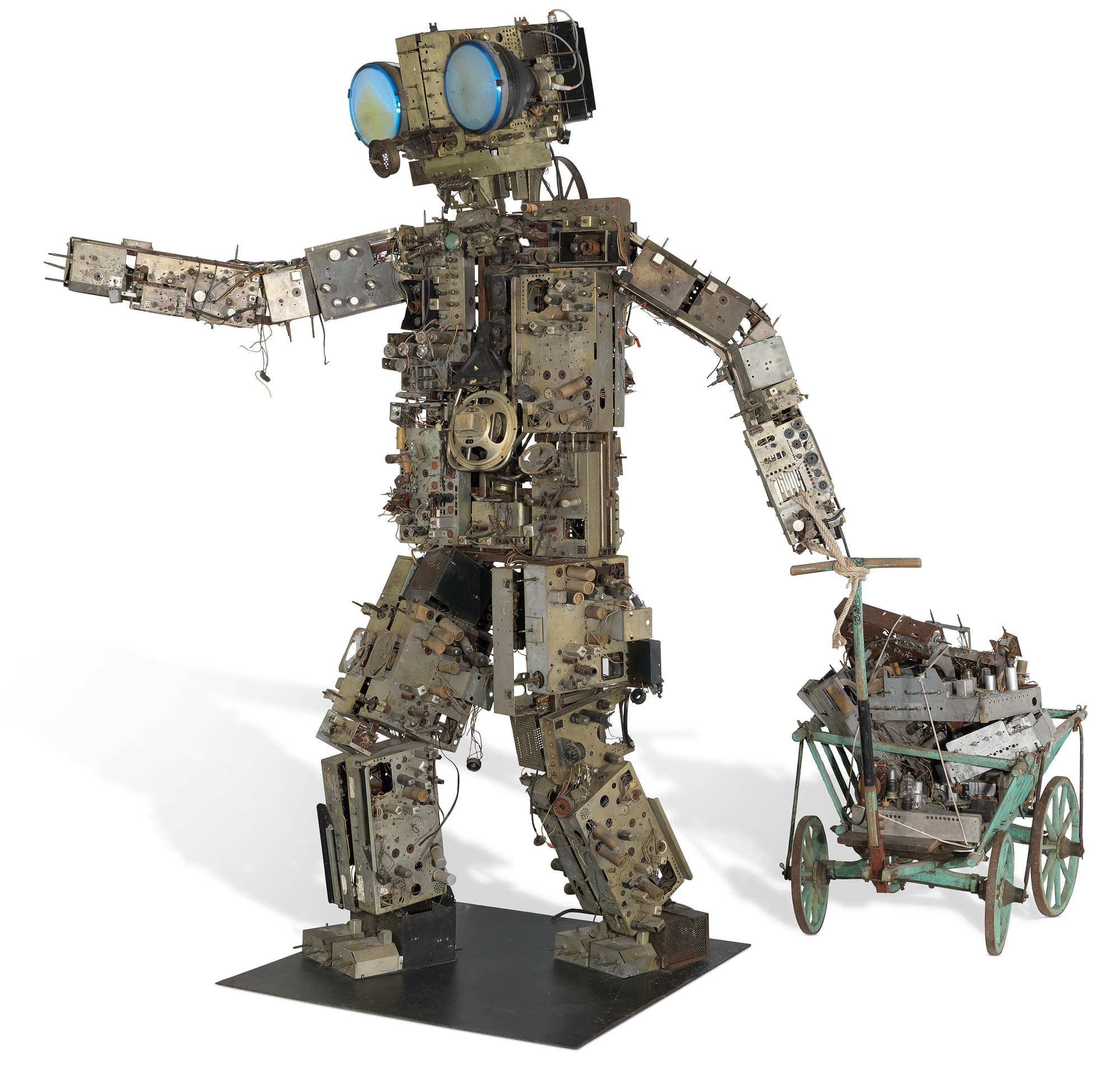
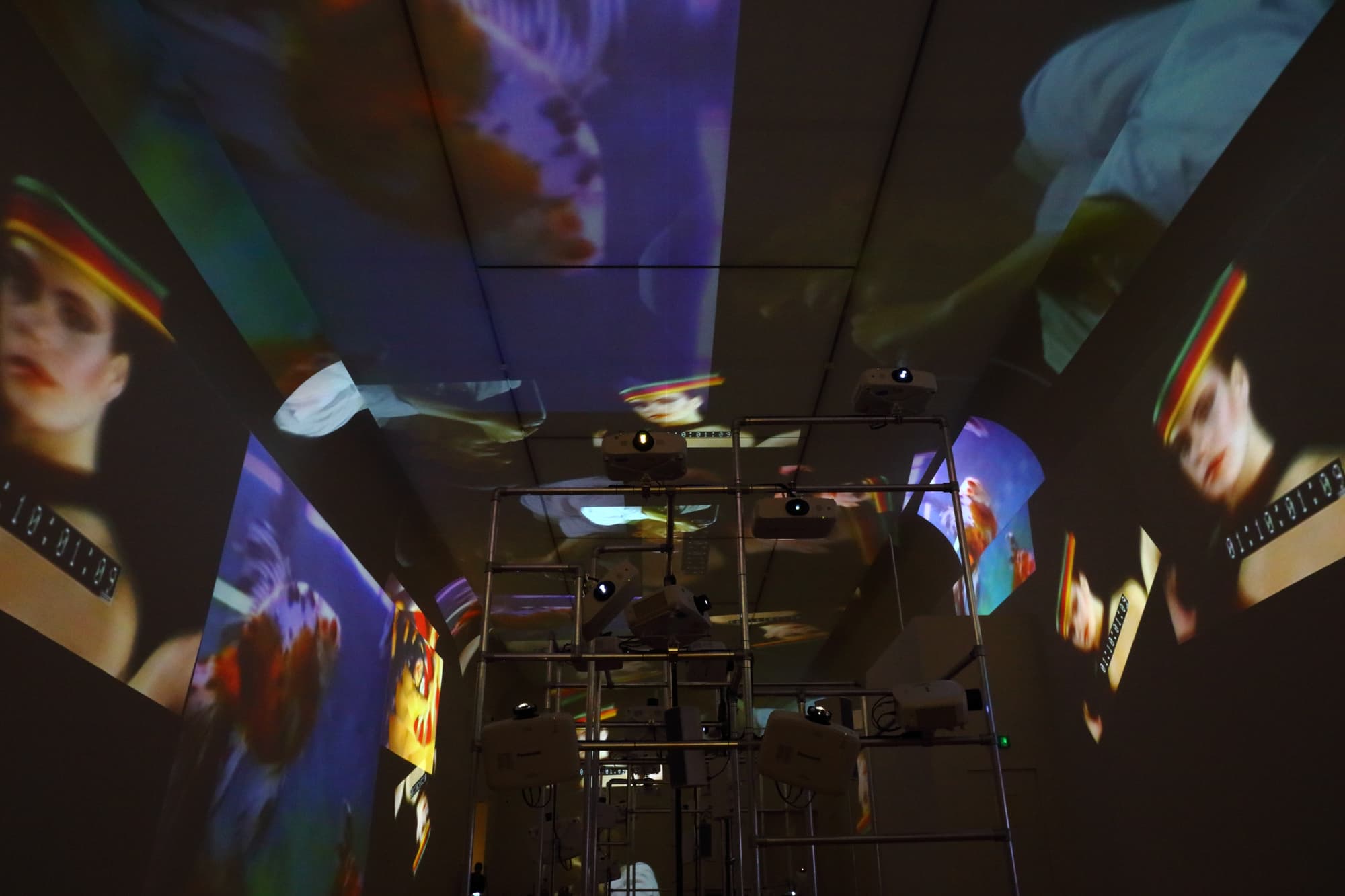
1993
Art
Participates in the group exhibition Mediale (Media) held at Deichtorhallen in Hamburg, 5 February–28 March.
Participates in the group exhibition In the Spirit of Fluxus held at the Walker Art Center in Minneapolis, 14 February–6 June.
Presents a solo exhibition The Rehearsal for the Venice Biennale | The German Pavilion held at Holly Solomon Gallery in New York, 3 April–8 May.
Presents a solo exhibition Jardin Illumine (Illuminated Garden) held at Sammlung Hauser & Wirth in Zurich, 1 May–3 July.
Presents a solo exhibition TV Bed, Fish TV, Egg Grows, Beuys Vox, Darwin, Videochandeliers ’91, Neptun held at Weisser Raum in Hamburg, 14 May–3 July.
Represents Germany in the 45th Venice Biennale alongside Hans Haacke, and titles his portion of the exhibition Electronic Super Highway “Venice → Ulan Bator.” The Biennale is held from 13 June–13 October. The German Pavilion receives first prize and the commissioner for the Pavilion, Klaus Bussmann, calls Paik an Ehren-Gast-Arbeiter or honorable foreign worker of the Federal Republic of Germany.
Participates in the group exhibition Neither East not West: Seven Contemporary New York Artists held at Taipei Gallery, 2–30 July.
Presents a solo exhibition Nam June Paik Recent Works: Paik Chikyuron held at WATARI-UM, The Watari Museum of Contemporary Art in Tokyo, 8 September–30 December.
Participates in ARCO Madrid art fair.
Participates in the group exhibition held at Art Miami.
Participates in the group exhibition held at Art Dealers Association of America, New York.
Participates in the group exhibition held at Taejon Exposition.
1993
Art
Kyunghyang Shinmun (Kyunghyang News), a daily newspaper in Seoul, publishes Paik’s op-ed article on 25 August.
Edition Cantz publishes Paik’s essay in Eine DATA Base.
Multiple interviews with Paik are published: Edith Decker-Phillips and Irmeline Lebeer’s interview in Nam June Paik: Du Cheval á Christo et autres écrits, Pierre Restany’s “XLV Biennlae di Venezia” (45th Venice Biennale) in D’Ars in its summer issue, Tetsuo Kogawa’s “Capitalism Is in Need of Artists: Exhibition of Nam June Paik” in Bijutsu techo in its December issue, and “Guru Electronic” in MASP (Musee de Arte de São Paulo).
1994
World
On 10 May, Nelson Mandela becomes the first black president of South Africa.
1994
World
The sitcom Friends, created by David Crane and Marta Kauffman, premieres on 22 September and continues to air on NBC until 5 May 2004.
Cambodia-born French filmmaker Rithy Panh’s first feature film, Rice People, premieres at the Cannes Film Festival.
1994
World
Netscape Navigator is released and becomes the first commercially available web browser.
Jeff Bezos founds Amazon.com Inc.
Jerry Yang and David Filo found Yahoo!.
Apple debuts the Power Macintosh 6100, the company’s first computer to employ the PowerPC Processor jointly made by IBM and Motorola.
1994
Art
Performs An Evening with Nam June Paik in Tribute to Cage at The Kitchen, Mercer Arts Center in New York on 28 April as part of Citycircus. Citycircus was citywide series of events programmed in conjunction with the exhibition Rolywholyover A Circus held at the Solomon R. Guggenheim Museum in New York, 23 April–7 August.
Performs Video Opera: Beuys Paik Duet + 10 1994 with Boredoms, Simone Forti, Takehisa Kosugi and Yukihiro Isso at Sogetsu Hall in Tokyo.
1994
Art
Creates Internet Dream, a video wall comprising a complex arrangement of television sets. The work points to Paik’s prediction of a global information network during a time of increased accessibility to the internet, as it was evolving to become a public commodity.
1994
Art
Participates in the group exhibition Home Video Redefined: Media, Sculpture, and Domesticity held at the Center of Contemporary Art in Miami, 3 February–12 March.
Participates in the group exhibition Japanese Art after 1945: Scream against the Sky held at Yokohama Museum of Art, 30 February–30 March.
Presents a solo exhibition Nam June Paik: Lo Sciamano del Video (Nam June Paik: The Shaman of Video) held at Arengario at the Palazzo Reale in Milan, 3 June–9 October.
Participates in the group exhibition The Howard Wise Gallery: TV As a Creative Medium, 1969 held at the Whitney Museum of American Art in New York, 8 June–7 August.
Participates in the group exhibition Fluxus held at Kunsthalle in Basel, 21 August–31 October. It later travels to the Watari Museum of Contemporary Art in Tokyo, 29 November–12 March 1995.
Presents a solo exhibition Nam June Paik held at Fukuoka Art Museum, 30 August–23 October.
Presents a solo exhibition Electronic Super Highway: Nam June Paik in the 90’s held at Fort Lauderdale Museum of Art in Florida, 4 November 1994–15 January 1995. It later travels to the Indianapolis Museum of Art in Indiana, 18 February–16 April 1995; Columbus Museum of Art in Ohio, 11 June–17 September 1995; Pennsylvania Academy of the Fine Arts in Philadelphia, 28 October 1995–15 January 1996; San Jose Museum of Art in Texas, 7 February–5 May 1996; Museum of Contemporary Art San Diego, 10 June–19 September 1996; Caixa General de Depositors in Lisbon, 1 October–8 December 1996; Nelson-Atkins Museum of Art in Kansas City, 13 July–14 September 1997 and Honolulu Academy of Art, 6 November 1997–4 January 1998. The exhibition catalogue The Electronic Super Highway: Travels with Nam June Paik is published by Fort Lauderdale Museum of Art in 1997.
Presents a solo exhibition Nam June Paik: Recent Works held at Albert Benamou-Philippe Gravier in Paris 10 November–22 January 1995.
1995
World
The South Korean Pavilion debuts at the Venice Biennale. After Paik’s success at the 1993 Biennale as an artist of the German Pavilion, architect Kim Seok-cheol and Paik make efforts to build a South Korean Pavilion. They persuade the Mayor of Venice by suggesting an exhibition of two Koreas.
1995
World
Toy Story, the first feature film to employ only computer-generated imagery, is released.
1995
World
Pierre Omidyar founds eBay on 3 September.
Craig Alexander Newmark founds Craigslist, an American online communal network focused on offering free classified advertisements.
The First Browser War unfolds as a heated competition between Netscape Corporation and Microsoft, which results in the popularisation of Microsoft’s web browser Internet Explorer.
1995
Biography
Wins the Arts and Culture Prize of the Fukuoka Prize in the TV Hall of NHK Japan Broadcasting Station Fukuoka on 30 September.
Jud Yalkut releases the documentary The Electronic Super Highway: Nam June Paik in the Nineties.
Kunstmuseum Wolfsburg produces the documentary High Tech Allergy in German, recording Nam June Paik’s work in the late 20th century.
1995
Art
Performs Kikyorai with Sho Kazazkra, Takehisa Kosugi and Chiya Kuni in the TV Hall of NHK Japan Broadcasting Station Fukuoka on 30 September, when he wins the Arts and Culture Prize of the Fukuoka Prize.
1995
Art
Creates John Cage Robot II referencing Cage’s renowned composition 4’33”.
Creates new versions of works from the 1963 Wuppertal solo exhibition for the 1995 Lyon Biennale. Some of these were subsequently acquired by the Museum of Contemporary Art Lyon after the Biennale closed.
Collaborates with Howard Weinbert on the film “Topless Cellist” Charlotte Moorman.
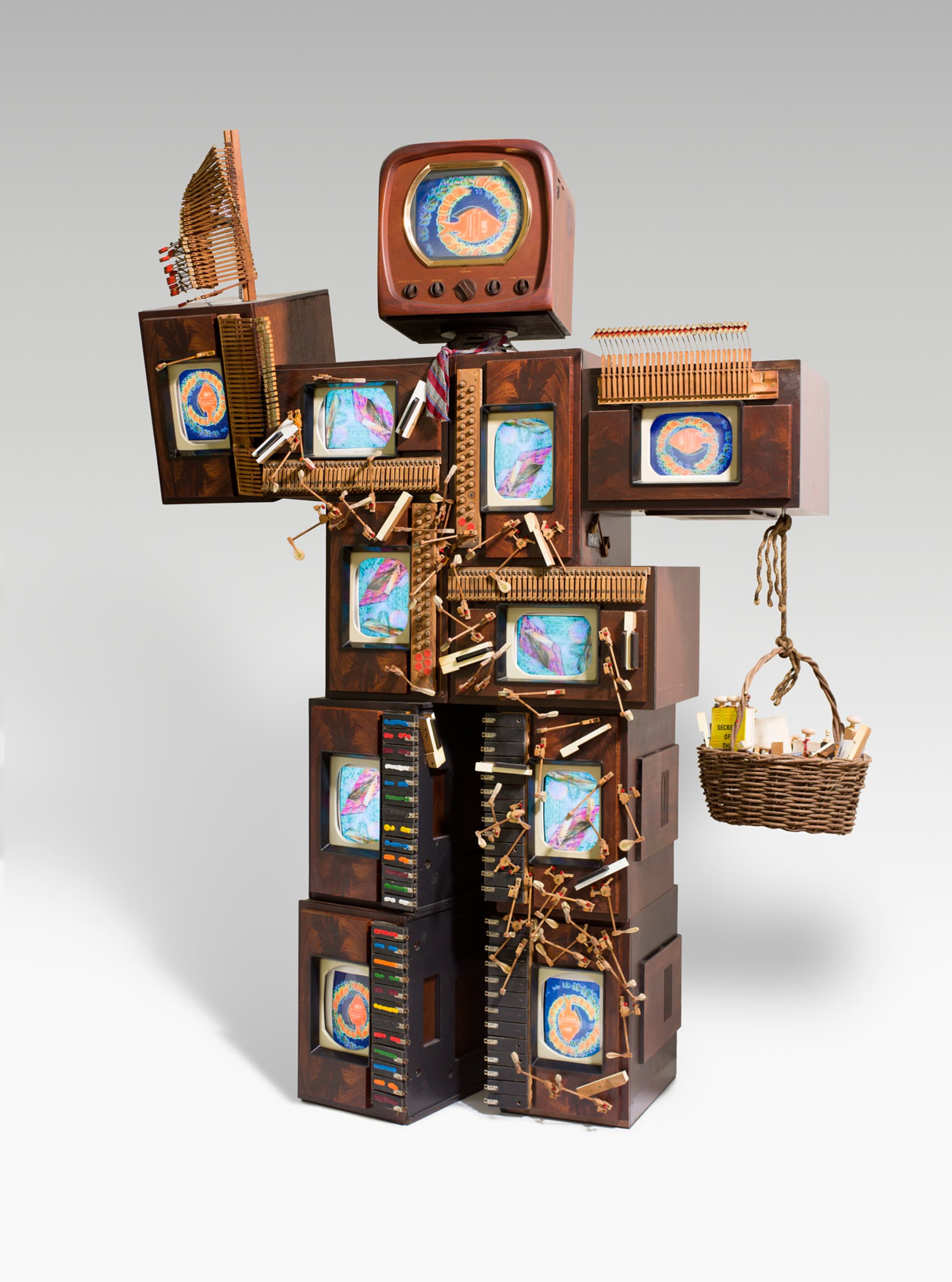
1995
Art
Presents a solo exhibition Electronic Superhighway held at Holly Solomon Gallery in New York, 29 April–3 June.
Participates in the group exhibition Eine lange Gescgichte mitvielin Knoten: Fluxus in Deutschland 1962–94 (A Long Story with Many Knots: Fluxus in Germany 1962–94) held at Orangerie and Bahnpost in Gera, 14 May–25 June.
Presents a solo exhibition Baroque Laser held at Mariae Himmelfahrt-Dyckburg in Münster-Sankt Mauritz, 25 June–6 August. It comprises a laser video installation that takes up the entire interior space of this Catholic church, and a book documenting this is published later in the year.
Presents a solo exhibition Nam June Paik: Videoveistoksia ja-installaatioita (Nam June Paik: Video Sculptures and Installations) held at Ars Nova in Turku, 1 July–10 September.
Presents a solo exhibition Nam June Paik ’95: Art and Communication held at Gallery Hyundai in Seoul, 12–24 September.
Participates in the first Gwangju Biennale: infoART ’95 at the Museum of Contemporary Art, 20 September–20 November.
Participates in the 4th Uluslararasi Istanbul bienal (4th International Istanbul Biennal), 10 November–10 December.
Presents a solo exhibition Nam June Paik—High Tech Allergy held at Kunstmuseum in Wolfsburg, 25 November–21 January 1996.
Participates in the 3rd Biennale de Lyon, 20 December–18 February 1996. In celebration of 100 years of cinema since the Lumière brothers, the Biennale retraces its short history, which started 30 years ago with the first experiments on a television set (Wuppertal, 1963) and now extends to interactivity and broadband. For the occasion, the Museum of Contemporary Art Lyon and the Biennale co-produce a collection of forgotten historical pieces by Nam June Paik, Vito Acconci, Dan Graham, Peter Campus and Dennis Oppenheim.
1995
Art
Multiple interviews with Paik are published: Hong-hee Kim’s “Interview with Nam June Paik: ‘Art Is Not an Olympic Game’” in Wolgan Misool in its January issue, Nicholas Zurbrugg’s “Nam June Paik: An interview” in Visible Language in its spring issue, Pierre Restany’s “Biennale 1995: Pierre Restany intervista…” in D’Ars in its August issue, and an interview in the book Nam June Paik.
1996
World
Khobar Towers in Saudi Arabia is bombed on 25 June 2, leading to 19 deaths and hundreds of injuries.
1996
World
The thriller Mission: Impossible, directed by Brian De Palma, is released.
Comrades, Almost a Love Story, Peter Chan’s bittersweet commentary on first-generation migrants moving from Chinese-speaking cities to New York, is released. Critics view this as a response to the American film The Joy Luck Club, released three years earlier.
1996
Biography
Suffers a stroke, which paralyses the left side of his body.
1996
Art
Creates countless drawings on paper.
1996
Art
Participates in the group exhibition Mixed Pixels: Nam June Paik Students, Video Dreams 1978–95 held at Kunstmuseum Düsseldorf, 5 April–5 May.
Presents a solo exhibition Documentation of Nam June Paik held at Canal City Hakata in Fukuoka, 27 April–26 May.
Participates in the group exhibition Mediascape held at the Solomon R. Guggenheim in New York, 14 June–26 October.
Participates in the group exhibition The World Over: Under Capricorn. Art in the Age of Globalisation held at Stedelijk Museum in Amsterdam, 29 June–18 August.
Participates in the group exhibition Klangkunst (Sound Art) held at Akademie der Künste in Berlin, 9 August–8 September.
Presents a solo exhibition Nam June Paik held at Asbaek Gallery in Copenhagen, 7 September–2 October.
Presents a solo exhibition Nam June Paik: Video Sculptures, Electronic Undercurrents held at Statens Museum for Kunst in Copenhagen, 7 September–30 November.
Participates in the first sonambiente in Berlin, as part of the 300th anniversary of the Akademie der Künste.
1996
Art
Rhee Jong-Soong’s interview with Paik, “PortaPaik,” is published in ART AsiaPacific.
1997
World
Princess Diana is killed in a car crash in Paris on 31 August.
Mother Teresa dies in Kolkata on 5 September.
1997
World
The first novel of the Harry Potter series by J. K. Rowling, Harry Potter and the Philosopher’s Stone, is released in the UK on 30 June.
Men in Black, the first of an American science fiction action film series, is released.
The film Titanic, directed, written, co-produced and co-edited by James Cameron, is released. It is currently the third highest-grossing film of all time.
1997
Biography
Stephen Vitello releases the documentary Nam June Paik: 2 Piano Concerts: 1994|95.
1997
Art
Performs the video-opera Coyote 3 at Seoul NyMax Anthology Film Archives in New York.
1997
Art
Creates 32 Cars for the 20th Century: Play Mozart’s Requiem Quietly for the 3rd Skulptur Projekte Münster (3rd Sculpture Projects Münster) in 1997.
Creates a series of robot drawings, such as Untitled (Robots with Videotape).
1997
Art
Participates in the group exhibition Die Epoche der Moderne. Kunst im 20. Jahrhundert (The Age of Modernism: Art in the 20th Century) held at Martin-Gropius-Bau in Berlin, 6 May–27 July.
Participates in the 3rd Skulptur Projekte Münster, 22 June–28 September.
Participates in the group exhibition Deep Storage. Arsenals of Memory, held at Haus der Kunst in Munich, 2 August–12 October. It later travels to later Neue Nationalgalerie in Berlin, Museum Kunst Palast in Düsseldorf, Kulturforum Potsdamer Platz in Berlin, PS1 MoMA in New York and Henry Art Gallery in Seattle.
Presents a solo exhibition held at Holly Solomon Gallery in New York.
Presents a solo exhibition Nam June Paik held at Bryon Cohen/Lennie Berkowitz Gallery for Contemporary Art in Kansas City.
1997
Art
An interview with Paik, Susan Sontag, Vytautas Landsbergies and Jonas Mekas, “On Liberation, Arts & Cultural Imperialism,” is published in Seoul NyMax Anthology Film Archives.
1998
World
Larry Page and Sergey Brin found Google Inc. in California on 4 September.
Apple launches the iMac to revive its consumer and educational market sales. With built-in high-speed networking capabilities, the iMac quickly becomes the all-time best-selling computer that year.
1998
World
Ringu, a Japanese horror film directed by Hideo Nakata, is released. A Hollywood remake The Ring is later released in 2002.
1998
Biography
Receives the Goethe Medal. The award is given annually by the Goethe-Institut honouring individuals who have performed outstanding service for the German language and international cultural relations.
Receives the Kyoto Prize. The award was created in collaboration with the Nobel Foundation in 1985 and is regarded by many as Japan’s version of the Nobel Prize. It is presented to individuals who have made significant contributions in the fields of science and technology, as well as the arts and philosophy.
Attends a State Dinner at the White House. His pants drop while he is shaking hands with Bill Clinton in the receiving line. This scene is captured by the world press and praised as the epitome of Fluxus events.
1998
Art
Creates Untitled (‘Seoul-NY Mar 1-3’).
1998
Art
Participates in the group exhibition Our of Actions: Between Performance and the Object, 1949–1979 held at The Geffen Contemporary at the Museum of Contemporary Art in Los Angeles, 8 February–10 May.
1998
Art
Jason Weiss’ interview with Paik, “Nam June Paik Interview,” is published in Ear Magazine in its September issue.
1999
World
On 12 February, Bill Clinton is impeached for lying under oath about his affair and obstructing justice. He becomes the second US president to be impeached.
The First Battle of Yeonpyeong—a naval skirmish between North and South Korea—takes place on 15 June.
1999
World
The science fiction-action film The Matrix, directed by Larry and Andy Wachowski, is released.
1999
Biography
Stephen Vitiello releases the documentary Nam June Paik: Seoul NyMax Performance 1997.
1999
Art
Creates Tiger Lives, a 45-minute film later broadcast internationally as part of PBS Millennium 2000 on 1 January 2000.
1999
Art
Participates in the group exhibition Fluxus in Amerika held at Rafael Vostell in Berlin, 30 January–20 March.
Participates in the group exhibition Geometrie als Gestalt: Strukluren der modernen Kunst, Von Albers bis Paik; Werke de Sammlung DaimlerChrysler (Geometry as Form: Structures of Modern Art, From Albers to Paik; Works from the DaimlerChrysler Collection) held at Nationalgalerie in Berlin, 30 April–11 July.
Participates in the group exhibition Das X X. Jahrhundert—Ein Jahrhundert Kunst in Deutschland (The 20th Century: A Century of Art in Germany) held at Hamburger Bahnhof in Berlin, 4 September–9 January 2000.
Participates in the group exhibition The American Century: Art and Culture, 1900–2000 (Part 2) held at the Whitney Museum of American Art in New York, 26 September–13 February 2000.
Presents a solo exhibition Nam June Paik: Fluxus|Video held at Kunsthalle Bremen, 14 November–23 January 2000.
Has a retrospective exhibition Nam June Paik: Fluxus/Video held at Kunstahalle Bremen.
1999
Art
Multiple interviews with Paik are published: Eiji Yamamori’s “The Role of an Artist Is To Present a Model for the Next Generation” in Asahi Shimbun (Asahi News) on 21 January, Mitsuhiro Takemura’s “An Interview with Nam June Paik: Sweet Religiosity Is Gonna Be Crucial for the 21st Century” in Intercommunication in its spring issue, Silke Müller’s “Nam June Paik” in Art Das Kunstmagazin in its December issue.
Kunsthalle Bremen includes Paik’s essay in the exhibition catalogue for Nam June Paik. Fluxus|Video.
2000s
2000
World
Sony debuts its PlayStation 2, a sixth-generation video game console, on 26 October in North America.
The superhero film X-Men, based on the Marvel comic, is released.
The cult Japanese film Battle Royale, directed by Kinji Fukasaku, is released. When the American science-fiction film The Hunger Games is later released in 2012, critics note the striking similarity between the two.
2000
World
Broadband internet access via cable, digital subscriber line, satellite and FTTx gradually begins to replace dial-up access in many parts of the world.
The term “wifi” is coined by the brand consultancy Interbrand Corporation.
2000
Art
Creates the short, coloured video Analogue Assemblange which is later broadcast on Reel New York, WNET/ Thirteen in New York on 6 June 2003.
2000
Art
Has a retrospective exhibition The Worlds of Nam June Paik held at the Solomon R. Guggenheim Museum in New York, 11 February–26 April. It later travels to Hoam Museum in Seoul.
Participates in the group exhibition Tempus Fugit: Time Flies held at The Nelson-Atkins Museum of Art in Kansas City, 15 February–31 December.
Participates in the group exhibition The New Frontier, Art and Television 1960–65 held at the Austin Museum of Art, 1 September–26 November.
Participates in the group exhibition Collecting Ideas: Works from the Polly and Mark Addison Collection held at Denver Art Museum in Colorado, 18 November–11 March 2001
2000
Art
Vera Stahl’s interview with Paik, “So wunderbar anartchisch” (So Wonderfully Anarchic), is published on Spiegel Kultur (Mirror Culture).
2001
World
Al-Qaeda launches the September 11 attacks on the World Trade Center in New York and the Pentagon in Washington DC, claiming almost 3,000 lives and triggering the US “War on Terror.”
2001
World
Microsoft releases Xbox, a sixth-generation video game console, in North America on 15 November.
Shrek, a computer-animated film directed by Andrew Adamson and Vicky Jenson, is released.
The Fellowship Of The Ring, Peter Jackson’s film adaptation of the first volume of J.R.R. Tolkien’s fantasy series The Lord of the Rings, is released.
Spirited Away, a surreal animation written by Hayao Miyazaki and produced by Studio Ghibli, is released. It is the most successful domestic release in Japan’s history. It also receives the Golden Bear award at the Berlin Film Festival in 2002 and Best Animation at the 75th Academy Awards in 2003.
2001
World
Larry Sanger and Jimmy Wales launch Wikipedia on 15 January.
2001
Biography
Receives the Wilhelm Lehmbruck Prize. The award is granted every five years to an artist who has played an outstanding role in the development of sculpture. It is conferred by the City of Duisburg and the Rhineland Regional Authority in Germany.
2001
Art
Completes the actualisation of Three Camera Participation/Participation TV.
2001
Art
Participates in the group exhibition L’arte elettronica, metamorfosi e metafore (Electronic Art, Metamorphosis and Metaphors) held at Galleria civica d’arte moderna in Ferrara, 24 June–2 September.
Presents a solo exhibition Over the Century held at Galerie Bhak in Seoul.
2001
Art
Multiple interviews with Paik are published: Joan Simon’s “interview nam june paik/ SOMETHING PACIFIC” in landmarks and Alice Kim’s “Coyotes and Wolves: An interview with Nam June Paik” in New Art Examiner in its April issue.
2002
World
Star Wars Episode II: Attack of the Clones and The Lord of the Rings: The Two Towers are released.
Japan and Korea co-host the 17th FIFA World Cup, with the games being played across both countries.
2002
Biography
The Nam June Paik Award is established. It is conferred by the Arts Foundation of North Rhine-Westphalia and also known as the NRW International Media Art Award. The award is granted every two years for outstanding electronic and digital artworks that take risks, cross cultural boundaries and take an interdisciplinary approach in the spirit of the pioneering artist Nam June Paik.
2002
Art
Participates in the group exhibition Les animaux sortent de la reserve (The Animals Leave the Reserve) held at Centre Georges Pompidou in Paris, 26 June–2 September.
Features prominently in the 4th Asia Pacific Triennial of Contemporary Art held at Queensland Art Gallery in Brisbane, 12 September–27 January 2003. He is positioned as a leading pioneer in Asian contemporary art alongside Yayoi Kusama and Lee Ufan.
Participates in the group exhibition Video Acts, Single Channel Works from the Collections of Pamela and Richard Kramlich and New Art Trust held at P.S.1 Contemporary Art Center (now known as MoMA PS1) in New York, 10 November–13 April 2003.
Presents a solo exhibition Nam June Paik, Fluxus und Video Skulptur (Nam June Paik: Fluxus and Video Sculpture) held at Wilhelm-Lehmbruck Museum in Duisburg.
Presents a solo exhibition Il giocoliere elettronico, Nam June Paik e l’invenzione della videoarte (The Electronic Wizard: Nam June Paik and the Invention of Video Art) held at Palazzo Cavour in Turin.
2003
World
Niklas Zennström and Janus Friis found Skype.
Tom Anderson and Chris DeWolfe found MySpace.
2003
Art
Presents a solo exhibition Nam June Paik: Drawings held at Mano Gallery in Seoul.
Participates in the group exhibition X-Screen, Film Installations and Actions in the 1960s and 1970s held at Museum Moderner Kunst Stiftung Ludwig in Vienna.
2004
World
Mark Zuckerberg, Eduardo Saverin, Andrew McCollum, Dustin Moskovitz and Chris Hughes found Facebook while students at Harvard University in Massachusetts.
The Second Browser War sparks off as new competition joins Microsoft’s Internet Explorer in the open market, including Firefox, Google Chrome and Safari. This second spate lasts more than a decade and ends in 2017 when Andreas Gal, then Chief Technology Officer at Mozilla, publicly states that Google Chrome wins with 60% worldwide usage.
2004
Art
Creates One Candle (also known as Candle TV), the first version of which he made in 1975. He revisits this concept numerous times throughout his artistic practice.
2004
Art
Presents a solo exhibition Nam June Paik: Global Groove held at the Deutsche Guggenheim in Berlin, 17 April–10 July. It celebrates Paik’s early video innovations made in Germany and the US during the 1960s and 1970s.
Participates in the group exhibition Sons et lumières, une histoire de son dans l’art du 20ème siècle (Sounds and Lights: A History of Sound in 20th-Centuiry Art) held at Centre Georges Pompidou in Paris, 22 September–3 January 2005.
Participates in the group exhibition Friedrich Christian Flick Collection held at Hamburger Bahnhof, Museum für Gegenwart in Berlin, 22 September–7 August 2005.
Participates in the group exhibition Central Station held at La Maison Rouge in Paris.
2005
World
Chad Hurley, Steve Chen and Jawed Karim found YouTube.
2005
World
Park Kwang-hyun’s Welcome to Dongmakgol is released and is critically acclaimed for imagining new possibilities for resolving the deeply-rooted hostilities between North and South Korea.
2005
Art
Creates Ommah, his last video sculpture. He incorporates his Korean cultural heritage by placing a traditional silk robe before a television set.
Creates Self-Portrait where he paints his name in English, Korean and Chinese on a television set. This appearance of painted marks on television sets echoes many of his other late works, with Self-Portrait being one of his last works.
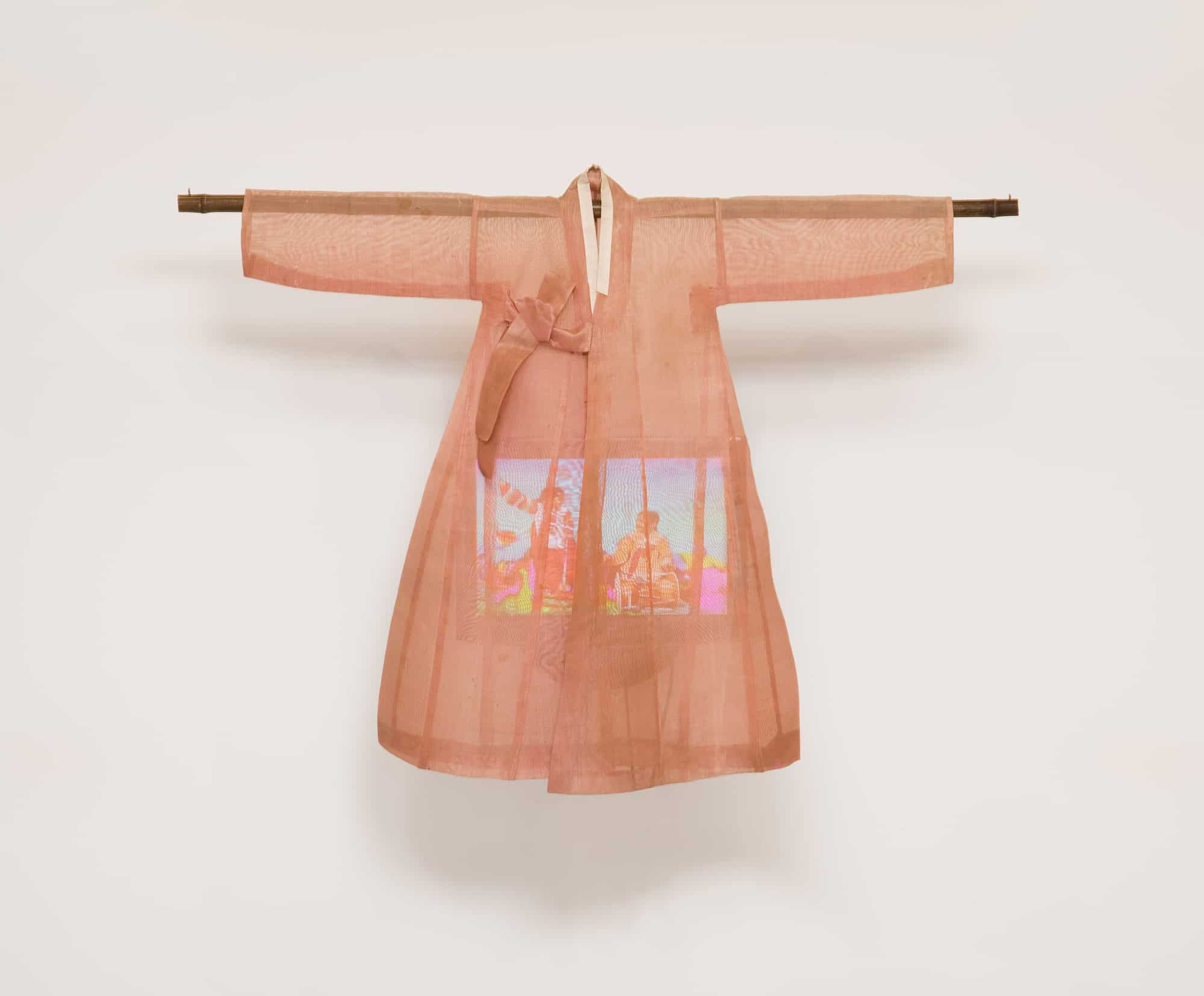
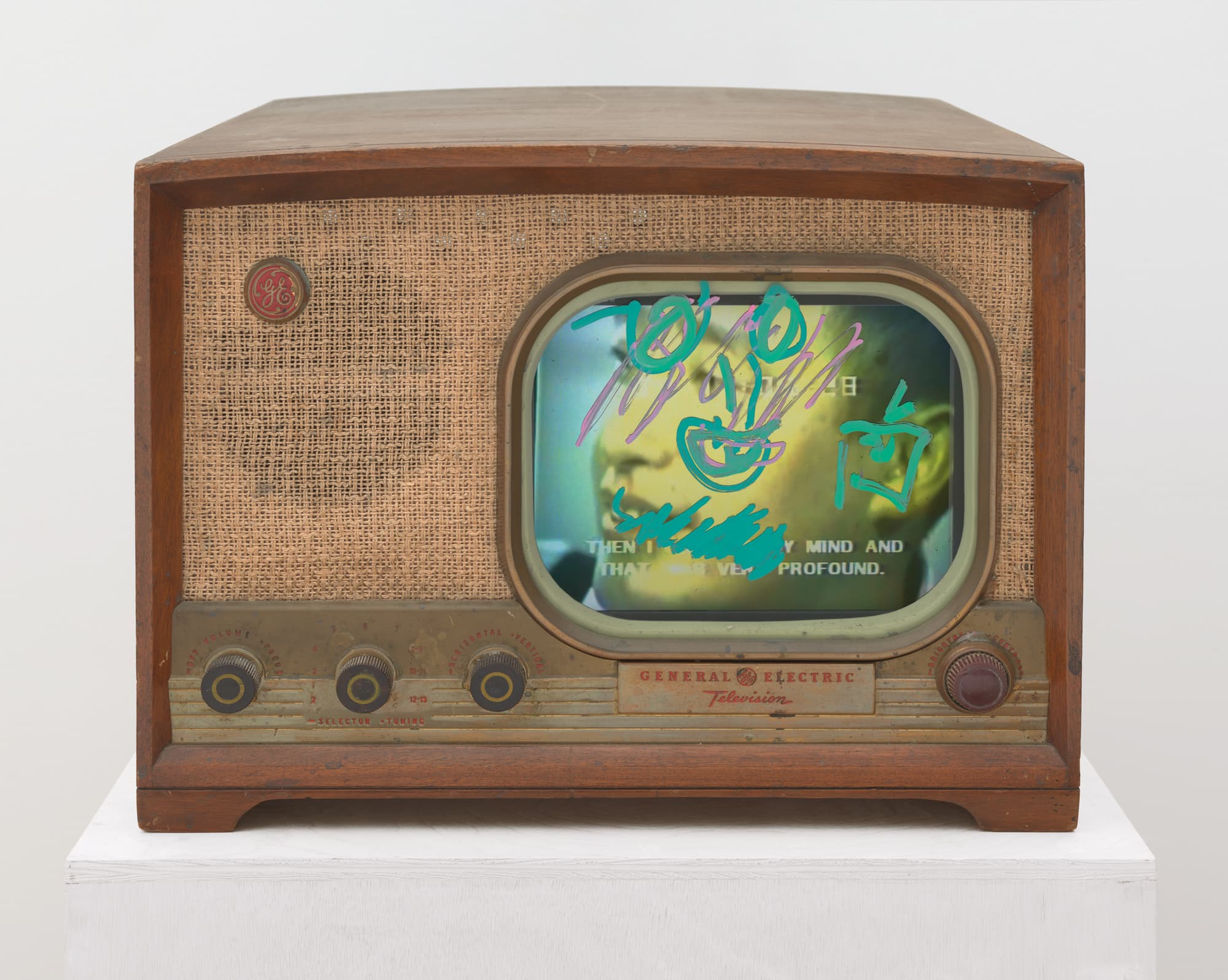
2005
Art
Participates in the group exhibition Sammlung 2005—Neupräsentation der erweiterten Sammlung (Collection 2005: New Presentation of the Extended Collection) held at K21 Kunstsammlung in Dusseldorf, 2 July–31 December.
Participates in the group exhibition Videographies, The Early Decades held at the National Museum of Contemporary Art in Athens, 13 July–4 September.
Participates in the group exhibition Paik and Beyond held at Art Cologne in Cologne, 28 October–1 November.
Participates in the group exhibition Superstars held at Kunsthalle Wien in Vienna, 4 November–22 February 2006.
Presents a solo exhibition Olympe de Gouges held at Musée d’art moderne de la Ville de Paris à la Maison de la Radio France.
2006
World
On 6 October, North Korea is recognised as the world’s eighth nuclear power after successfully completing its first atomic bomb test.
2006
World
Steve Jobs announces the MacBook Pro during his keynote address at the MacWorld conference in San Francisco on 14 February. The first MacBook is available for purchase by the public on 16 May.
2006
Biography
Passes away on 29 January in Miami, Florida. Around the world, commemorative film screenings and exhibitions take place.
- Bauermeister, Mary. Ich hänge im Triolengitter: Mein Leben mit Karlheinz Stockhausen (Hanging in a Triplet Grid: My Life with Karlheinz Stockhausen). Munich: Edition Elke Heidenreich bei C. Bertelsmann, 2011.
- Beevor, Lucy. The Invention of the Television. Minnesota: Capstone Press (Fact Finders Books), 2018.
- Center for Art and Media Karlsruhe (ZKM). “Nam June Paik.” Collection & Archives–People: https://zkm.de/en/person/nam-june-paik (accessed 2 December 2019).
- Christie, Clive J. Southeast Asia in the 20th Century: A Reader. London: Tauris, 1998.
- Fondazione Bonotto. “Kleinen Sommerfest: Apres John Cage” (‘A Small Summer Festival: After John Cage). Fondazione Bonotto: https://www.fondazionebonotto.org/cn/collection/fluxus/collectivefluxus/announcement/2429.html (accessed 2 December 2019).
- Gropius Bau. “1981 to 2000.” Programmes: https://www.berlinerfestspiele.de/en/gropiusbau/programm/2000/start.html (accessed 2 December 2019).
- Gruhn, Elke. “Fluxus is a Big Ship on Which to Take a Great Excursion.” Schirn Mag: https://www.schirn.de/en/magazine/context/2019/big_orchestra/fluxus_in_wiesbaden_big_orchestra/ (accessed 4 December 2019).
- Hanhardt, John G., Dieter Ronte & Michael Nyman et al. Nam June Paik. New York: Whitney Museum of American Art in association with W.W. Norton, 1982.
- Holcombe, Charles. A History of East Asia: From the Origins of Civilization to the Twenty-First Century. New York: Cambridge University Press, 2011.
- Korea Bizwire. “Paik Nam-June’s ‘The More the Better’ to Undergo Restoration.” Korea Bizwire: http://koreabizwire.com/paik-nam-junes-the-more-the-better-to-undergo-restoration/28774 (accessed 2 December 2019).
- Kunst Aspekte. “Deep Storage. Arsenale der Erinnerung.” Kunst Aspekte: International Exhibition Announcements and Exhibition Catalogue: https://kunstaspekte.art/event/deep-storage-arsenale-der-erinnerung-1997-08?hl=en (accessed 9 December 2019).
- Lee Sook-Kyung & Susanne Rennert, eds. Nam June Paik. London: Tate, 2010.
- Museum of Modern Art. “Program for Neo-Dada in der Musik.” Art and Artists: https://www.moma.org/collection/works/137675 (accessed 2 December 2019).
- Neuburger, Susanne & Museum Moderner Kunst Stiftung Ludwig Wien, eds. Nam June Paik: Exposition of Music, Electronic Television. Cologne: Verlag der Buchhandlung Walther König, 2009.
- Orwell, George. Nineteen Eighty-Four. London: Secker & Warburg, 1949.
- Paik, Nam June. Beuys Vox 1961/1986. Seoul: Won Gallery, 1986.
- Rothfuss, Joan. Topless Cellist: The Improbable Life of Charlotte Moorman. Massachusetts: MIT Press, 2014.
- Skulptur Projekte Archives. “Nam June Paik 1987.” Skulptur Projekte Archives (Sculpture Project Archives): https://www.skulptur-projekte-archiv.de/en-us/1987/projects/88/ (accessed 25 November 2019).
- _____. “Nam June Paik 1997.” Skulptur Projekte Archives (Sculpture Project Archives): https://www.skulptur-projekte-archiv.de/en-us/1997/projects/111/ (accessed 4 December 2019).
- somnambiente. festival für hören und sehen (Festival for Eyes and Ears): https://projekte.adk.de/sonambiente/home.htm (accessed 15 December 2019).
- Tokyo Metropolitan Museum of Art. Namu Jun Paiku ten: video āto o chūshin ni (Nam June Paik: Mostly Video). Tokyo: Tokyo Metropolitan Museum of Art, 1984.
- Yun, Michelle. Nam June Paik: Becoming Robot. New York: Asia Society, 2014.